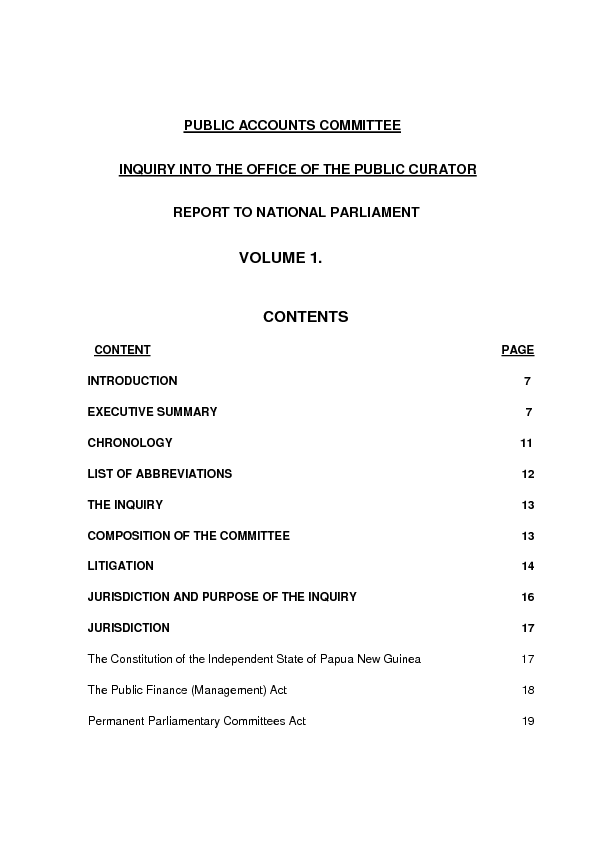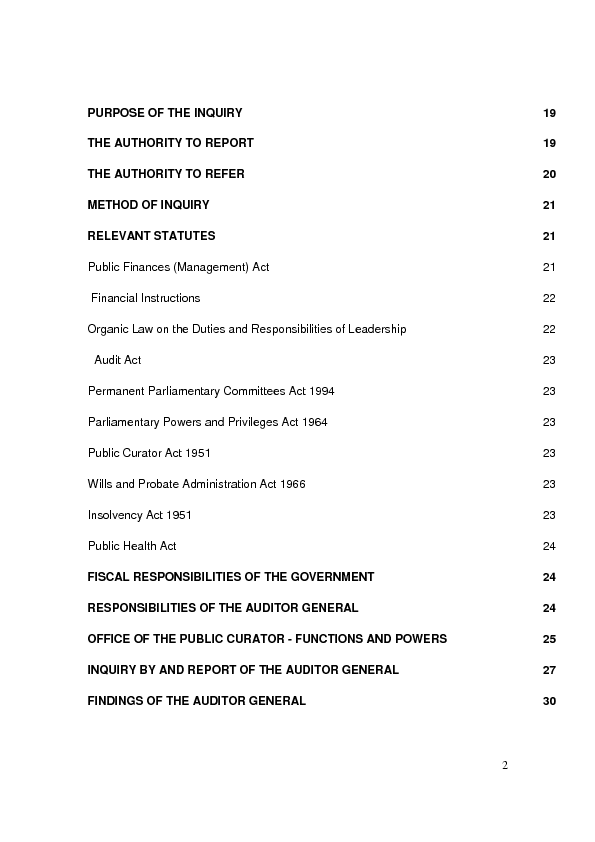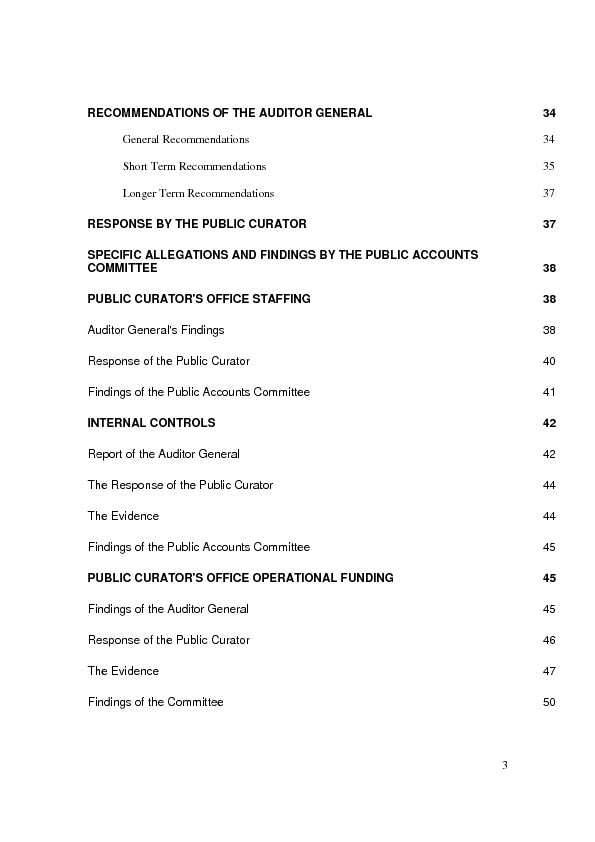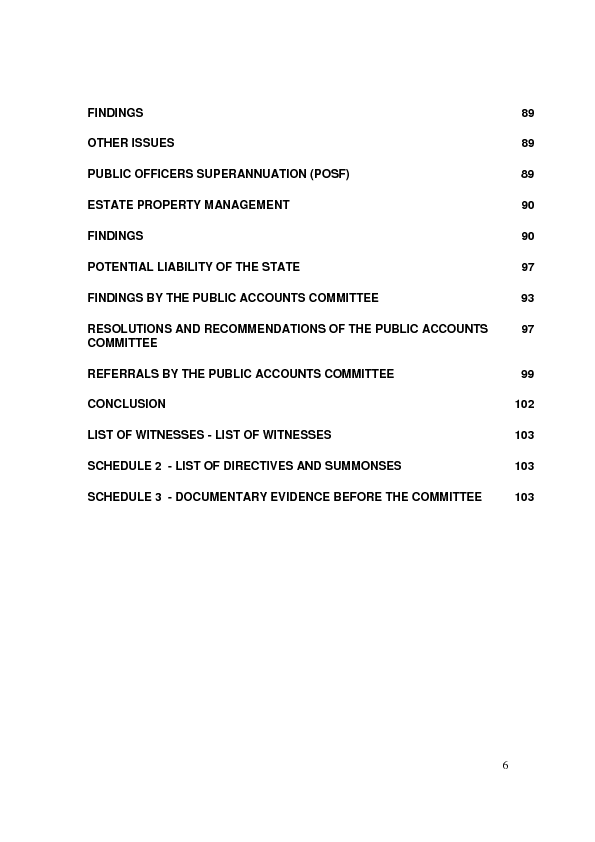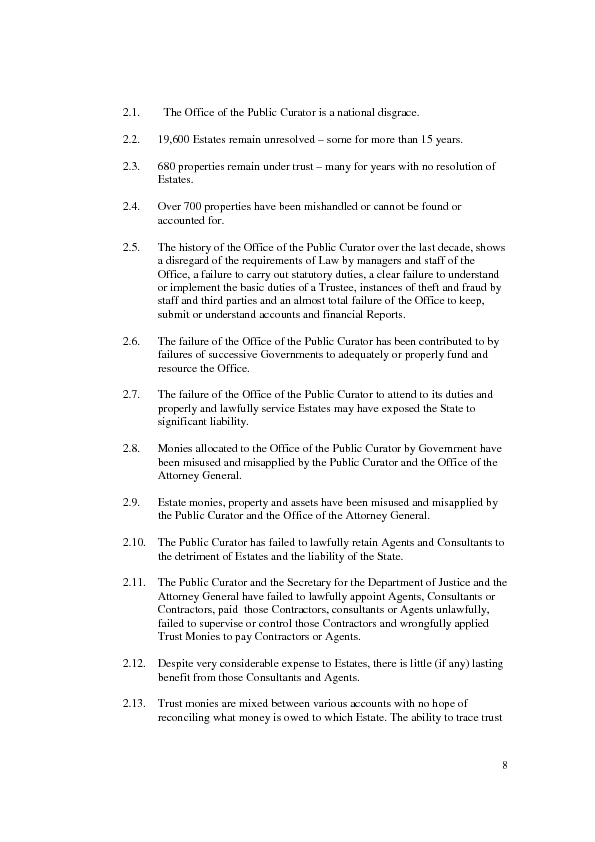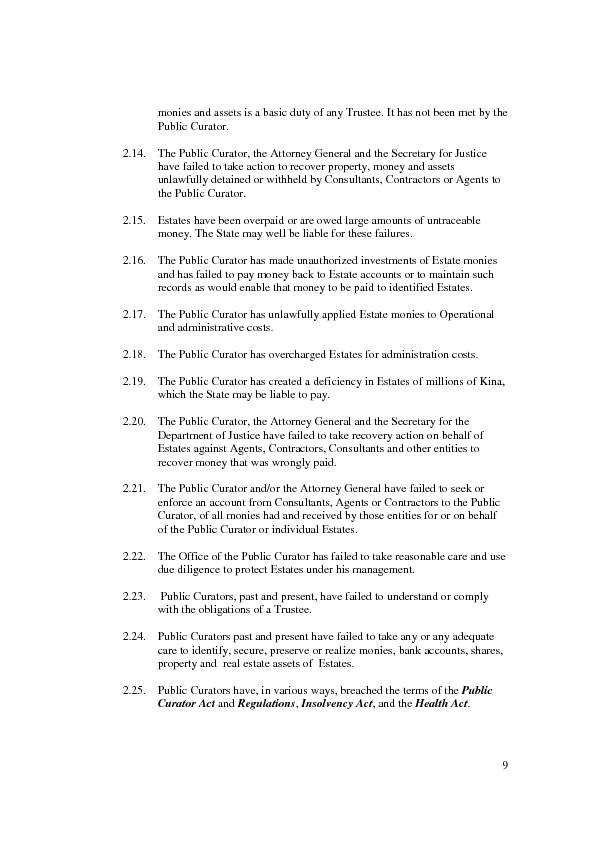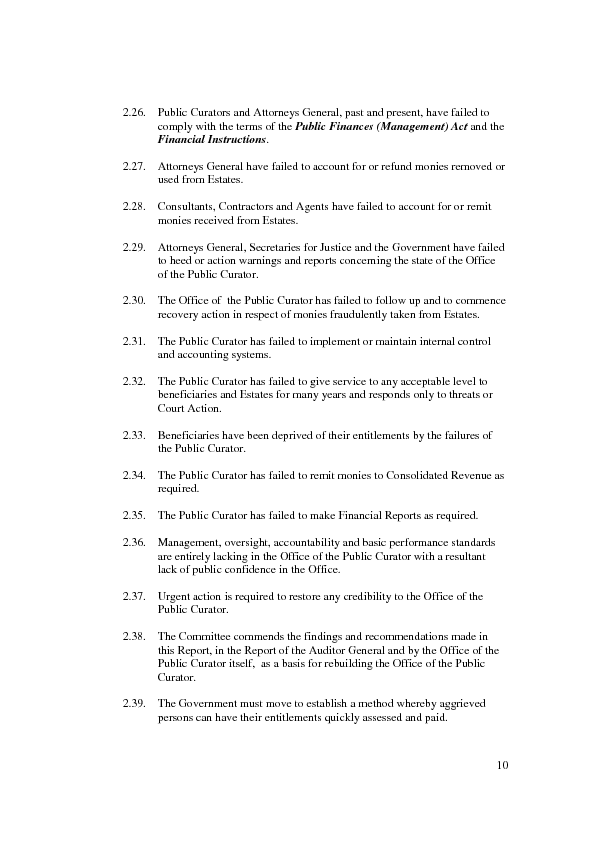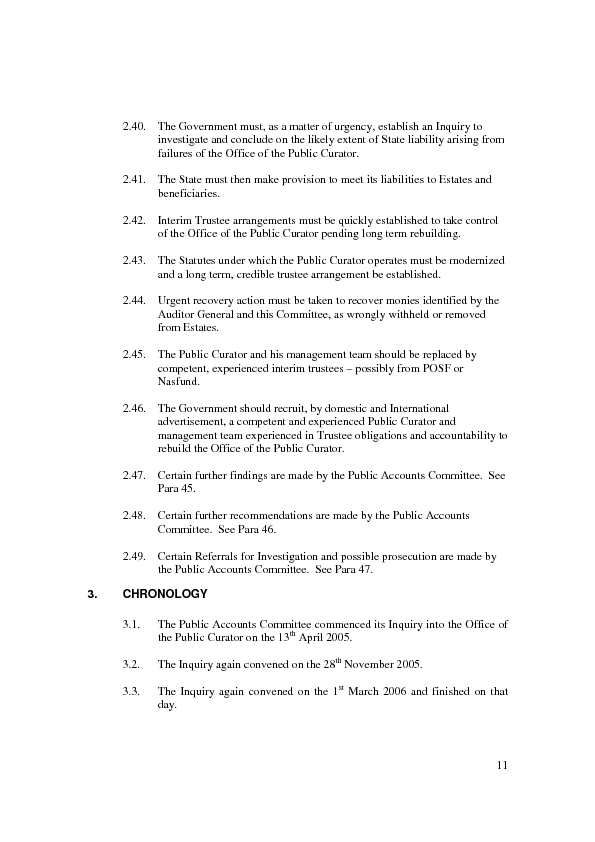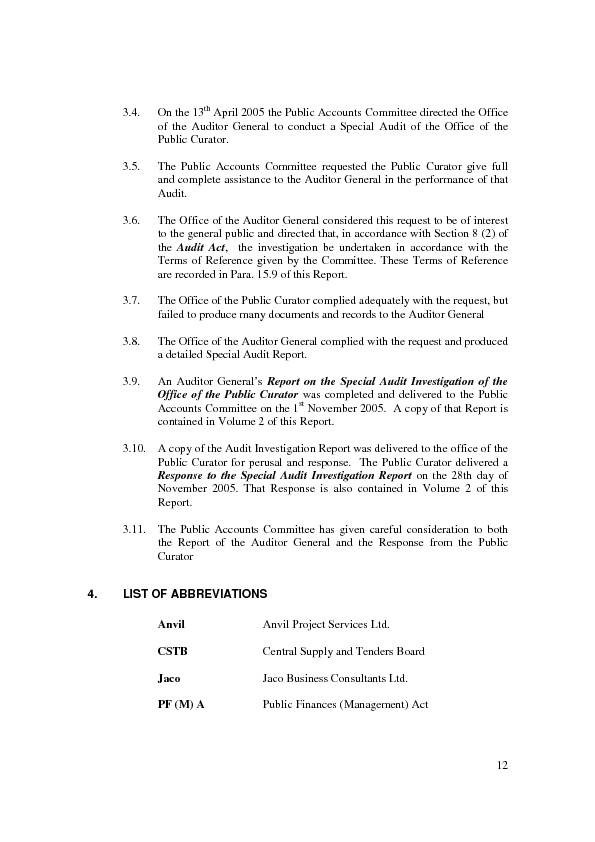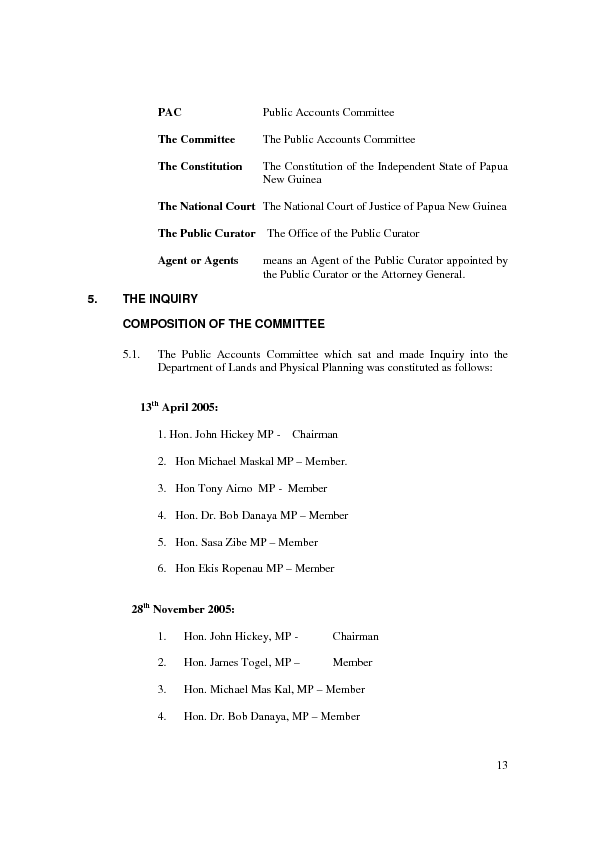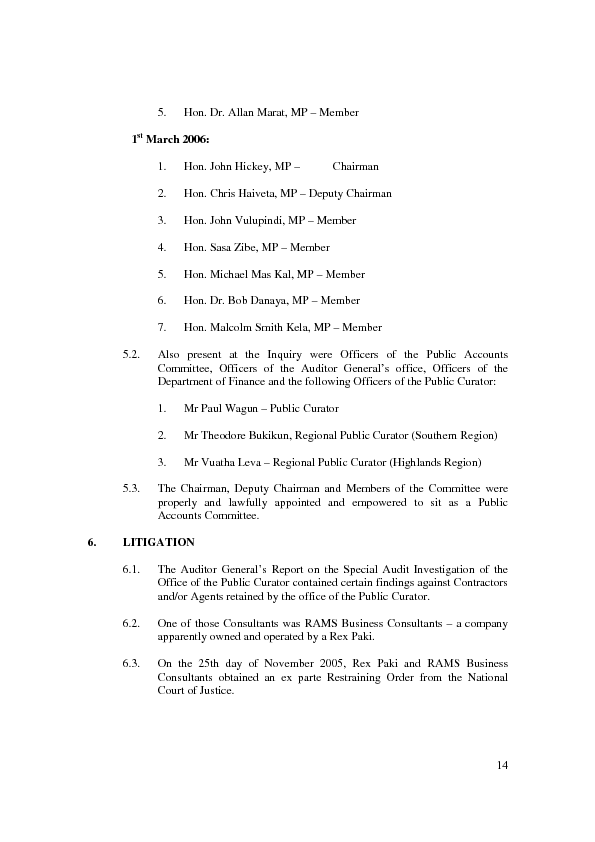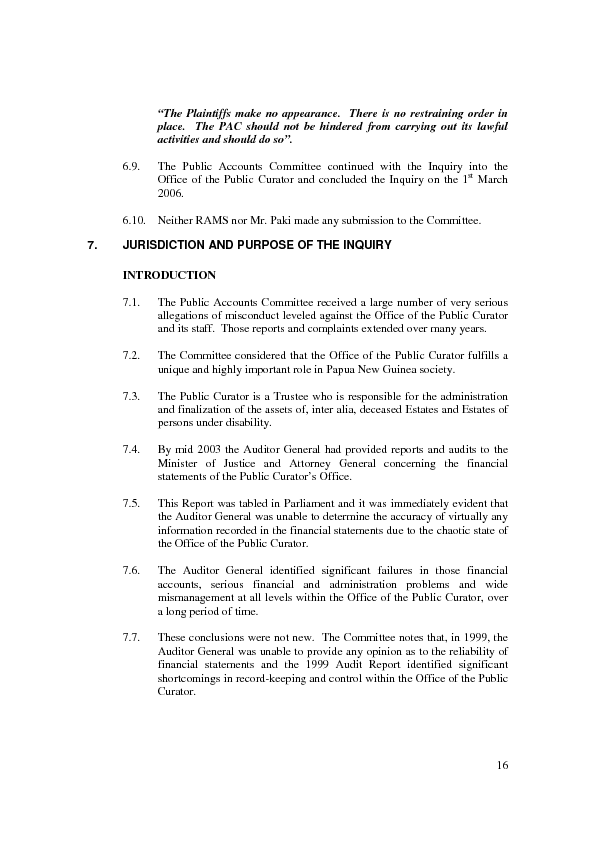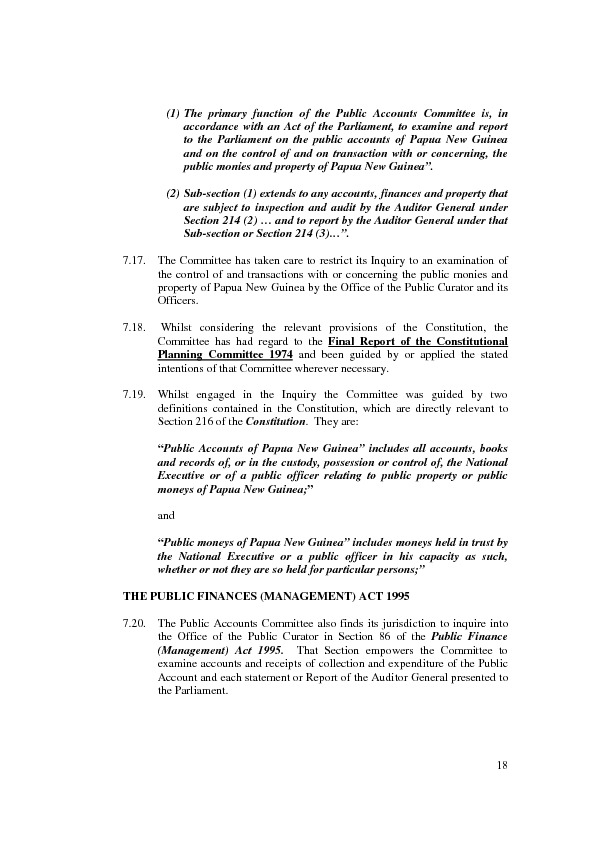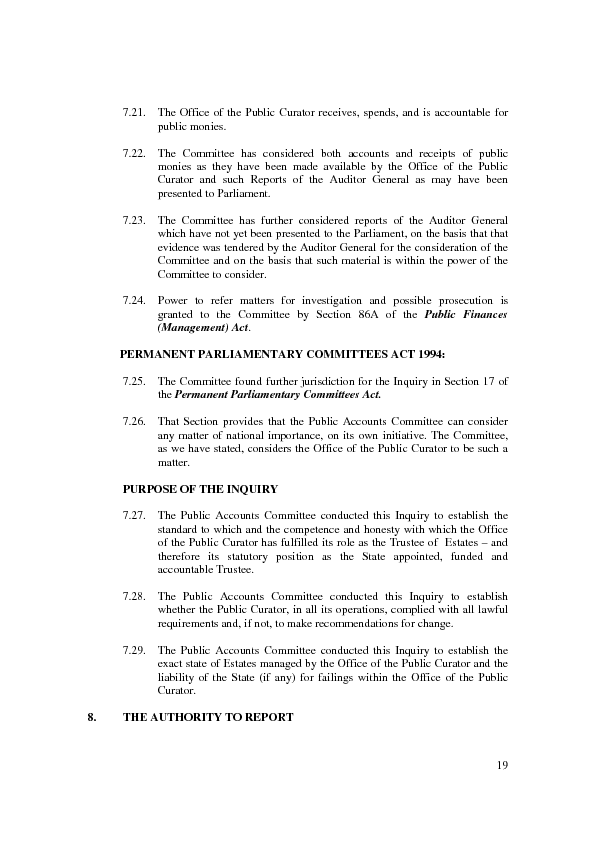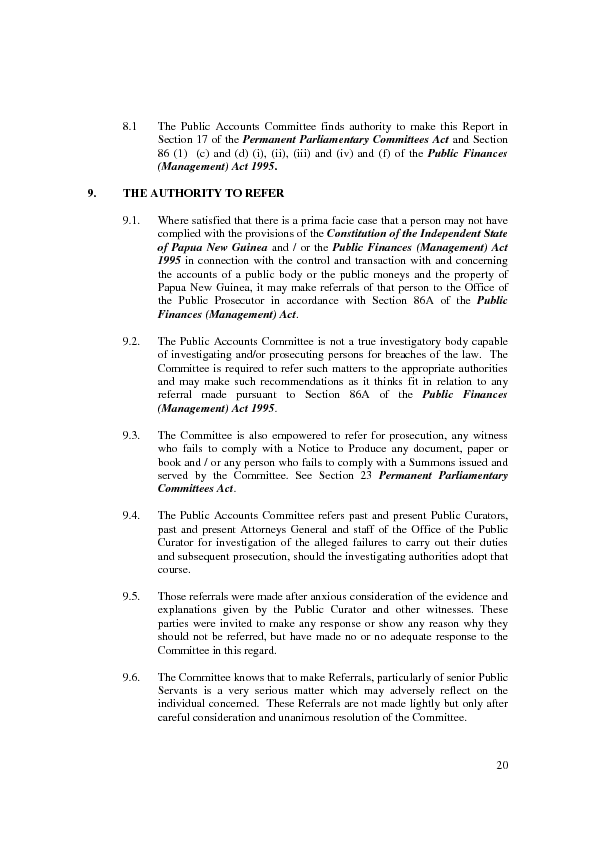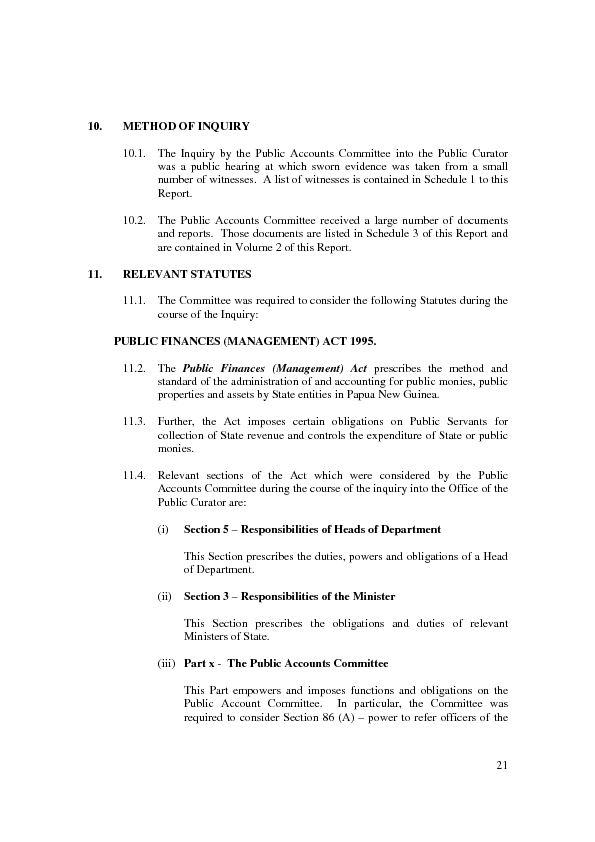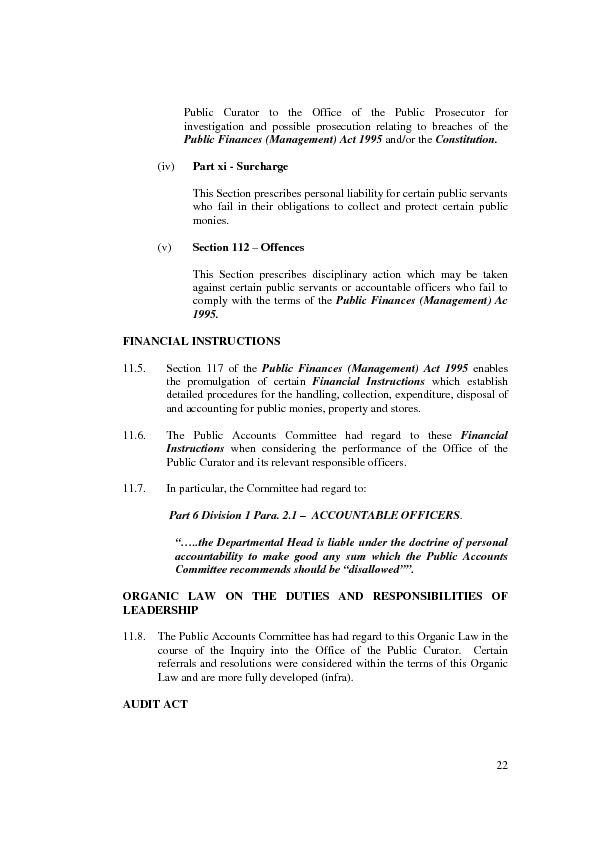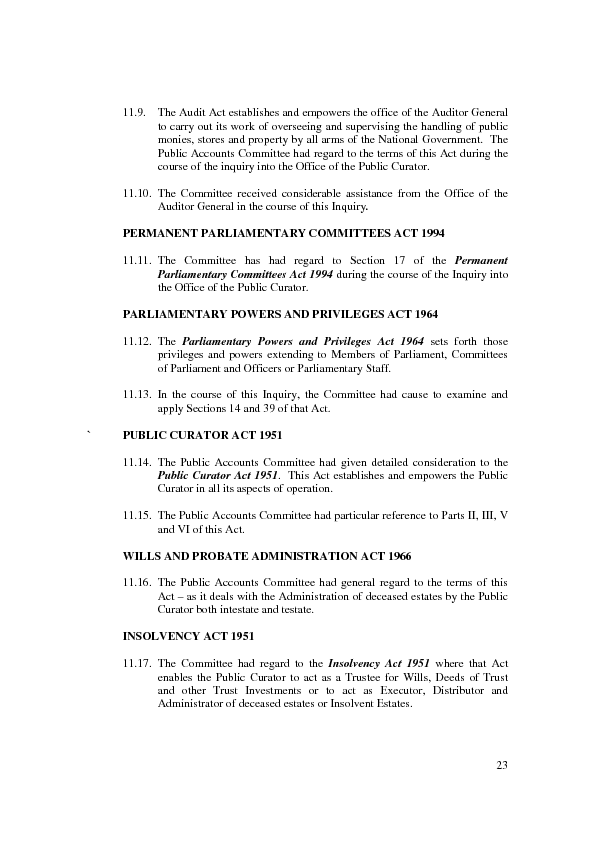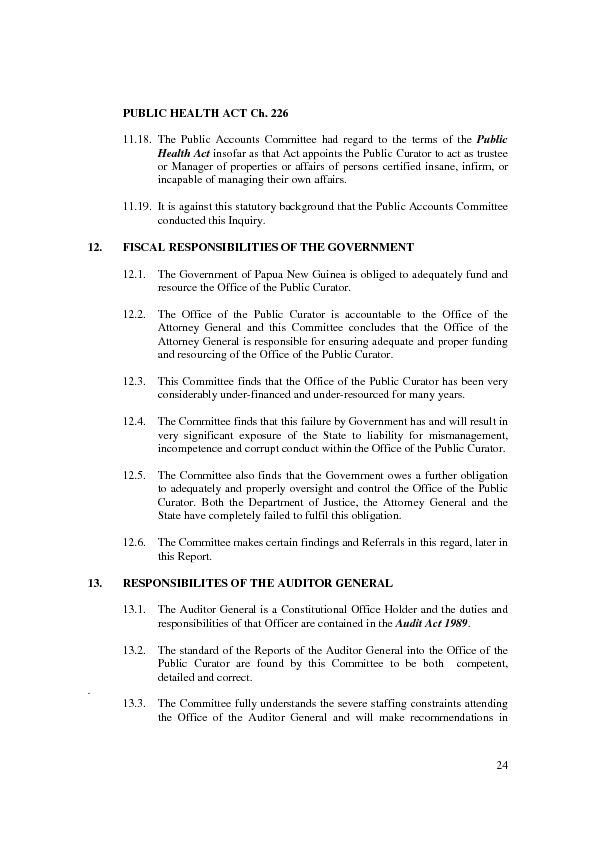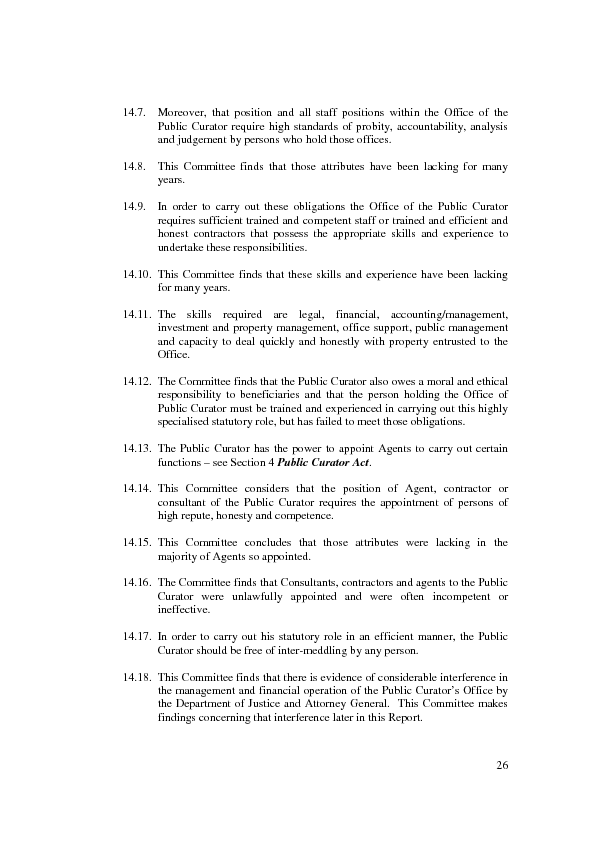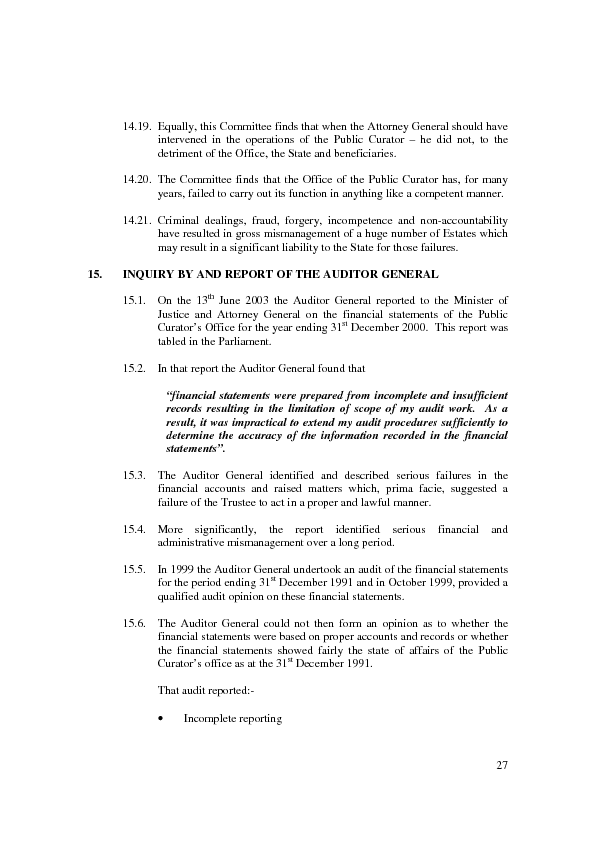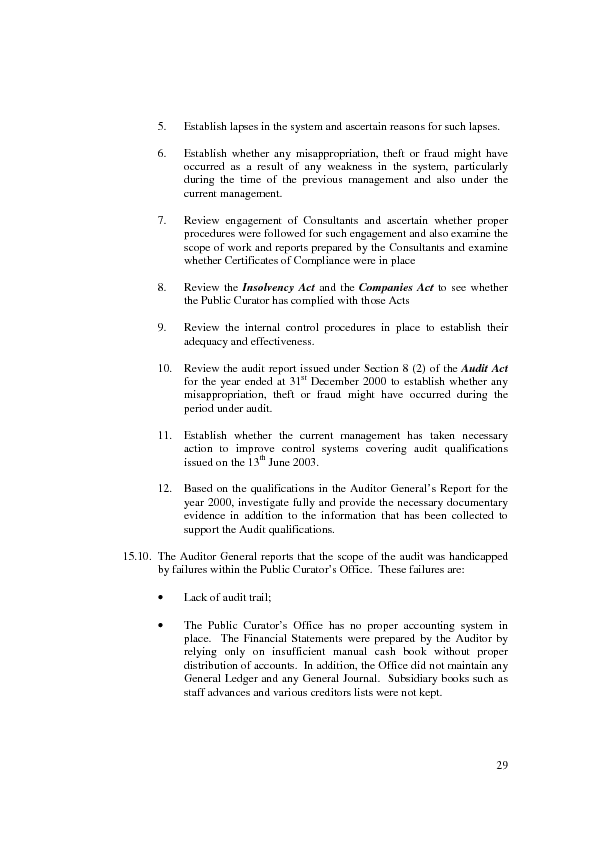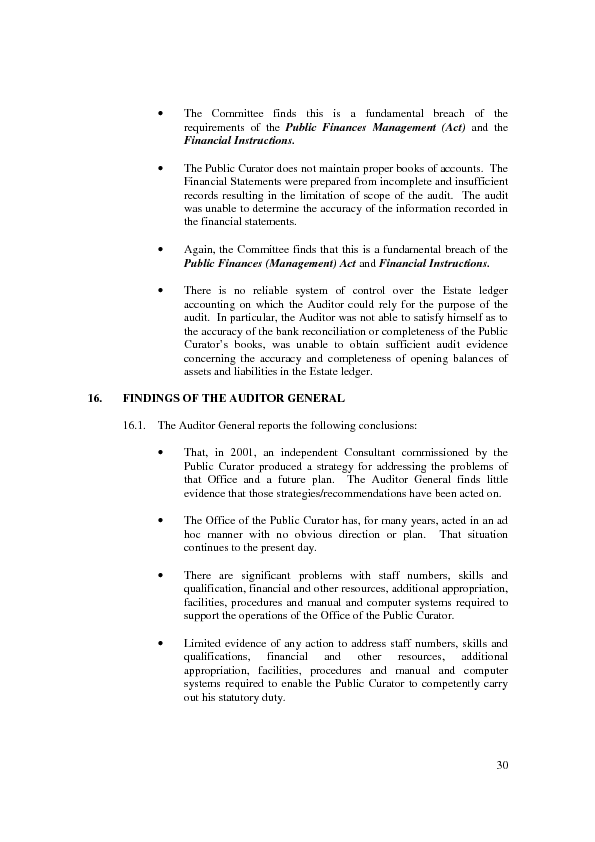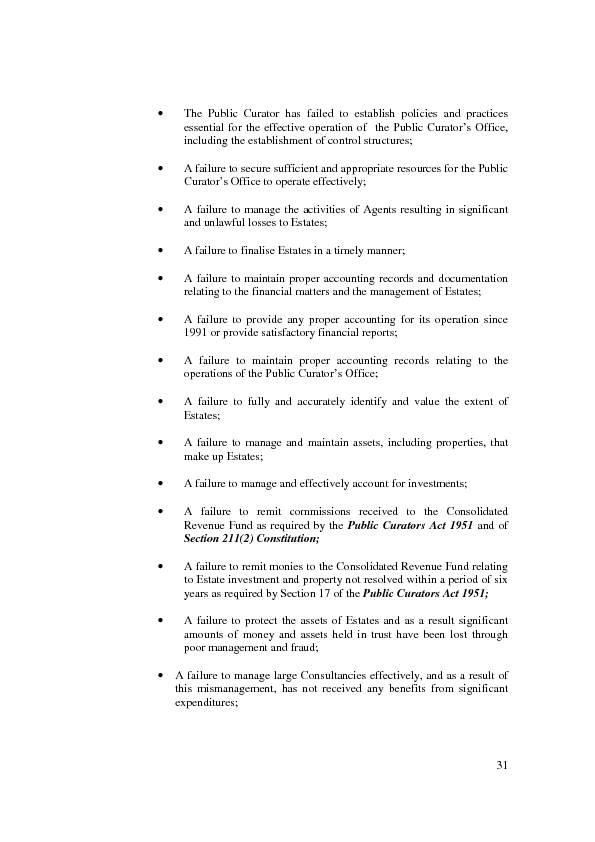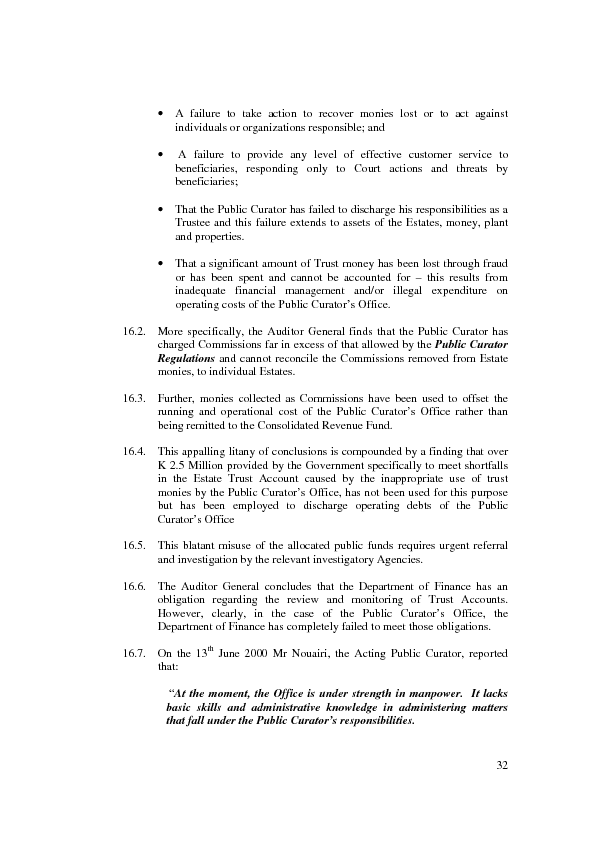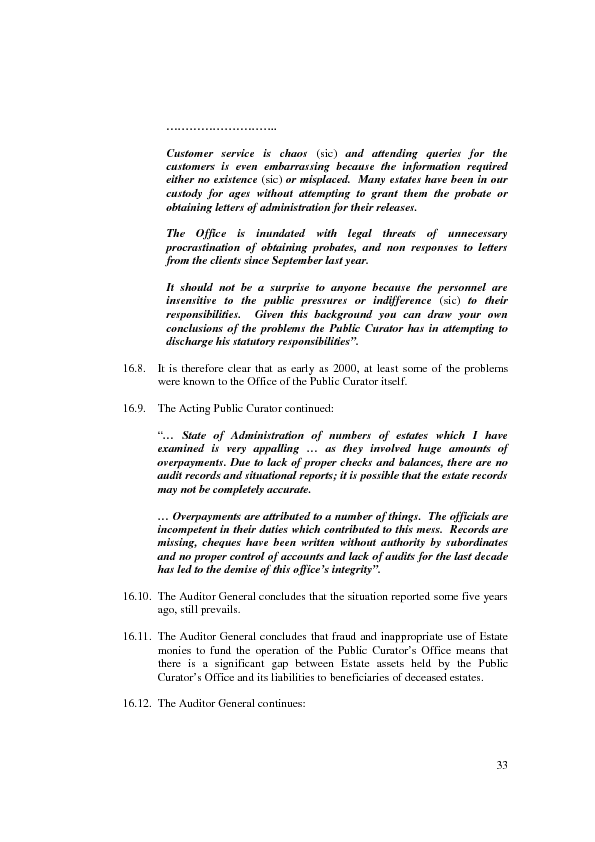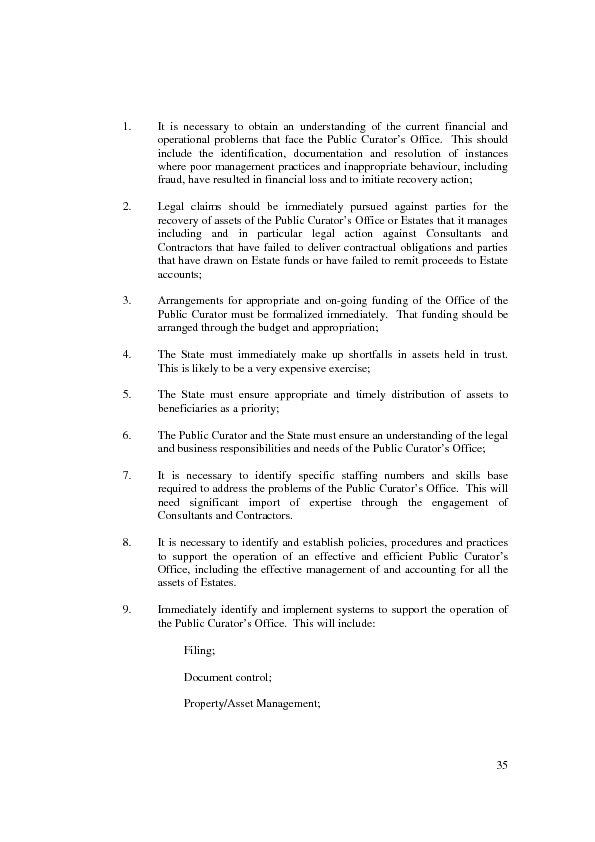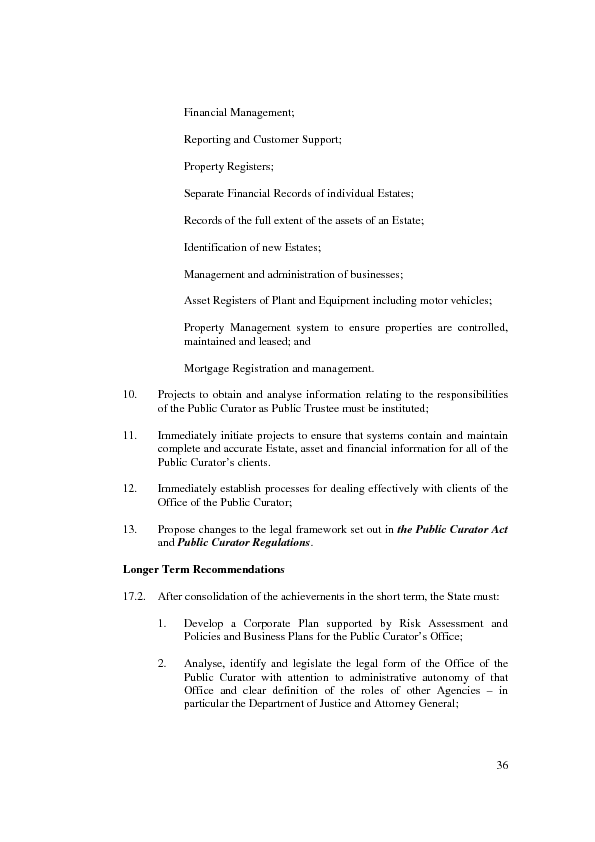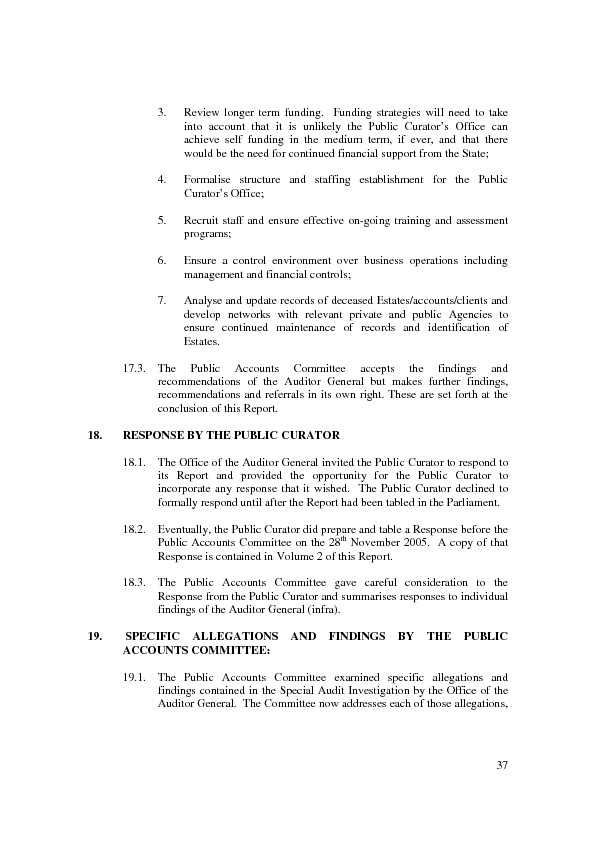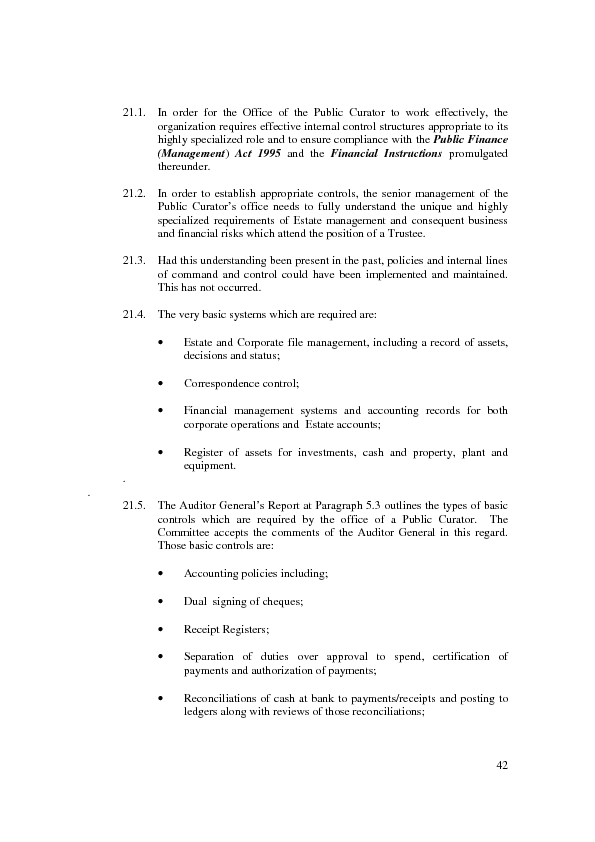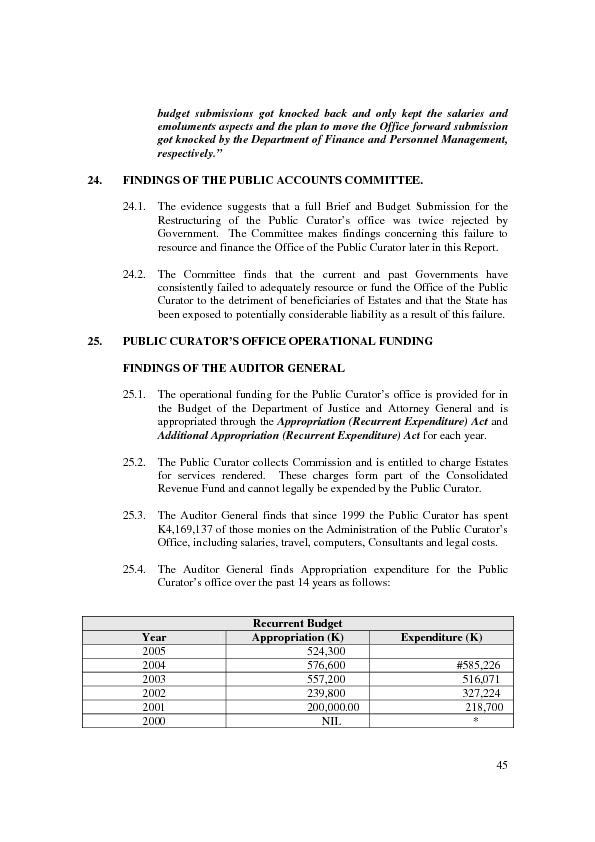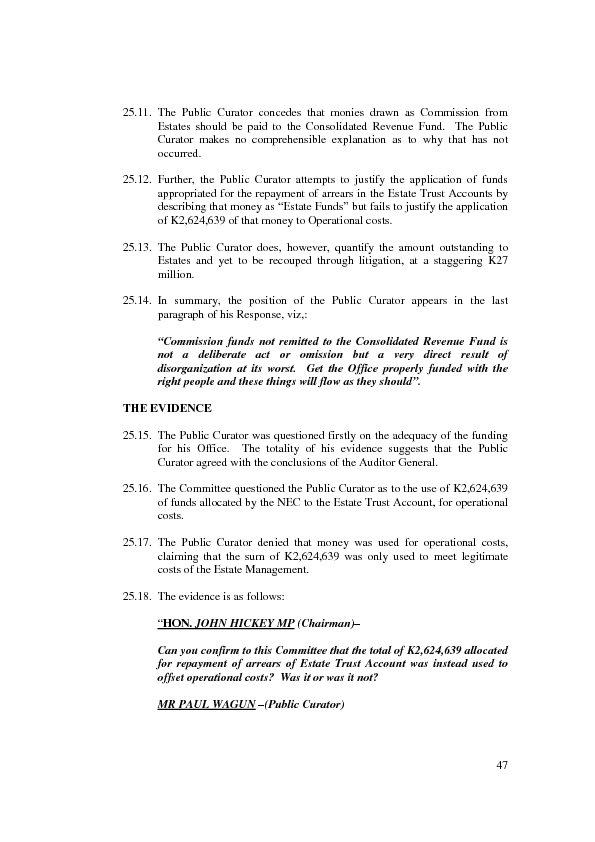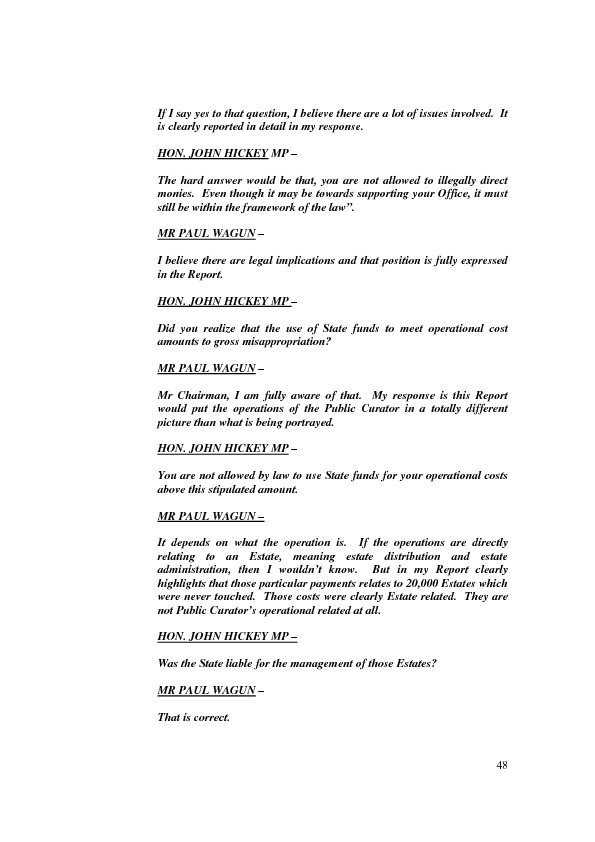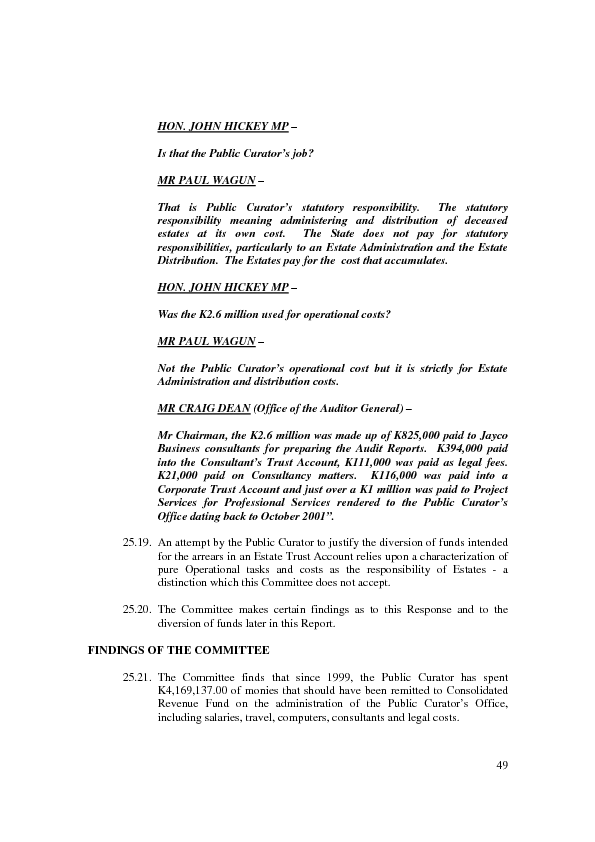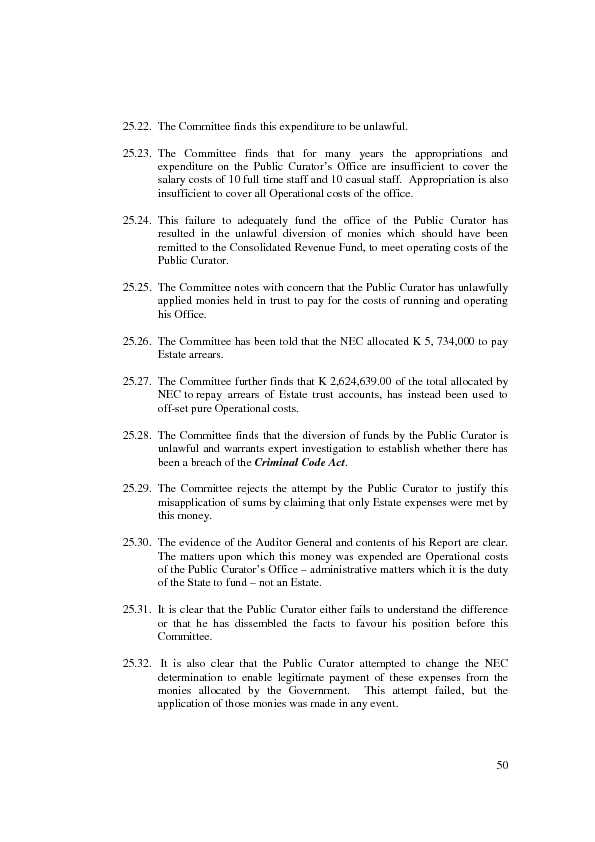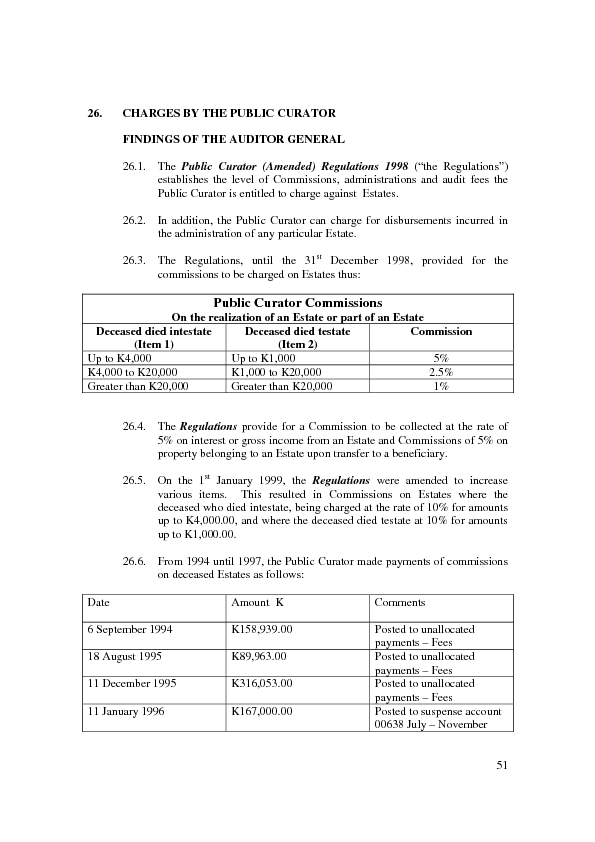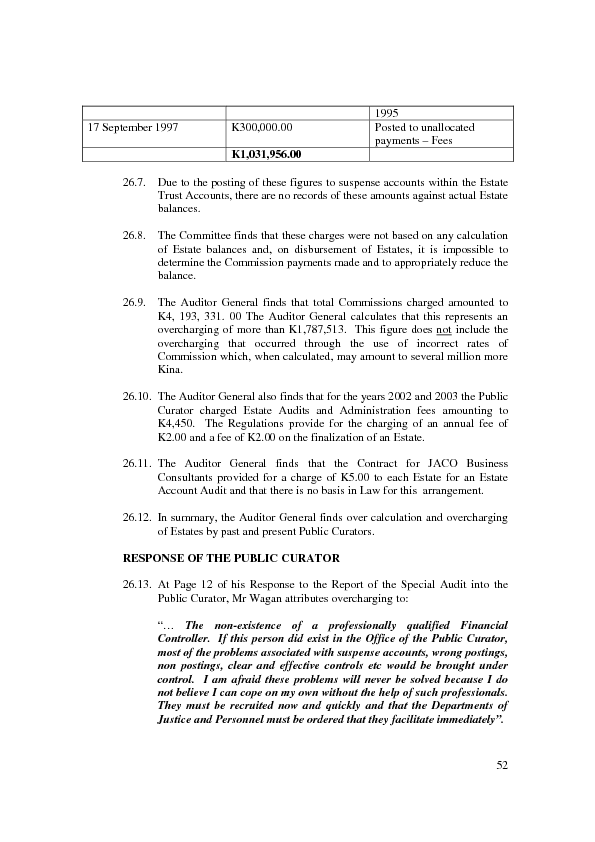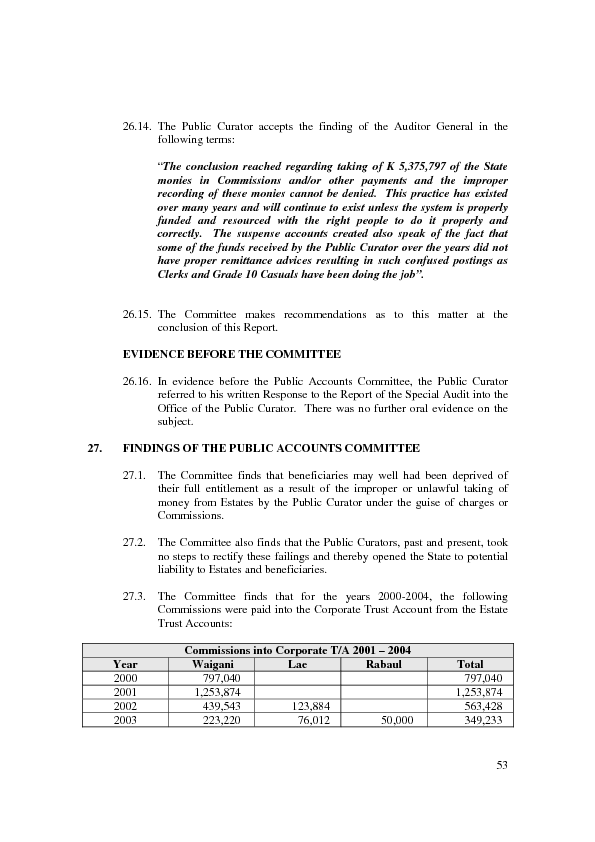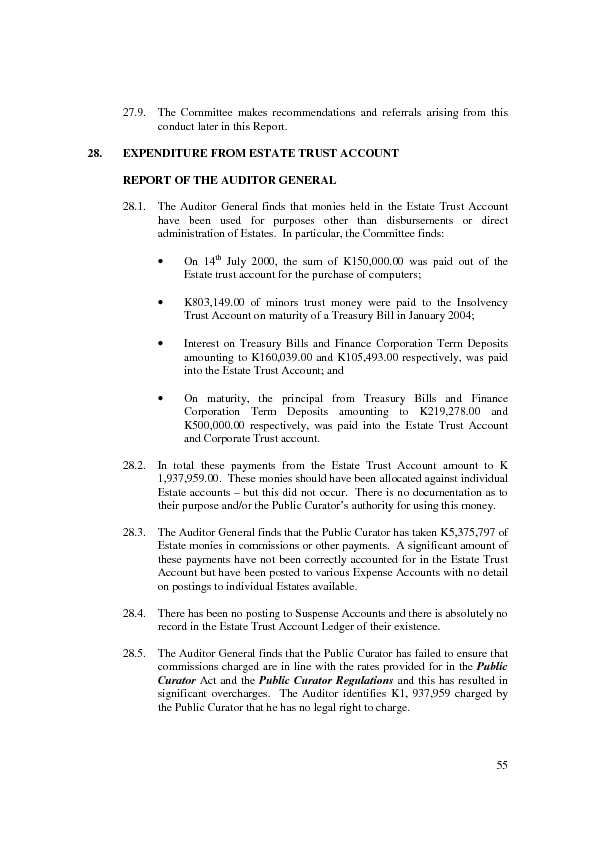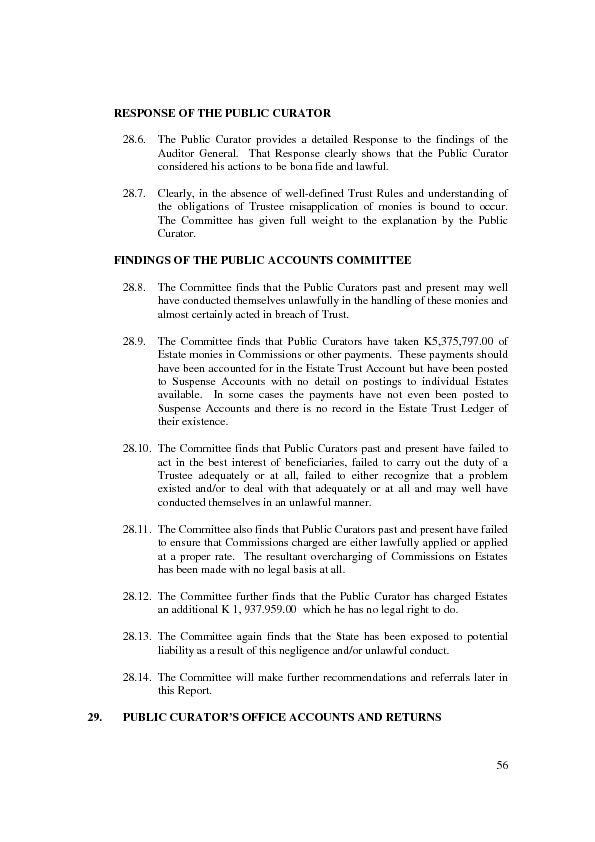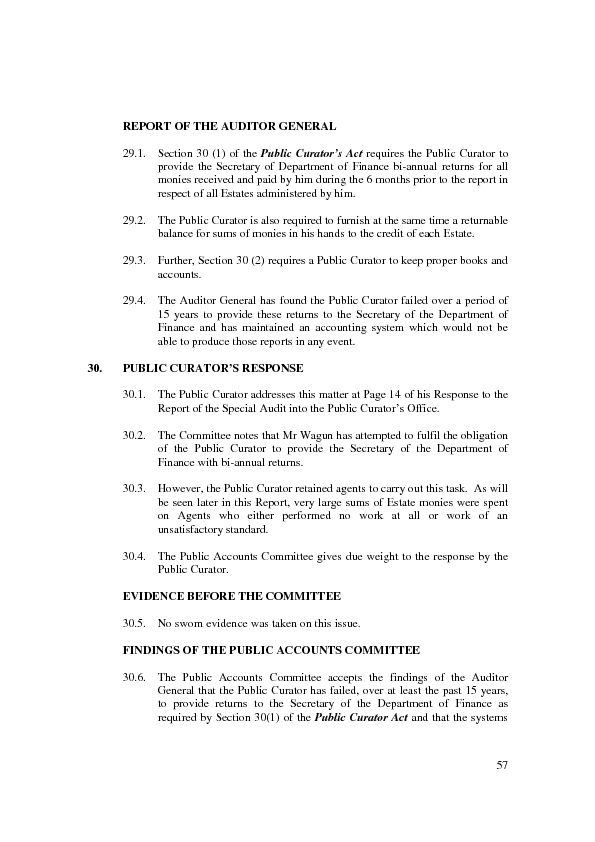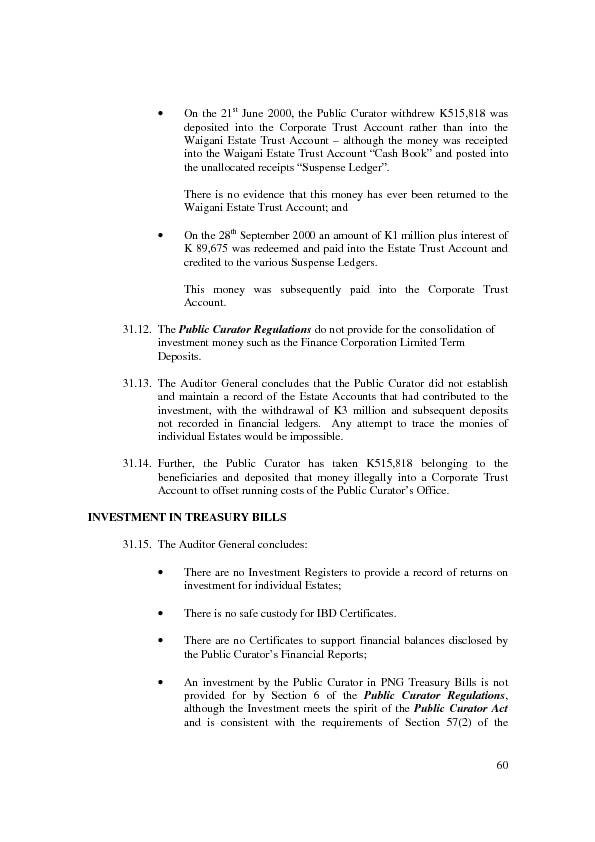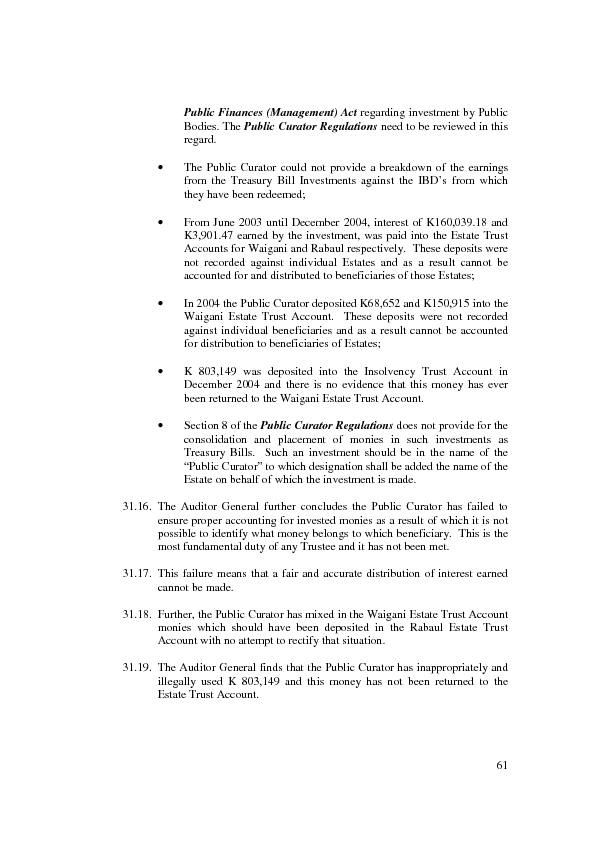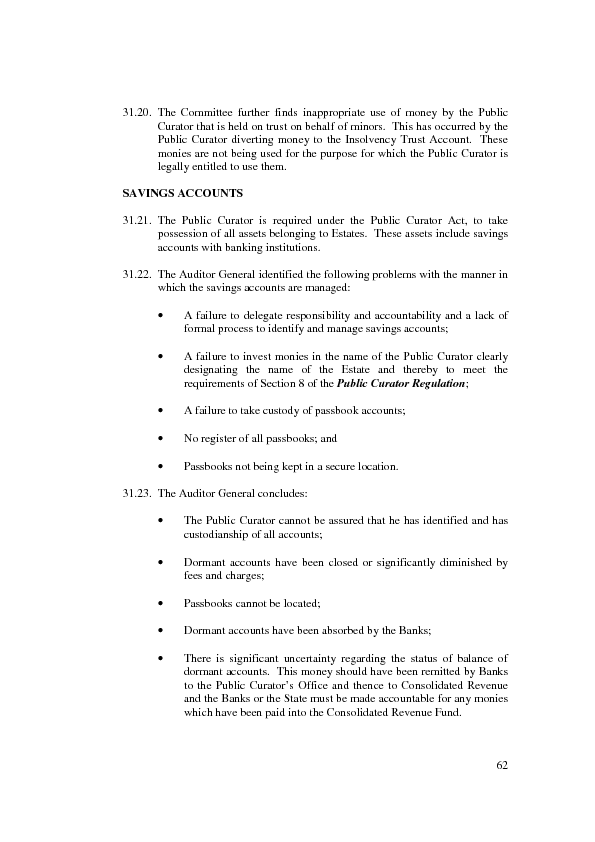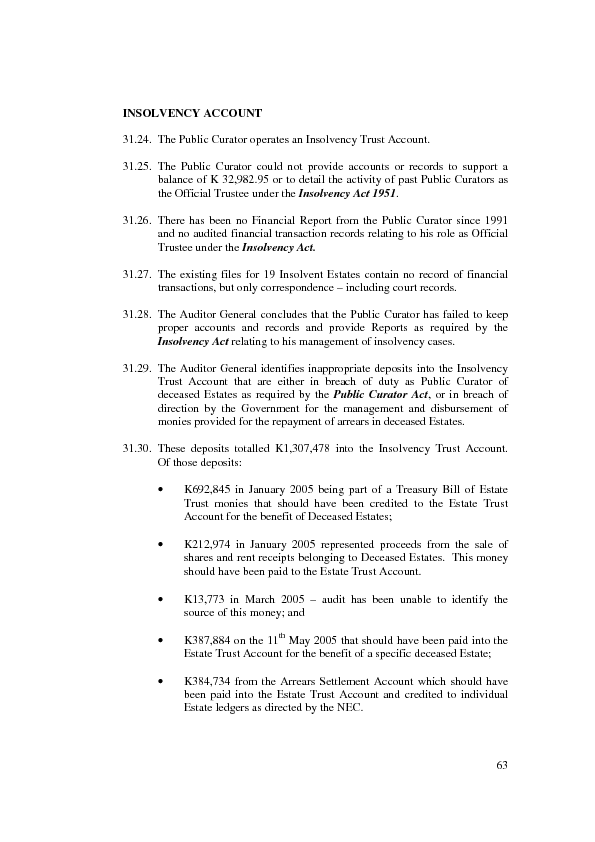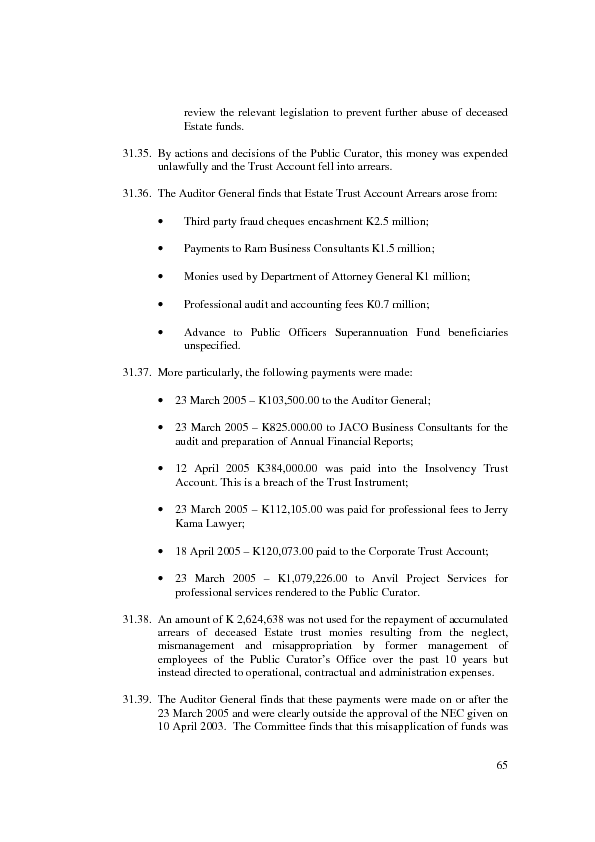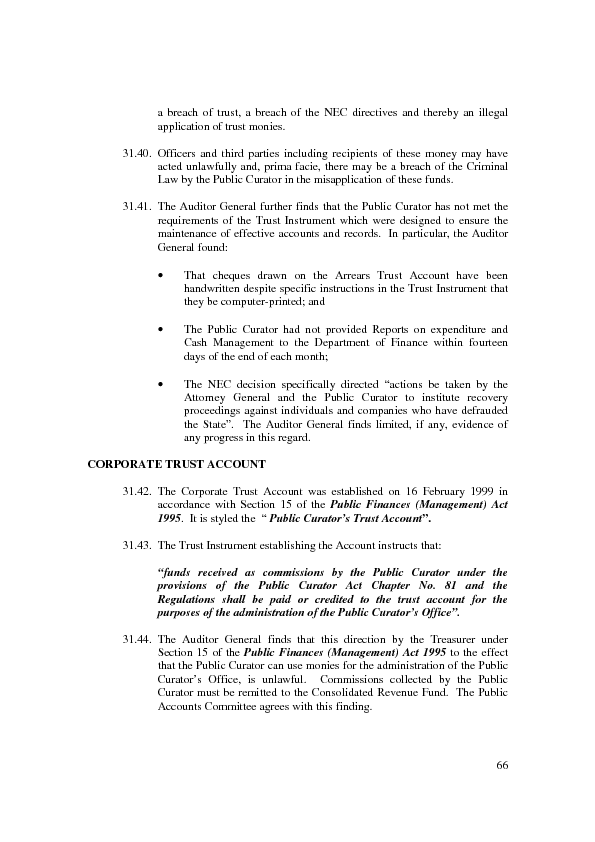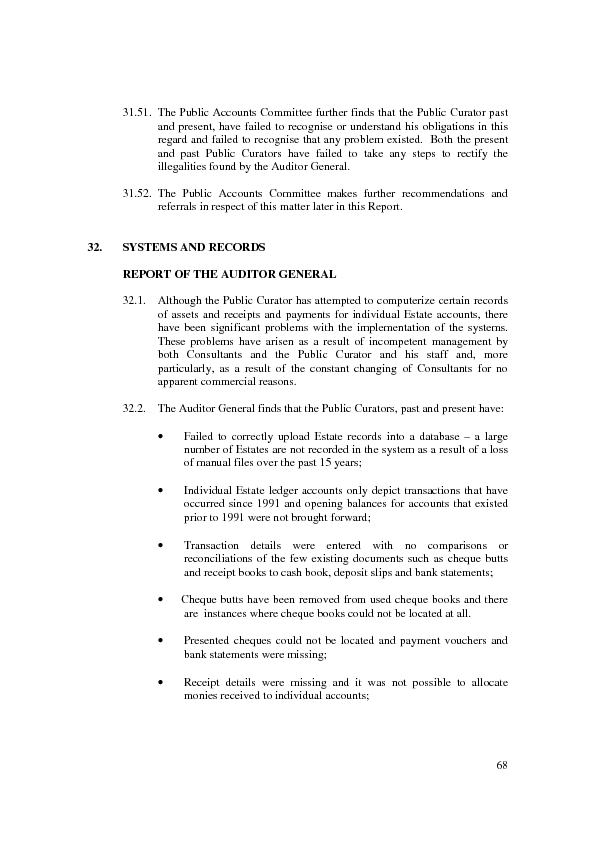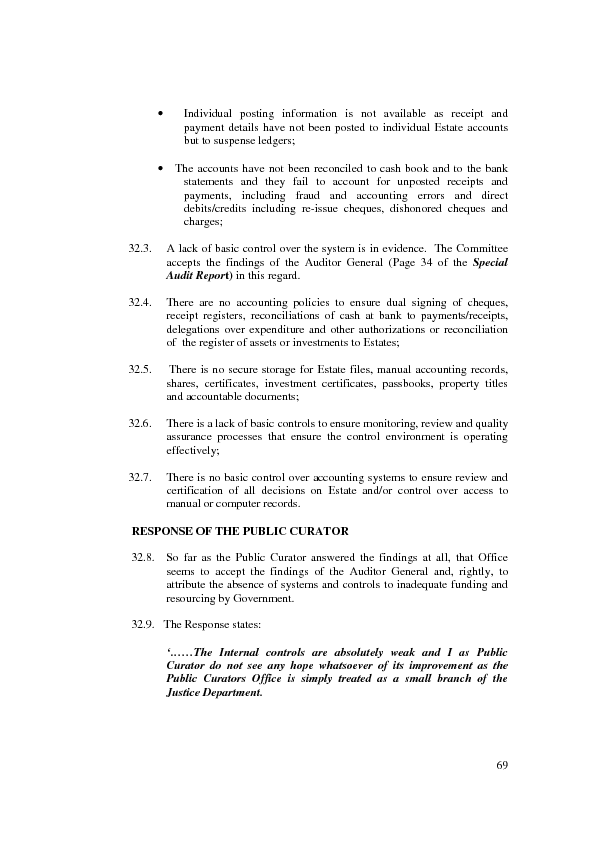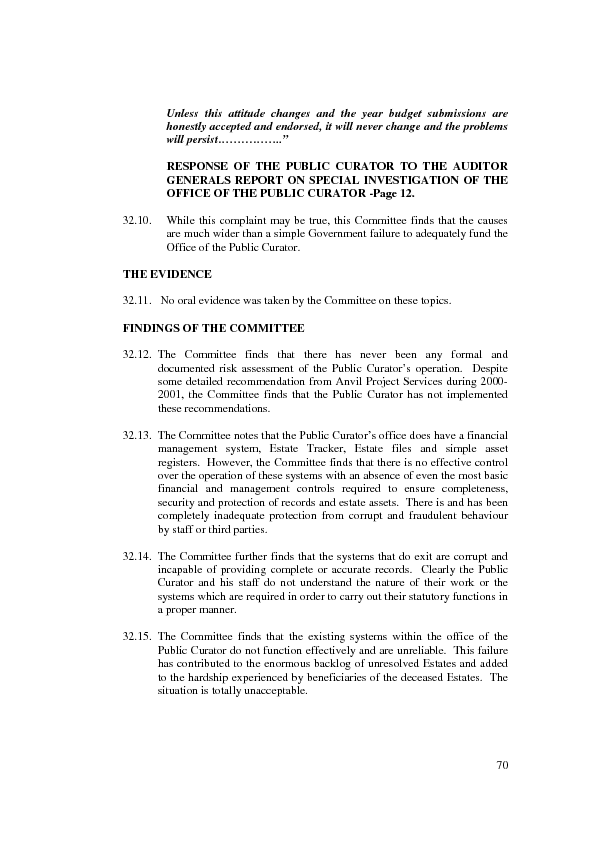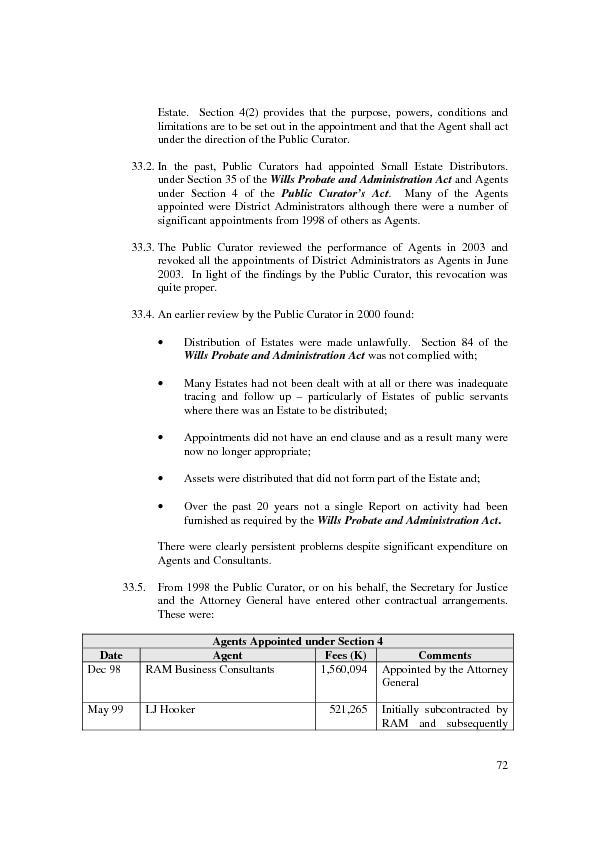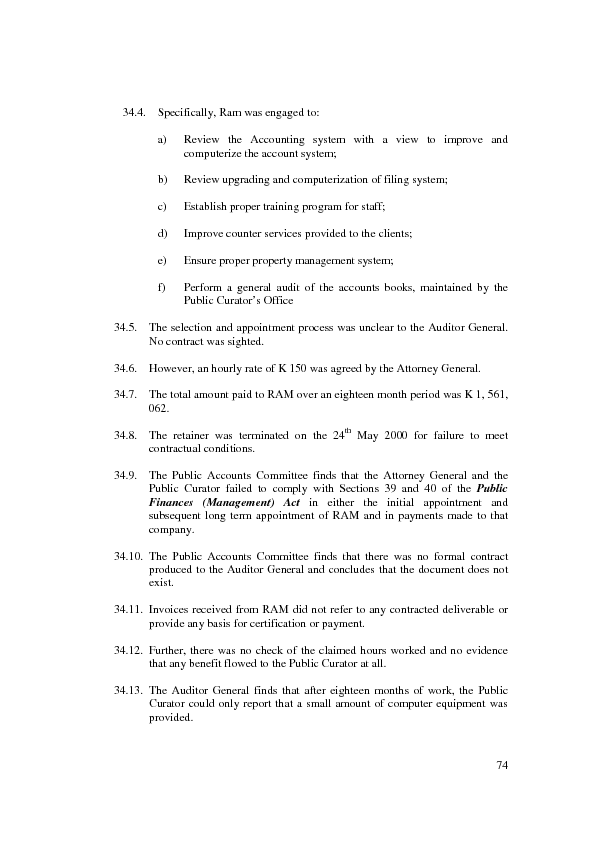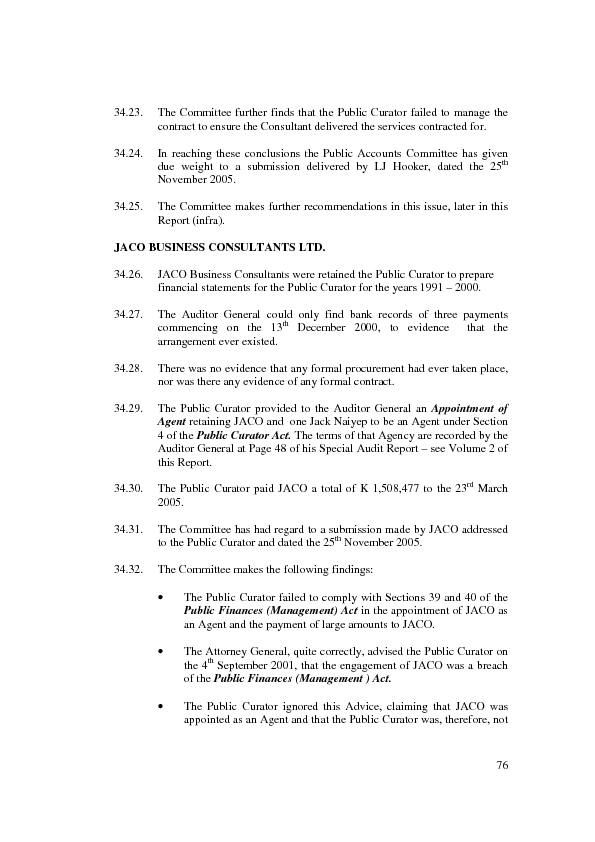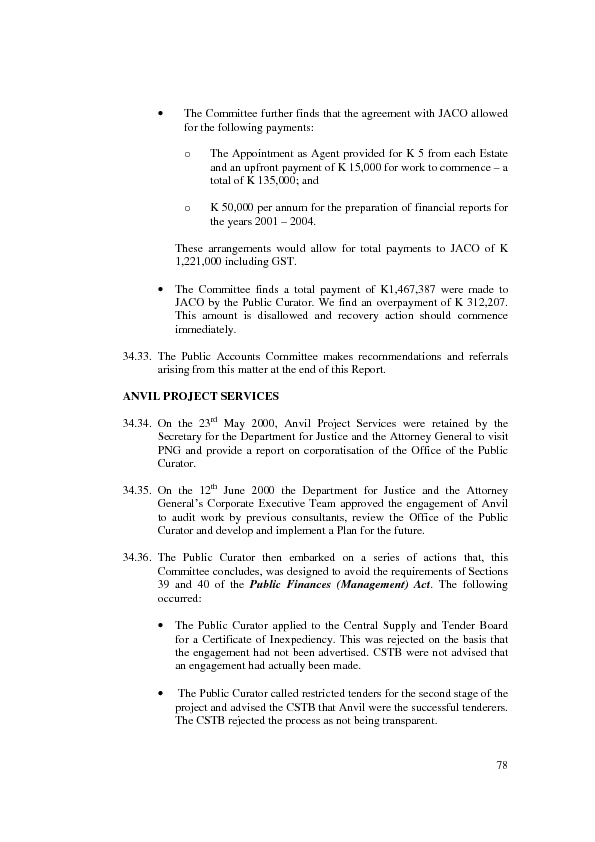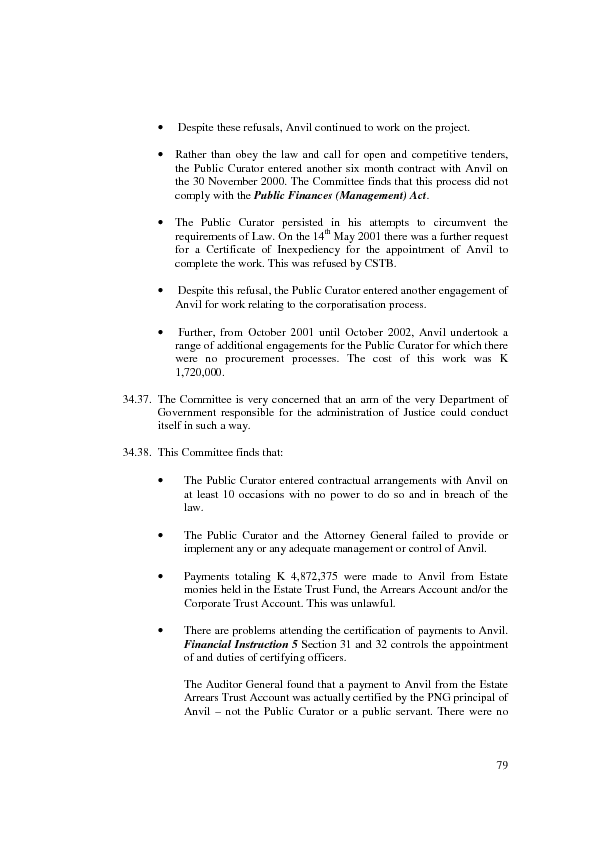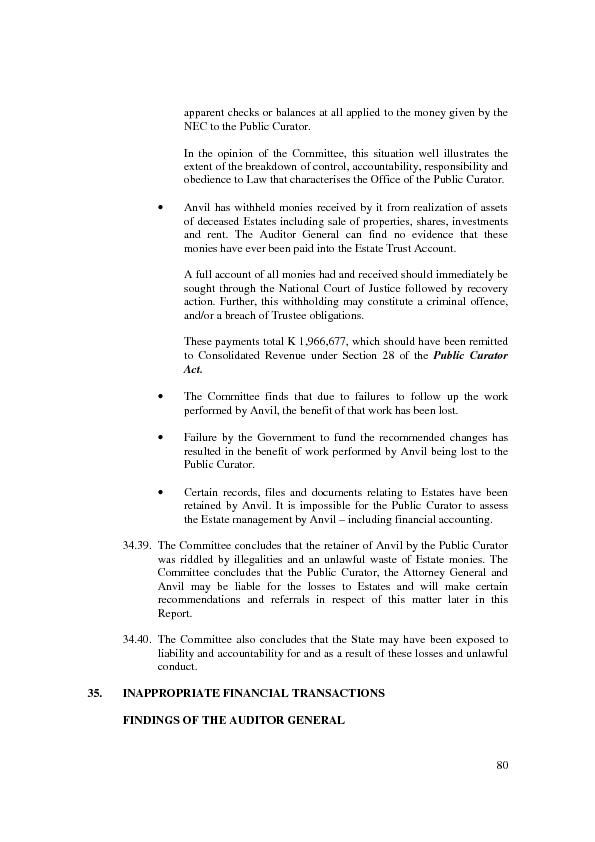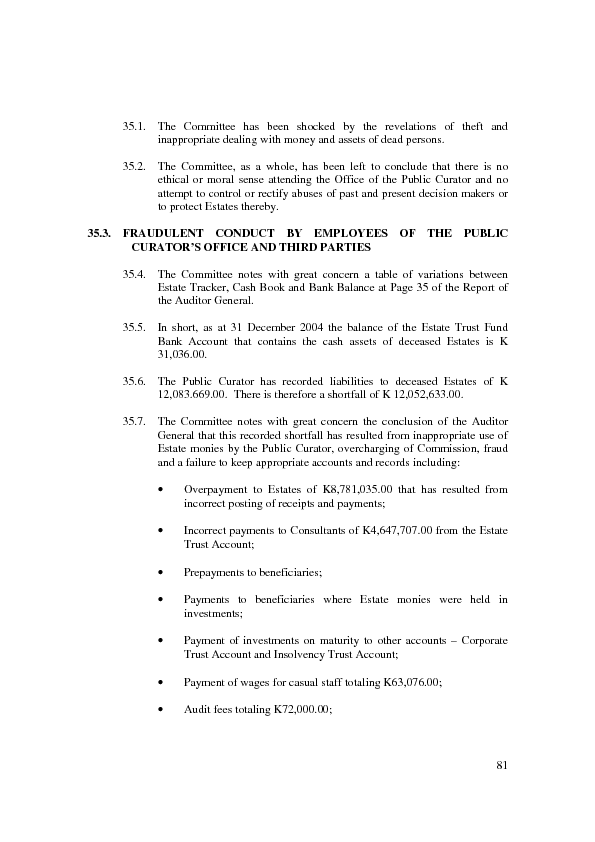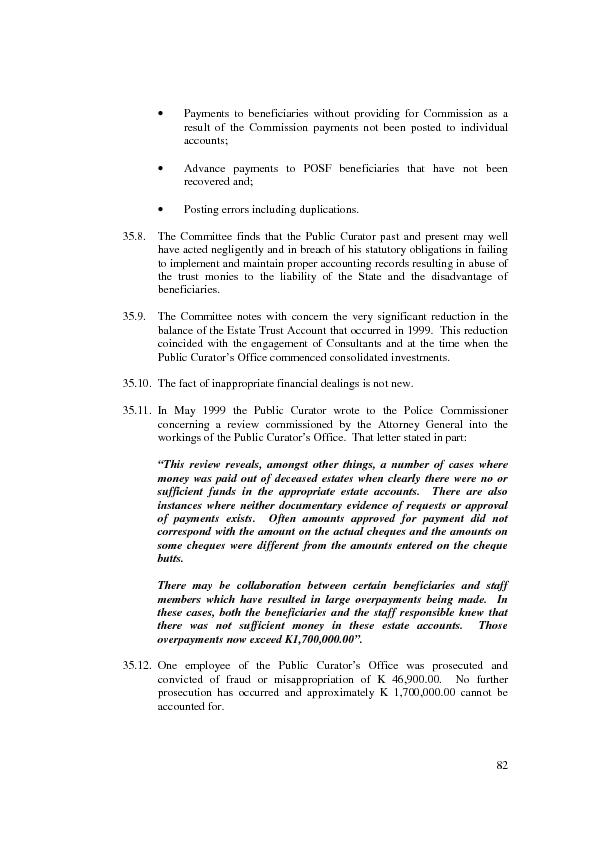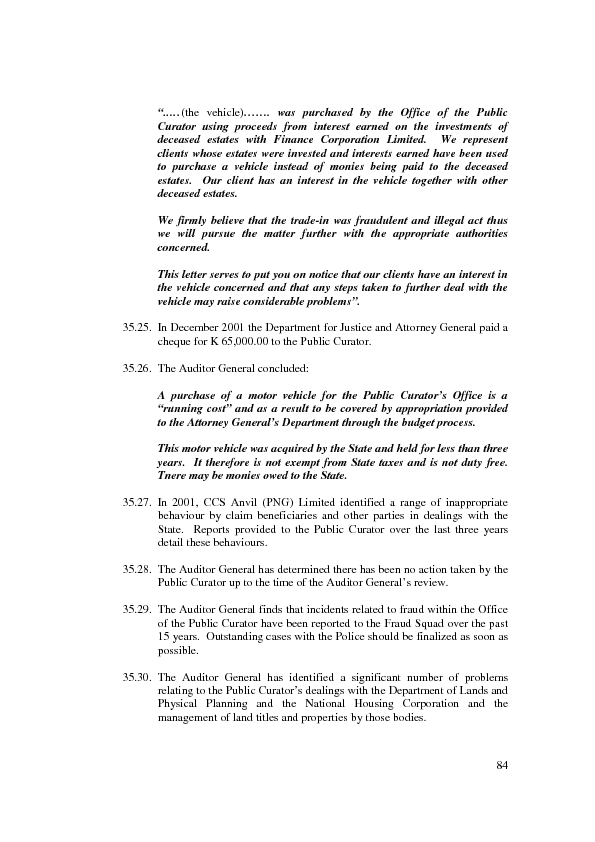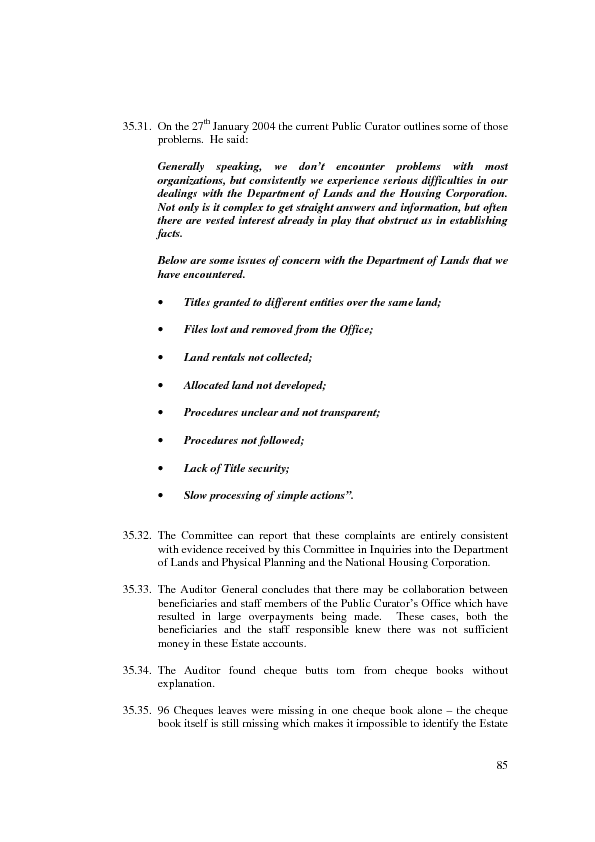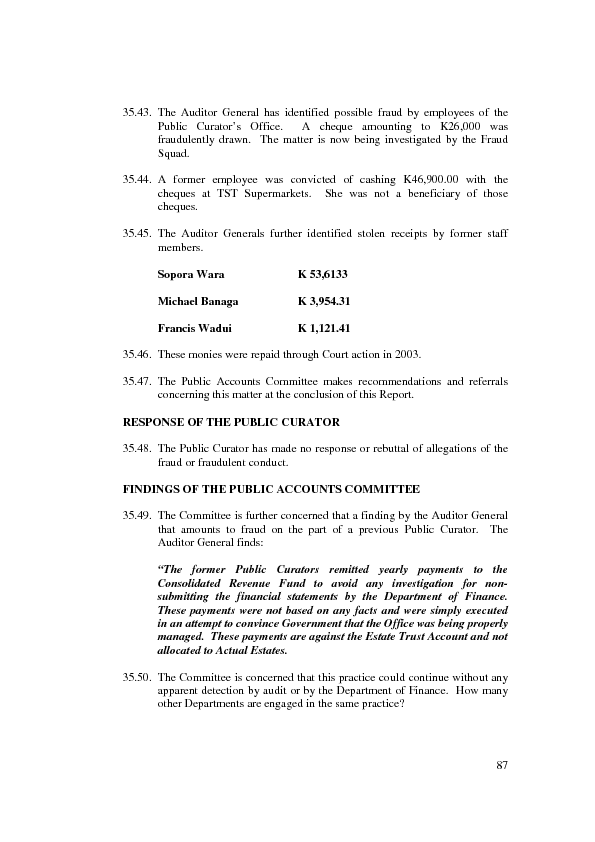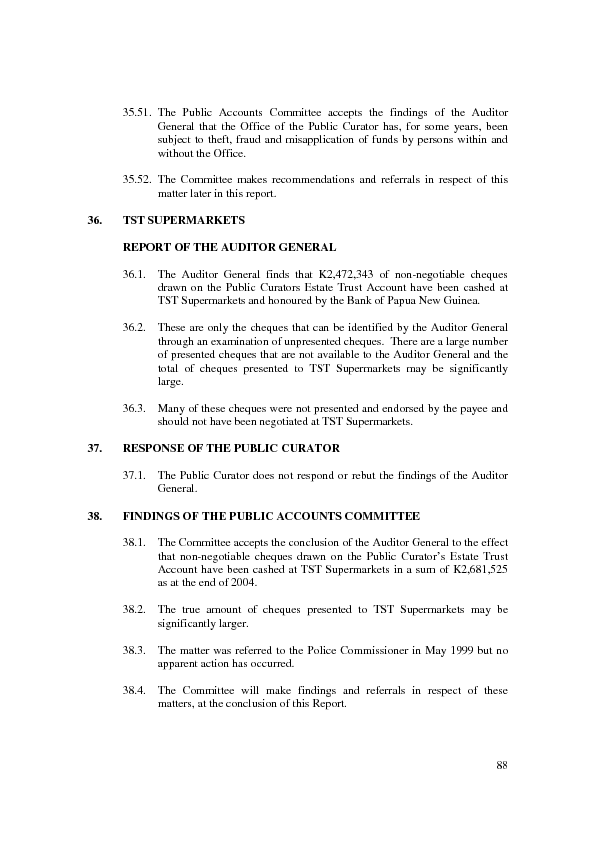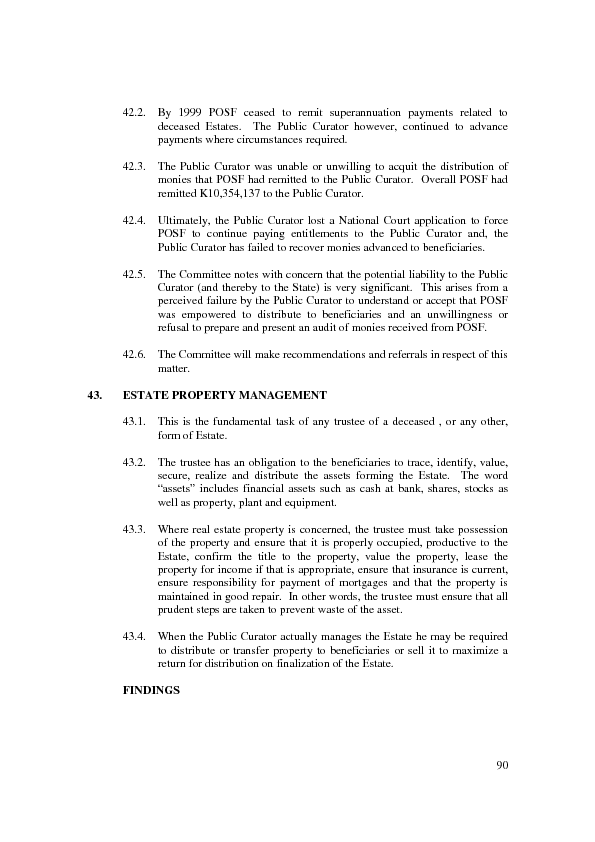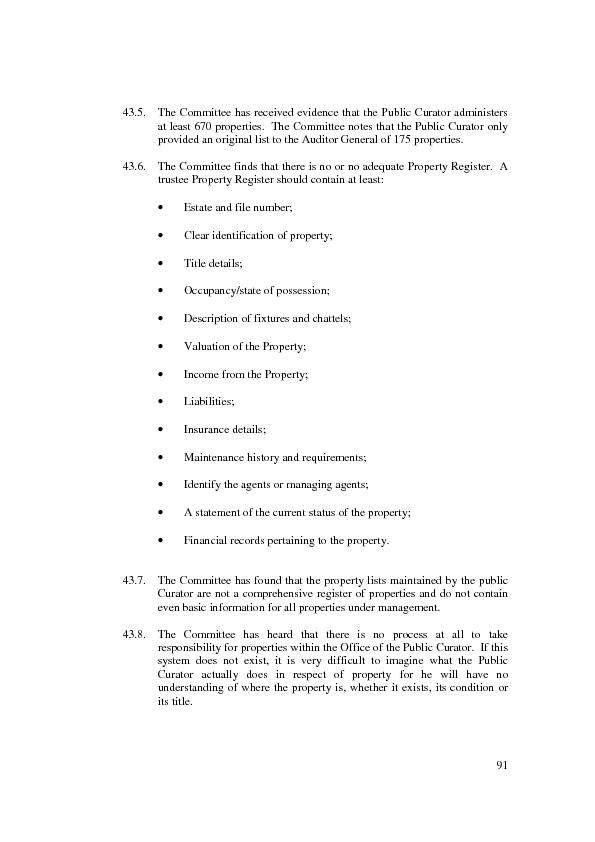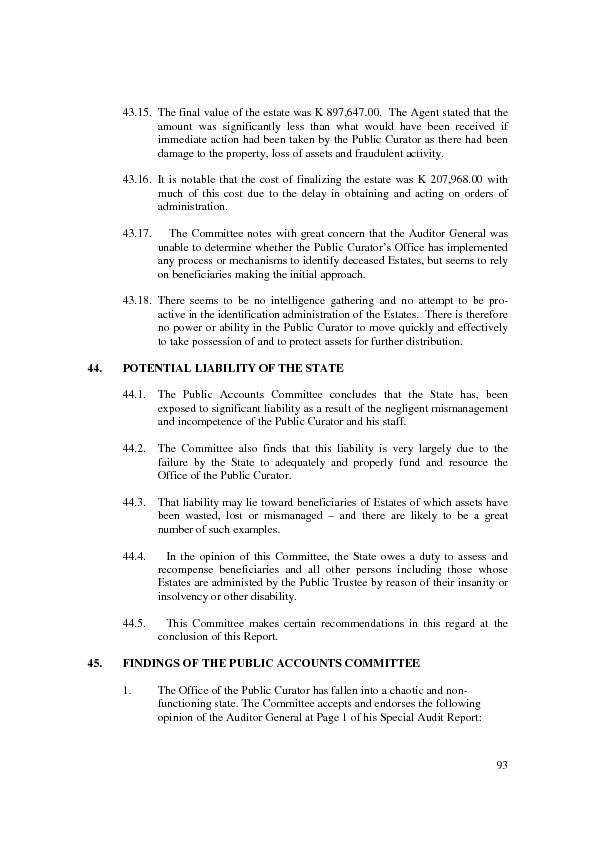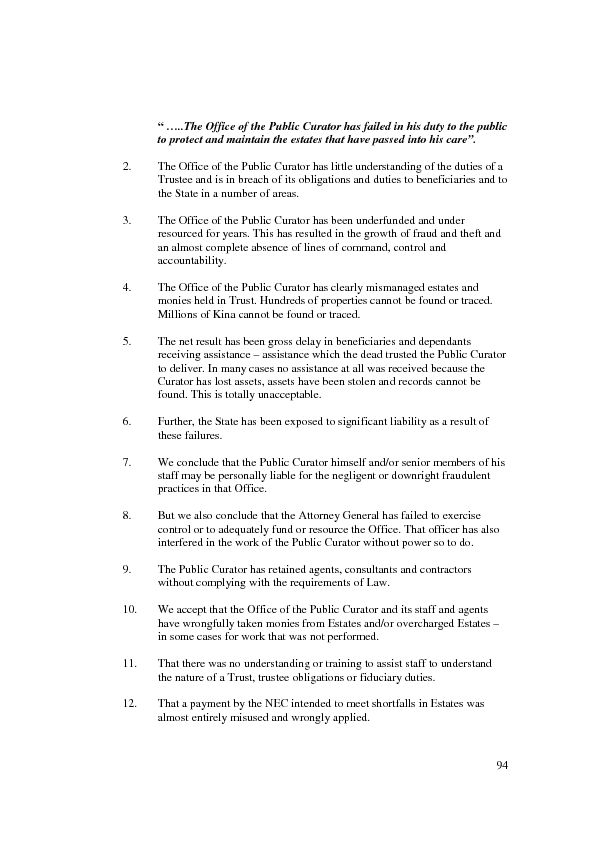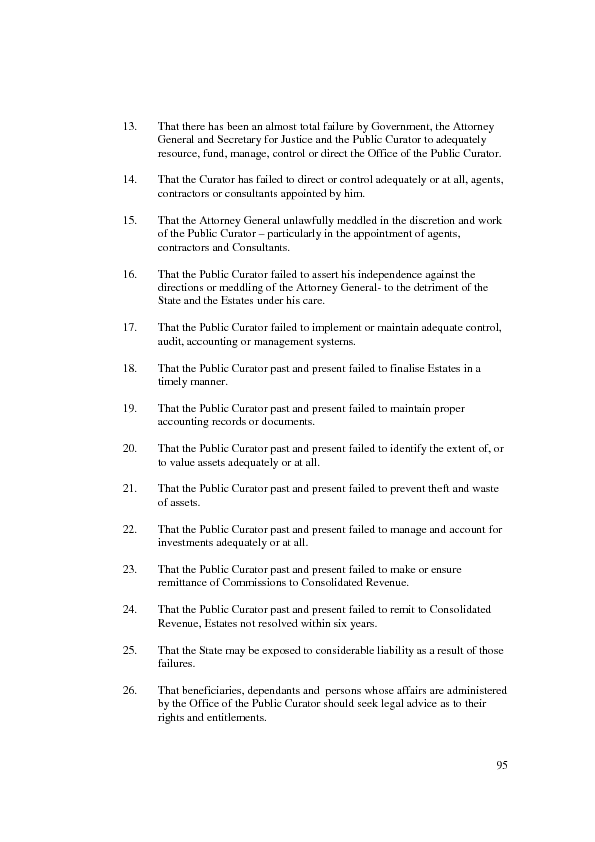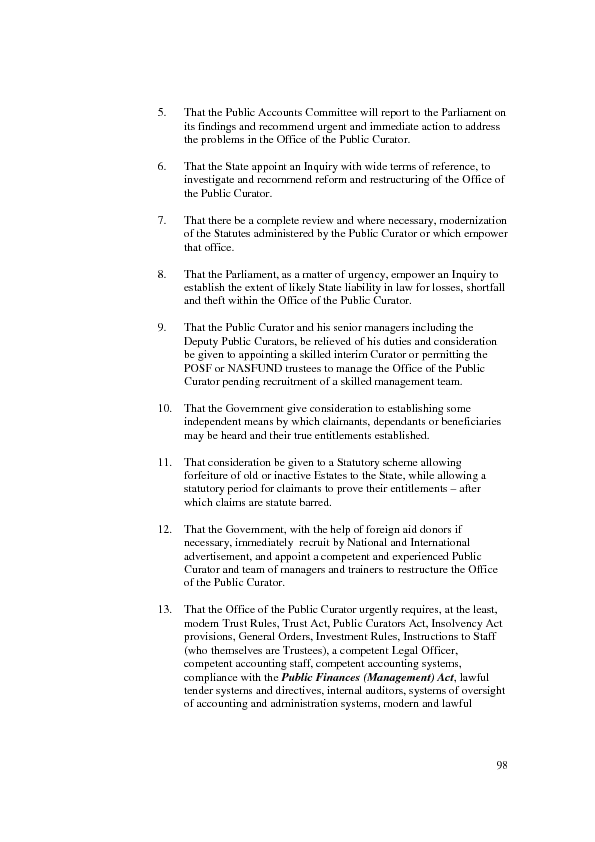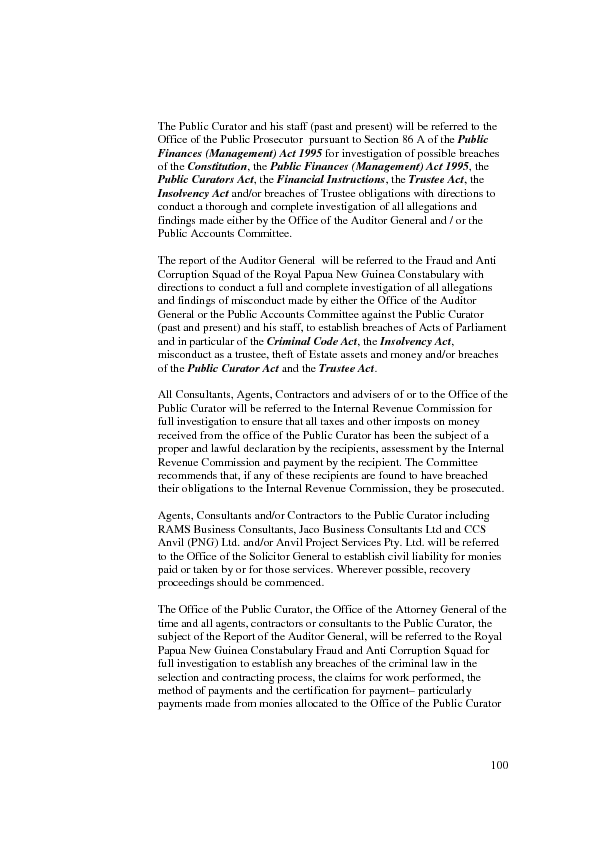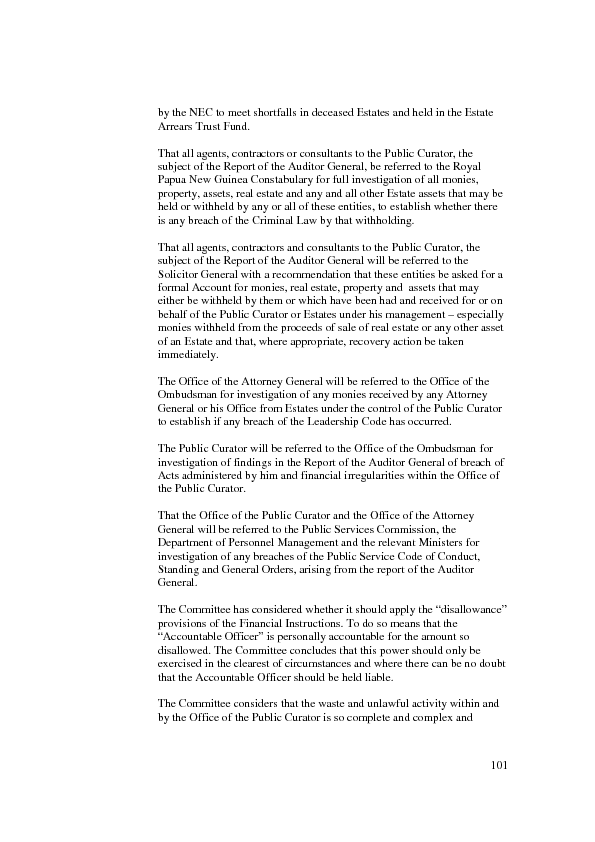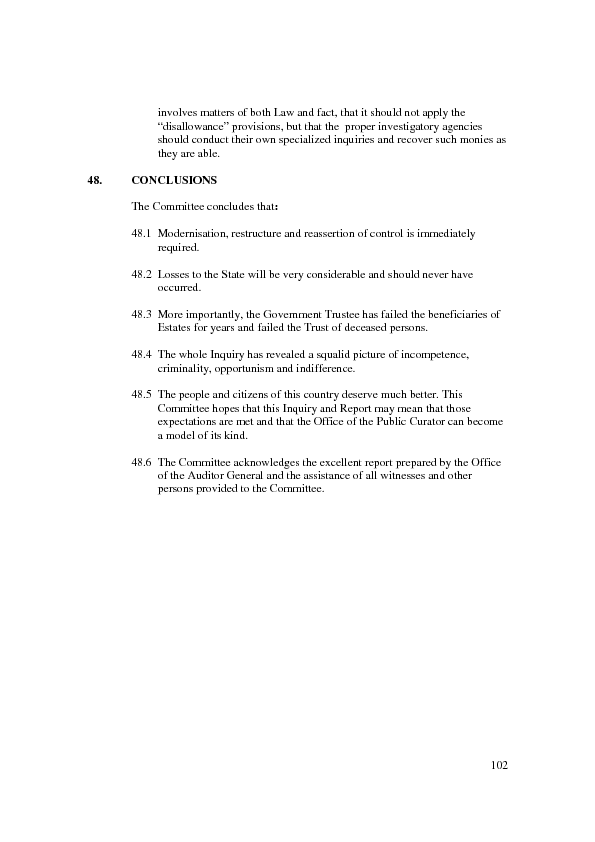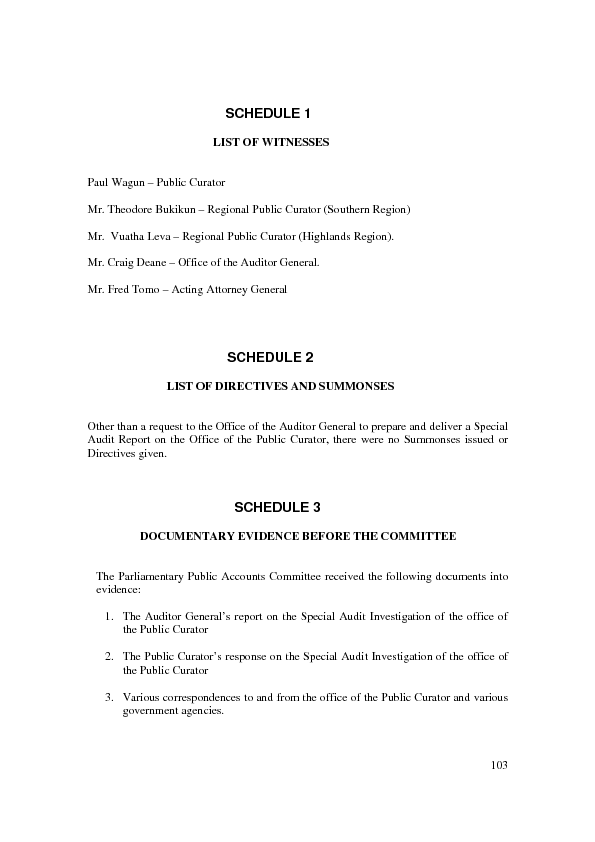Public Accounts Committee Inquiry into the Public Curator’s Office – Volume 1
Mentions of people and company names in this document
It is not suggested or implied that simply because a person, company or other entity is mentioned in the documents in the database that they have broken the law or otherwise acted improperly. Read our full disclaimer
Document content
-
PUBLIC ACCOUNTS COMMITTEE
INQUIRY INTO THE OFFICE OF THE PUBLIC CURATOR
REPORT TO NATIONAL PARLIAMENT
VOLUME 1.
CONTENTS
CONTENT PAGE
INTRODUCTION 7
EXECUTIVE SUMMARY 7
CHRONOLOGY 11
LIST OF ABBREVIATIONS 12
THE INQUIRY 13
COMPOSITION OF THE COMMITTEE 13
LITIGATION 14
JURISDICTION AND PURPOSE OF THE INQUIRY 16
JURISDICTION 17
The Constitution of the Independent State of Papua New Guinea 17
The Public Finance (Management) Act 18
Permanent Parliamentary Committees Act 19
-
Page 2 of 104
-
PURPOSE OF THE INQUIRY 19
THE AUTHORITY TO REPORT 19
THE AUTHORITY TO REFER 20
METHOD OF INQUIRY 21
RELEVANT STATUTES 21
Public Finances (Management) Act 21
Financial Instructions 22
Organic Law on the Duties and Responsibilities of Leadership 22
Audit Act 23
Permanent Parliamentary Committees Act 1994 23
Parliamentary Powers and Privileges Act 1964 23
Public Curator Act 1951 23
Wills and Probate Administration Act 1966 23
Insolvency Act 1951 23
Public Health Act 24
FISCAL RESPONSIBILITIES OF THE GOVERNMENT 24
RESPONSIBILITIES OF THE AUDITOR GENERAL 24
OFFICE OF THE PUBLIC CURATOR – FUNCTIONS AND POWERS 25
INQUIRY BY AND REPORT OF THE AUDITOR GENERAL 27
FINDINGS OF THE AUDITOR GENERAL 30
2
-
Page 3 of 104
-
RECOMMENDATIONS OF THE AUDITOR GENERAL 34
General Recommendations 34
Short Term Recommendations 35
Longer Term Recommendations 37
RESPONSE BY THE PUBLIC CURATOR 37
SPECIFIC ALLEGATIONS AND FINDINGS BY THE PUBLIC ACCOUNTS
COMMITTEE 38PUBLIC CURATOR’S OFFICE STAFFING 38
Auditor General’s Findings 38
Response of the Public Curator 40
Findings of the Public Accounts Committee 41
INTERNAL CONTROLS 42
Report of the Auditor General 42
The Response of the Public Curator 44
The Evidence 44
Findings of the Public Accounts Committee 45
PUBLIC CURATOR’S OFFICE OPERATIONAL FUNDING 45
Findings of the Auditor General 45
Response of the Public Curator 46
The Evidence 47
Findings of the Committee 50
3
-
Page 4 of 104
-
CHARGES BY THE PUBLIC CURATOR 51
Findings of the Auditor General 51
Response of the Public Curator 53
Evidence Before the Committee 54
Findings of the Public Accounts Committee 53
EXPENDITURE FROM ESTATE TRUST ACCOUNT 55
Report of the Auditor General 55
Response of the Public Curator 56
Findings of the Public Accounts Committee 56
PUBLIC CURATOR’S OFFICE ACCOUNTS AND RETURNS 57
Report of the Auditor General 57
Public Curator’s Response 57
Evidence Before the Committee 58
Findings of the Public Accounts Committee 58
BANK ACCOUNTS AND INVESTMENTS 58
REPORT OF THE AUDITOR GENERAL 58
INVESTMENT WITH FINANCE CORPORATION LIMITED 59
INVESTMENTS IN TREASURY BILLS 61
SAVINGS ACCOUNTS 62
INSOLVENCY ACCOUNT 63
ARREARS SETTLEMENT TRUST ACCOUNT 64
4
-
Page 5 of 104
-
CORPORATE TRUST ACCOUNT 66
SYSTEMS AND RECORDS 68
Report of the Auditor General 68
Response of the Public Curator 69
The Evidence 70
Findings of the Public Accounts Committee 70
EXTERNAL CONSULTANTS AND AGENTS 71
RAM BUSINESS CONSULTANTS 73
L.J. HOOKER 75
JACO BUSINESS CONSULTANTS 76
ANVIL PROJECT SERVICES 78
INAPPROPRIATE FINANCIAL TRANSACTIONS 80
FINDINGS OF THE AUDITOR GENERAL 80
FRAUDULENT CONDUCT BY EMPLOYEES OF THE PUBLIC CURATOR’S
OFFICE AND THIRD PARTIES 81RESPONSE OF THE PUBLIC CURATOR 87
FINDINGS OF THE PUBLIC ACCOUNTS COMMITTEE 87
TST SUPERMARKETS 88
Report of the Auditor General 88
Response of the Public Curator 88
Findings of the Public Accounts Committee 88
LEGAL ACTION BY BENEFICIARIES 89
5
-
Page 6 of 104
-
FINDINGS 89
OTHER ISSUES 89
PUBLIC OFFICERS SUPERANNUATION (POSF) 89
ESTATE PROPERTY MANAGEMENT 90
FINDINGS 90
POTENTIAL LIABILITY OF THE STATE 97
FINDINGS BY THE PUBLIC ACCOUNTS COMMITTEE 93
RESOLUTIONS AND RECOMMENDATIONS OF THE PUBLIC ACCOUNTS 97
COMMITTEEREFERRALS BY THE PUBLIC ACCOUNTS COMMITTEE 99
CONCLUSION 102
LIST OF WITNESSES – LIST OF WITNESSES 103
SCHEDULE 2 – LIST OF DIRECTIVES AND SUMMONSES 103
SCHEDULE 3 – DOCUMENTARY EVIDENCE BEFORE THE COMMITTEE 103
6
-
Page 7 of 104
-
PUBLIC ACCOUNTS COMMITTEE
INQUIRY INTO THE OFFICE OF THE PUBLIC CURATOR
REPORT TO NATIONAL PARLIAMENT
VOLUME 1.
1. INTRODUCTION
1.1. On the 13th April 2005 the Permanent Parliamentary Committee on Public
Accounts commenced a long running Inquiry into the operations of the
Office of the Public Curator.1.2. On the 1st March 2006 the Public Accounts Committee concluded the
Inquiry into the Office of the Public Curator.1.3. As a result of evidence taken in this Inquiry, the Public Accounts
Committee has made findings which were highly critical of the
performance of the Office of the Public Curator over many years. In
particular, the Public Accounts Committee has identified incidents of
fraud and criminal conduct, mismanagement of Estates, breach of trust and
breach of fiduciary duties on the part of the Public Curator and his Agents,
Contractors or Consultants.1.4. As a result of evidence and documents tendered to the Inquiry, the Public
Accounts Committee makes referrals of various persons for further
investigation and possible prosecution for breaches of their statutory
obligations.1.5. As a result of evidence and documents tendered to this Inquiry, the Public
Accounts Committee unanimously resolved to make a full and complete
Report of its Inquiry and findings to the National Parliament in accordance
with Section 17 of the Permanent Parliamentary Committees Act 1994
and 86(1) (c) and (d) Public Finances (Management) Act 1995.1.6. The Public Accounts Committee now tables the Report with strong
recommendation that remedial action be immediately taken by the
Government in accordance with findings and resolutions of the Public
Accounts Committee.2. EXECUTIVE SUMMARY
7
-
Page 8 of 104
-
2.1. The Office of the Public Curator is a national disgrace.
2.2. 19,600 Estates remain unresolved – some for more than 15 years.
2.3. 680 properties remain under trust – many for years with no resolution of
Estates.2.4. Over 700 properties have been mishandled or cannot be found or
accounted for.2.5. The history of the Office of the Public Curator over the last decade, shows
a disregard of the requirements of Law by managers and staff of the
Office, a failure to carry out statutory duties, a clear failure to understand
or implement the basic duties of a Trustee, instances of theft and fraud by
staff and third parties and an almost total failure of the Office to keep,
submit or understand accounts and financial Reports.2.6. The failure of the Office of the Public Curator has been contributed to by
failures of successive Governments to adequately or properly fund and
resource the Office.2.7. The failure of the Office of the Public Curator to attend to its duties and
properly and lawfully service Estates may have exposed the State to
significant liability.2.8. Monies allocated to the Office of the Public Curator by Government have
been misused and misapplied by the Public Curator and the Office of the
Attorney General.2.9. Estate monies, property and assets have been misused and misapplied by
the Public Curator and the Office of the Attorney General.2.10. The Public Curator has failed to lawfully retain Agents and Consultants to
the detriment of Estates and the liability of the State.2.11. The Public Curator and the Secretary for the Department of Justice and the
Attorney General have failed to lawfully appoint Agents, Consultants or
Contractors, paid those Contractors, consultants or Agents unlawfully,
failed to supervise or control those Contractors and wrongfully applied
Trust Monies to pay Contractors or Agents.2.12. Despite very considerable expense to Estates, there is little (if any) lasting
benefit from those Consultants and Agents.2.13. Trust monies are mixed between various accounts with no hope of
reconciling what money is owed to which Estate. The ability to trace trust8
-
Page 9 of 104
-
monies and assets is a basic duty of any Trustee. It has not been met by the
Public Curator.2.14. The Public Curator, the Attorney General and the Secretary for Justice
have failed to take action to recover property, money and assets
unlawfully detained or withheld by Consultants, Contractors or Agents to
the Public Curator.2.15. Estates have been overpaid or are owed large amounts of untraceable
money. The State may well be liable for these failures.2.16. The Public Curator has made unauthorized investments of Estate monies
and has failed to pay money back to Estate accounts or to maintain such
records as would enable that money to be paid to identified Estates.2.17. The Public Curator has unlawfully applied Estate monies to Operational
and administrative costs.2.18. The Public Curator has overcharged Estates for administration costs.
2.19. The Public Curator has created a deficiency in Estates of millions of Kina,
which the State may be liable to pay.2.20. The Public Curator, the Attorney General and the Secretary for the
Department of Justice have failed to take recovery action on behalf of
Estates against Agents, Contractors, Consultants and other entities to
recover money that was wrongly paid.2.21. The Public Curator and/or the Attorney General have failed to seek or
enforce an account from Consultants, Agents or Contractors to the Public
Curator, of all monies had and received by those entities for or on behalf
of the Public Curator or individual Estates.2.22. The Office of the Public Curator has failed to take reasonable care and use
due diligence to protect Estates under his management.2.23. Public Curators, past and present, have failed to understand or comply
with the obligations of a Trustee.2.24. Public Curators past and present have failed to take any or any adequate
care to identify, secure, preserve or realize monies, bank accounts, shares,
property and real estate assets of Estates.2.25. Public Curators have, in various ways, breached the terms of the Public
Curator Act and Regulations, Insolvency Act, and the Health Act.9
-
Page 10 of 104
-
2.26. Public Curators and Attorneys General, past and present, have failed to
comply with the terms of the Public Finances (Management) Act and the
Financial Instructions.2.27. Attorneys General have failed to account for or refund monies removed or
used from Estates.2.28. Consultants, Contractors and Agents have failed to account for or remit
monies received from Estates.2.29. Attorneys General, Secretaries for Justice and the Government have failed
to heed or action warnings and reports concerning the state of the Office
of the Public Curator.2.30. The Office of the Public Curator has failed to follow up and to commence
recovery action in respect of monies fraudulently taken from Estates.2.31. The Public Curator has failed to implement or maintain internal control
and accounting systems.2.32. The Public Curator has failed to give service to any acceptable level to
beneficiaries and Estates for many years and responds only to threats or
Court Action.2.33. Beneficiaries have been deprived of their entitlements by the failures of
the Public Curator.2.34. The Public Curator has failed to remit monies to Consolidated Revenue as
required.2.35. The Public Curator has failed to make Financial Reports as required.
2.36. Management, oversight, accountability and basic performance standards
are entirely lacking in the Office of the Public Curator with a resultant
lack of public confidence in the Office.2.37. Urgent action is required to restore any credibility to the Office of the
Public Curator.2.38. The Committee commends the findings and recommendations made in
this Report, in the Report of the Auditor General and by the Office of the
Public Curator itself, as a basis for rebuilding the Office of the Public
Curator.2.39. The Government must move to establish a method whereby aggrieved
persons can have their entitlements quickly assessed and paid.10
-
Page 11 of 104
-
2.40. The Government must, as a matter of urgency, establish an Inquiry to
investigate and conclude on the likely extent of State liability arising from
failures of the Office of the Public Curator.2.41. The State must then make provision to meet its liabilities to Estates and
beneficiaries.2.42. Interim Trustee arrangements must be quickly established to take control
of the Office of the Public Curator pending long term rebuilding.2.43. The Statutes under which the Public Curator operates must be modernized
and a long term, credible trustee arrangement be established.2.44. Urgent recovery action must be taken to recover monies identified by the
Auditor General and this Committee, as wrongly withheld or removed
from Estates.2.45. The Public Curator and his management team should be replaced by
competent, experienced interim trustees – possibly from POSF or
Nasfund.2.46. The Government should recruit, by domestic and International
advertisement, a competent and experienced Public Curator and
management team experienced in Trustee obligations and accountability to
rebuild the Office of the Public Curator.2.47. Certain further findings are made by the Public Accounts Committee. See
Para 45.2.48. Certain further recommendations are made by the Public Accounts
Committee. See Para 46.2.49. Certain Referrals for Investigation and possible prosecution are made by
the Public Accounts Committee. See Para 47.3. CHRONOLOGY
3.1. The Public Accounts Committee commenced its Inquiry into the Office of
the Public Curator on the 13th April 2005.3.2. The Inquiry again convened on the 28th November 2005.
3.3. The Inquiry again convened on the 1st March 2006 and finished on that
day.11
-
Page 12 of 104
-
3.4. On the 13th April 2005 the Public Accounts Committee directed the Office
of the Auditor General to conduct a Special Audit of the Office of the
Public Curator.3.5. The Public Accounts Committee requested the Public Curator give full
and complete assistance to the Auditor General in the performance of that
Audit.3.6. The Office of the Auditor General considered this request to be of interest
to the general public and directed that, in accordance with Section 8 (2) of
the Audit Act, the investigation be undertaken in accordance with the
Terms of Reference given by the Committee. These Terms of Reference
are recorded in Para. 15.9 of this Report.3.7. The Office of the Public Curator complied adequately with the request, but
failed to produce many documents and records to the Auditor General3.8. The Office of the Auditor General complied with the request and produced
a detailed Special Audit Report.3.9. An Auditor General’s Report on the Special Audit Investigation of the
Office of the Public Curator was completed and delivered to the Public
Accounts Committee on the 1st November 2005. A copy of that Report is
contained in Volume 2 of this Report.3.10. A copy of the Audit Investigation Report was delivered to the office of the
Public Curator for perusal and response. The Public Curator delivered a
Response to the Special Audit Investigation Report on the 28th day of
November 2005. That Response is also contained in Volume 2 of this
Report.3.11. The Public Accounts Committee has given careful consideration to both
the Report of the Auditor General and the Response from the Public
Curator4. LIST OF ABBREVIATIONS
Anvil Anvil Project Services Ltd.
CSTB Central Supply and Tenders Board
Jaco Jaco Business Consultants Ltd.
PF (M) A Public Finances (Management) Act
12
-
Page 13 of 104
-
PAC Public Accounts Committee
The Committee The Public Accounts Committee
The Constitution The Constitution of the Independent State of Papua
New GuineaThe National Court The National Court of Justice of Papua New Guinea
The Public Curator The Office of the Public Curator
Agent or Agents means an Agent of the Public Curator appointed by
the Public Curator or the Attorney General.5. THE INQUIRY
COMPOSITION OF THE COMMITTEE
5.1. The Public Accounts Committee which sat and made Inquiry into the
Department of Lands and Physical Planning was constituted as follows:13th April 2005:
1. Hon. John Hickey MP – Chairman
2. Hon Michael Maskal MP – Member.
3. Hon Tony Aimo MP – Member
4. Hon. Dr. Bob Danaya MP – Member
5. Hon. Sasa Zibe MP – Member
6. Hon Ekis Ropenau MP – Member
28th November 2005:
1. Hon. John Hickey, MP – Chairman
2. Hon. James Togel, MP – Member
3. Hon. Michael Mas Kal, MP – Member
4. Hon. Dr. Bob Danaya, MP – Member
13
-
Page 14 of 104
-
5. Hon. Dr. Allan Marat, MP – Member
1st March 2006:
1. Hon. John Hickey, MP – Chairman
2. Hon. Chris Haiveta, MP – Deputy Chairman
3. Hon. John Vulupindi, MP – Member
4. Hon. Sasa Zibe, MP – Member
5. Hon. Michael Mas Kal, MP – Member
6. Hon. Dr. Bob Danaya, MP – Member
7. Hon. Malcolm Smith Kela, MP – Member
5.2. Also present at the Inquiry were Officers of the Public Accounts
Committee, Officers of the Auditor General’s office, Officers of the
Department of Finance and the following Officers of the Public Curator:1. Mr Paul Wagun – Public Curator
2. Mr Theodore Bukikun, Regional Public Curator (Southern Region)
3. Mr Vuatha Leva – Regional Public Curator (Highlands Region)
5.3. The Chairman, Deputy Chairman and Members of the Committee were
properly and lawfully appointed and empowered to sit as a Public
Accounts Committee.6. LITIGATION
6.1. The Auditor General’s Report on the Special Audit Investigation of the
Office of the Public Curator contained certain findings against Contractors
and/or Agents retained by the office of the Public Curator.6.2. One of those Consultants was RAMS Business Consultants – a company
apparently owned and operated by a Rex Paki.6.3. On the 25th day of November 2005, Rex Paki and RAMS Business
Consultants obtained an ex parte Restraining Order from the National
Court of Justice.14
-
Page 15 of 104
-
6.4. That Order purported to restrain the Public Accounts Committee from
considering any part of the Report of the Auditor General into the Office
of the Public Curator which dealt with either RAMS Business Consultants
or its principal, Mr Rex Paki, upon the basis that neither party had any
opportunity to be heard in answer to the Report.6.5. Before this action was commenced, the Committee had extended the
opportunity to respond or appear to give evidence to Mr. Paki and RAMS.6.6. Attempted service of the Order was made on 28th day of November 2005.
That purported service breached Section 14 of the Parliamentary Powers
and Privileges Act 1964. That Section states:Section 14 SERVING OF PROCESS WITHIN THE PRECINCTS
(1) A person who, on a day in respect of which this Section applies,
and within the precincts of the Parliament –a) Serves, tenders for service or executes any Writ,
Summons, Warrant, Order or other process issued by or
with the Authority of any Court or otherwise in
accordance with any law; orb) …
is guilty of an offence;
Penalty: A fine not exceeding K400.00 or imprisonment for a term not
exceeding 6 months.(2) This Section applies in respect of –
a) …
b) A day fixed by a Committee of the Parliament to be a day on
which the Committee will sit.”6.7. The Committee has referred the Process Server to the Office of the
Speaker of the Parliament for prosecution in accordance with Section 39
of the Parliamentary Powers and Privileges Act 1964.6.8. On the 13th December 2005, the National Court of Justice refused to
continue or remake the Restraining Order. Her Honour Davani J. said;15
-
Page 16 of 104
-
“The Plaintiffs make no appearance. There is no restraining order in
place. The PAC should not be hindered from carrying out its lawful
activities and should do so”.6.9. The Public Accounts Committee continued with the Inquiry into the
Office of the Public Curator and concluded the Inquiry on the 1st March
2006.6.10. Neither RAMS nor Mr. Paki made any submission to the Committee.
7. JURISDICTION AND PURPOSE OF THE INQUIRY
INTRODUCTION
7.1. The Public Accounts Committee received a large number of very serious
allegations of misconduct leveled against the Office of the Public Curator
and its staff. Those reports and complaints extended over many years.7.2. The Committee considered that the Office of the Public Curator fulfills a
unique and highly important role in Papua New Guinea society.7.3. The Public Curator is a Trustee who is responsible for the administration
and finalization of the assets of, inter alia, deceased Estates and Estates of
persons under disability.7.4. By mid 2003 the Auditor General had provided reports and audits to the
Minister of Justice and Attorney General concerning the financial
statements of the Public Curator’s Office.7.5. This Report was tabled in Parliament and it was immediately evident that
the Auditor General was unable to determine the accuracy of virtually any
information recorded in the financial statements due to the chaotic state of
the Office of the Public Curator.7.6. The Auditor General identified significant failures in those financial
accounts, serious financial and administration problems and wide
mismanagement at all levels within the Office of the Public Curator, over
a long period of time.7.7. These conclusions were not new. The Committee notes that, in 1999, the
Auditor General was unable to provide any opinion as to the reliability of
financial statements and the 1999 Audit Report identified significant
shortcomings in record-keeping and control within the Office of the Public
Curator.16
-
Page 17 of 104
-
7.8. That the Government has failed to address these findings in the last five
years is unacceptable.7.9. As a result of these complaints and Reports, the Public Accounts
Committee resolved to request a Special Audit Investigation into the
Public Curator of Papua New Guinea, from the Office of the Auditor
General.7.10. The Public Accounts Committee received the Special Audit Report and
was so concerned at the findings, that the Committee deemed this Inquiry
into the Office of the Public Curator to be a matter of National interest
pursuant to Section 17 of the Permanent Parliamentary Committees Act
and commenced a two-day Inquiry into the state of that Office.7.11. At the conclusion of the Inquiry, the Committee resolved to report to the
National Parliament its Findings, Resolutions, Recommendations and
Referrals.7.12. At all times, the Committee has taken great care to enable all witnesses to
make full and complete representations and answers to any matter before
the Committee – in particular those matters about which the Committee
may make adverse findings against individuals or companies.7.13. The Committee received and considered submissions from JACO Ltd.,
L.J. Hooker Ltd. And Anvil (PNG) Project Services These documents are
presented in Volume 2 of this Report.7.14. The Public Accounts Committee has given careful consideration to all
responses and to all evidence given before the Committee.7.15. All evidence was taken on oath and full and due Inquiry was made of all
relevant State Agencies where the Committee considered those Inquiries
to be necessary.JURISDICTION
THE CONSTITUTION OF THE INDEPENDENT STATE OF PAPUA
NEW GUINEA7.16. The Committee finds its jurisdiction firstly, pursuant to Section 216 of the
Constitution of the Independent State of Papua New Guinea. That
Section reads:“216. Functions of the Committee
17
-
Page 18 of 104
-
(1) The primary function of the Public Accounts Committee is, in
accordance with an Act of the Parliament, to examine and report
to the Parliament on the public accounts of Papua New Guinea
and on the control of and on transaction with or concerning, the
public monies and property of Papua New Guinea”.(2) Sub-section (1) extends to any accounts, finances and property that
are subject to inspection and audit by the Auditor General under
Section 214 (2) … and to report by the Auditor General under that
Sub-section or Section 214 (3)…”.7.17. The Committee has taken care to restrict its Inquiry to an examination of
the control of and transactions with or concerning the public monies and
property of Papua New Guinea by the Office of the Public Curator and its
Officers.7.18. Whilst considering the relevant provisions of the Constitution, the
Committee has had regard to the Final Report of the Constitutional
Planning Committee 1974 and been guided by or applied the stated
intentions of that Committee wherever necessary.7.19. Whilst engaged in the Inquiry the Committee was guided by two
definitions contained in the Constitution, which are directly relevant to
Section 216 of the Constitution. They are:“Public Accounts of Papua New Guinea” includes all accounts, books
and records of, or in the custody, possession or control of, the National
Executive or of a public officer relating to public property or public
moneys of Papua New Guinea;”and
“Public moneys of Papua New Guinea” includes moneys held in trust by
the National Executive or a public officer in his capacity as such,
whether or not they are so held for particular persons;”THE PUBLIC FINANCES (MANAGEMENT) ACT 1995
7.20. The Public Accounts Committee also finds its jurisdiction to inquire into
the Office of the Public Curator in Section 86 of the Public Finance
(Management) Act 1995. That Section empowers the Committee to
examine accounts and receipts of collection and expenditure of the Public
Account and each statement or Report of the Auditor General presented to
the Parliament.18
-
Page 19 of 104
-
7.21. The Office of the Public Curator receives, spends, and is accountable for
public monies.7.22. The Committee has considered both accounts and receipts of public
monies as they have been made available by the Office of the Public
Curator and such Reports of the Auditor General as may have been
presented to Parliament.7.23. The Committee has further considered reports of the Auditor General
which have not yet been presented to the Parliament, on the basis that that
evidence was tendered by the Auditor General for the consideration of the
Committee and on the basis that such material is within the power of the
Committee to consider.7.24. Power to refer matters for investigation and possible prosecution is
granted to the Committee by Section 86A of the Public Finances
(Management) Act.PERMANENT PARLIAMENTARY COMMITTEES ACT 1994:
7.25. The Committee found further jurisdiction for the Inquiry in Section 17 of
the Permanent Parliamentary Committees Act.7.26. That Section provides that the Public Accounts Committee can consider
any matter of national importance, on its own initiative. The Committee,
as we have stated, considers the Office of the Public Curator to be such a
matter.PURPOSE OF THE INQUIRY
7.27. The Public Accounts Committee conducted this Inquiry to establish the
standard to which and the competence and honesty with which the Office
of the Public Curator has fulfilled its role as the Trustee of Estates – and
therefore its statutory position as the State appointed, funded and
accountable Trustee.7.28. The Public Accounts Committee conducted this Inquiry to establish
whether the Public Curator, in all its operations, complied with all lawful
requirements and, if not, to make recommendations for change.7.29. The Public Accounts Committee conducted this Inquiry to establish the
exact state of Estates managed by the Office of the Public Curator and the
liability of the State (if any) for failings within the Office of the Public
Curator.8. THE AUTHORITY TO REPORT
19
-
Page 20 of 104
-
8.1 The Public Accounts Committee finds authority to make this Report in
Section 17 of the Permanent Parliamentary Committees Act and Section
86 (1) (c) and (d) (i), (ii), (iii) and (iv) and (f) of the Public Finances
(Management) Act 1995.9. THE AUTHORITY TO REFER
9.1. Where satisfied that there is a prima facie case that a person may not have
complied with the provisions of the Constitution of the Independent State
of Papua New Guinea and / or the Public Finances (Management) Act
1995 in connection with the control and transaction with and concerning
the accounts of a public body or the public moneys and the property of
Papua New Guinea, it may make referrals of that person to the Office of
the Public Prosecutor in accordance with Section 86A of the Public
Finances (Management) Act.9.2. The Public Accounts Committee is not a true investigatory body capable
of investigating and/or prosecuting persons for breaches of the law. The
Committee is required to refer such matters to the appropriate authorities
and may make such recommendations as it thinks fit in relation to any
referral made pursuant to Section 86A of the Public Finances
(Management) Act 1995.9.3. The Committee is also empowered to refer for prosecution, any witness
who fails to comply with a Notice to Produce any document, paper or
book and / or any person who fails to comply with a Summons issued and
served by the Committee. See Section 23 Permanent Parliamentary
Committees Act.9.4. The Public Accounts Committee refers past and present Public Curators,
past and present Attorneys General and staff of the Office of the Public
Curator for investigation of the alleged failures to carry out their duties
and subsequent prosecution, should the investigating authorities adopt that
course.9.5. Those referrals were made after anxious consideration of the evidence and
explanations given by the Public Curator and other witnesses. These
parties were invited to make any response or show any reason why they
should not be referred, but have made no or no adequate response to the
Committee in this regard.9.6. The Committee knows that to make Referrals, particularly of senior Public
Servants is a very serious matter which may adversely reflect on the
individual concerned. These Referrals are not made lightly but only after
careful consideration and unanimous resolution of the Committee.20
-
Page 21 of 104
-
10. METHOD OF INQUIRY
10.1. The Inquiry by the Public Accounts Committee into the Public Curator
was a public hearing at which sworn evidence was taken from a small
number of witnesses. A list of witnesses is contained in Schedule 1 to this
Report.10.2. The Public Accounts Committee received a large number of documents
and reports. Those documents are listed in Schedule 3 of this Report and
are contained in Volume 2 of this Report.11. RELEVANT STATUTES
11.1. The Committee was required to consider the following Statutes during the
course of the Inquiry:PUBLIC FINANCES (MANAGEMENT) ACT 1995.
11.2. The Public Finances (Management) Act prescribes the method and
standard of the administration of and accounting for public monies, public
properties and assets by State entities in Papua New Guinea.11.3. Further, the Act imposes certain obligations on Public Servants for
collection of State revenue and controls the expenditure of State or public
monies.11.4. Relevant sections of the Act which were considered by the Public
Accounts Committee during the course of the inquiry into the Office of the
Public Curator are:(i) Section 5 – Responsibilities of Heads of Department
This Section prescribes the duties, powers and obligations of a Head
of Department.(ii) Section 3 – Responsibilities of the Minister
This Section prescribes the obligations and duties of relevant
Ministers of State.(iii) Part x – The Public Accounts Committee
This Part empowers and imposes functions and obligations on the
Public Account Committee. In particular, the Committee was
required to consider Section 86 (A) – power to refer officers of the21
-
Page 22 of 104
-
Public Curator to the Office of the Public Prosecutor for
investigation and possible prosecution relating to breaches of the
Public Finances (Management) Act 1995 and/or the Constitution.(iv) Part xi – Surcharge
This Section prescribes personal liability for certain public servants
who fail in their obligations to collect and protect certain public
monies.(v) Section 112 – Offences
This Section prescribes disciplinary action which may be taken
against certain public servants or accountable officers who fail to
comply with the terms of the Public Finances (Management) Ac
1995.FINANCIAL INSTRUCTIONS
11.5. Section 117 of the Public Finances (Management) Act 1995 enables
the promulgation of certain Financial Instructions which establish
detailed procedures for the handling, collection, expenditure, disposal of
and accounting for public monies, property and stores.11.6. The Public Accounts Committee had regard to these Financial
Instructions when considering the performance of the Office of the
Public Curator and its relevant responsible officers.11.7. In particular, the Committee had regard to:
Part 6 Division 1 Para. 2.1 – ACCOUNTABLE OFFICERS.
“…..the Departmental Head is liable under the doctrine of personal
accountability to make good any sum which the Public Accounts
Committee recommends should be “disallowed””.ORGANIC LAW ON THE DUTIES AND RESPONSIBILITIES OF
LEADERSHIP11.8. The Public Accounts Committee has had regard to this Organic Law in the
course of the Inquiry into the Office of the Public Curator. Certain
referrals and resolutions were considered within the terms of this Organic
Law and are more fully developed (infra).AUDIT ACT
22
-
Page 23 of 104
-
11.9. The Audit Act establishes and empowers the office of the Auditor General
to carry out its work of overseeing and supervising the handling of public
monies, stores and property by all arms of the National Government. The
Public Accounts Committee had regard to the terms of this Act during the
course of the inquiry into the Office of the Public Curator.11.10. The Committee received considerable assistance from the Office of the
Auditor General in the course of this Inquiry.PERMANENT PARLIAMENTARY COMMITTEES ACT 1994
11.11. The Committee has had regard to Section 17 of the Permanent
Parliamentary Committees Act 1994 during the course of the Inquiry into
the Office of the Public Curator.PARLIAMENTARY POWERS AND PRIVILEGES ACT 1964
11.12. The Parliamentary Powers and Privileges Act 1964 sets forth those
privileges and powers extending to Members of Parliament, Committees
of Parliament and Officers or Parliamentary Staff.11.13. In the course of this Inquiry, the Committee had cause to examine and
apply Sections 14 and 39 of that Act.` PUBLIC CURATOR ACT 1951
11.14. The Public Accounts Committee had given detailed consideration to the
Public Curator Act 1951. This Act establishes and empowers the Public
Curator in all its aspects of operation.11.15. The Public Accounts Committee had particular reference to Parts II, III, V
and VI of this Act.WILLS AND PROBATE ADMINISTRATION ACT 1966
11.16. The Public Accounts Committee had general regard to the terms of this
Act – as it deals with the Administration of deceased estates by the Public
Curator both intestate and testate.INSOLVENCY ACT 1951
11.17. The Committee had regard to the Insolvency Act 1951 where that Act
enables the Public Curator to act as a Trustee for Wills, Deeds of Trust
and other Trust Investments or to act as Executor, Distributor and
Administrator of deceased estates or Insolvent Estates.23
-
Page 24 of 104
-
PUBLIC HEALTH ACT Ch. 226
11.18. The Public Accounts Committee had regard to the terms of the Public
Health Act insofar as that Act appoints the Public Curator to act as trustee
or Manager of properties or affairs of persons certified insane, infirm, or
incapable of managing their own affairs.11.19. It is against this statutory background that the Public Accounts Committee
conducted this Inquiry.12. FISCAL RESPONSIBILITIES OF THE GOVERNMENT
12.1. The Government of Papua New Guinea is obliged to adequately fund and
resource the Office of the Public Curator.12.2. The Office of the Public Curator is accountable to the Office of the
Attorney General and this Committee concludes that the Office of the
Attorney General is responsible for ensuring adequate and proper funding
and resourcing of the Office of the Public Curator.12.3. This Committee finds that the Office of the Public Curator has been very
considerably under-financed and under-resourced for many years.12.4. The Committee finds that this failure by Government has and will result in
very significant exposure of the State to liability for mismanagement,
incompetence and corrupt conduct within the Office of the Public Curator.12.5. The Committee also finds that the Government owes a further obligation
to adequately and properly oversight and control the Office of the Public
Curator. Both the Department of Justice, the Attorney General and the
State have completely failed to fulfil this obligation.12.6. The Committee makes certain findings and Referrals in this regard, later in
this Report.13. RESPONSIBILITES OF THE AUDITOR GENERAL
13.1. The Auditor General is a Constitutional Office Holder and the duties and
responsibilities of that Officer are contained in the Audit Act 1989.13.2. The standard of the Reports of the Auditor General into the Office of the
Public Curator are found by this Committee to be both competent,
detailed and correct.
.
13.3. The Committee fully understands the severe staffing constraints attending
the Office of the Auditor General and will make recommendations in24
-
Page 25 of 104
-
respect of the funding and resourcing of that Office by the Government of
Papua New Guinea, to enable it to carry out its statutory duty in a
competent and timely manner.14. OFFICE OF THE PUBLIC CURATOR – FUNCTIONS AND POWERS
14.1. The Office of the Public Curator is established and operated under the
Public Curator Act 1951 (“the Act”). The major functions of the Public
Curator are:• Administration of deceased Estates both intestate and testate under
the Wills and Probate Administration Act 1966.• To act as agent or attorney for Estates.
• Act as Trustee under the Insolvency Act 1951 for Wills, Deeds of
Trust and other Trust Investments, and as an Executor, Distributor
and Administrator of deceased Estates;• Act as trustee for minors properties;
• Act as Official Trustee to administer Estates adjudged insolvent by
the National Court in accordance with the Insolvency Act 1951; and• Act as Trustee or Manager for the management of properties of
persons certified insane, infirm or incapable of managing their own
affairs under the Public Health Act 1973.14.2. The Public Curator’s office is located in Port Moresby with regional
offices in Rabaul, Lae and Mt Hagen.14.3. The Public Curator acts as Trustee and accepts all the onerous
responsibilities of a Trustee administering money and property of
deceased persons for the benefit of named and identified beneficiaries.14.4. The Public Curator also stands in a fiduciary relationship to the Estate and
its beneficiaries, with all the duties and obligations attending such a
relationship.14.5. The Committee finds that the Public Curator owes very strict obligations
to carry out the work of a Trustee in a lawful and efficient manner.14.6. The Committee considers that the position of Public Curator requires the
appointment of a person with highly specialized training, experience and
qualifications.25
-
Page 26 of 104
-
14.7. Moreover, that position and all staff positions within the Office of the
Public Curator require high standards of probity, accountability, analysis
and judgement by persons who hold those offices.14.8. This Committee finds that those attributes have been lacking for many
years.14.9. In order to carry out these obligations the Office of the Public Curator
requires sufficient trained and competent staff or trained and efficient and
honest contractors that possess the appropriate skills and experience to
undertake these responsibilities.14.10. This Committee finds that these skills and experience have been lacking
for many years.14.11. The skills required are legal, financial, accounting/management,
investment and property management, office support, public management
and capacity to deal quickly and honestly with property entrusted to the
Office.14.12. The Committee finds that the Public Curator also owes a moral and ethical
responsibility to beneficiaries and that the person holding the Office of
Public Curator must be trained and experienced in carrying out this highly
specialised statutory role, but has failed to meet those obligations.14.13. The Public Curator has the power to appoint Agents to carry out certain
functions – see Section 4 Public Curator Act.14.14. This Committee considers that the position of Agent, contractor or
consultant of the Public Curator requires the appointment of persons of
high repute, honesty and competence.14.15. This Committee concludes that those attributes were lacking in the
majority of Agents so appointed.14.16. The Committee finds that Consultants, contractors and agents to the Public
Curator were unlawfully appointed and were often incompetent or
ineffective.14.17. In order to carry out his statutory role in an efficient manner, the Public
Curator should be free of inter-meddling by any person.14.18. This Committee finds that there is evidence of considerable interference in
the management and financial operation of the Public Curator’s Office by
the Department of Justice and Attorney General. This Committee makes
findings concerning that interference later in this Report.26
-
Page 27 of 104
-
14.19. Equally, this Committee finds that when the Attorney General should have
intervened in the operations of the Public Curator – he did not, to the
detriment of the Office, the State and beneficiaries.14.20. The Committee finds that the Office of the Public Curator has, for many
years, failed to carry out its function in anything like a competent manner.14.21. Criminal dealings, fraud, forgery, incompetence and non-accountability
have resulted in gross mismanagement of a huge number of Estates which
may result in a significant liability to the State for those failures.15. INQUIRY BY AND REPORT OF THE AUDITOR GENERAL
15.1. On the 13th June 2003 the Auditor General reported to the Minister of
Justice and Attorney General on the financial statements of the Public
Curator’s Office for the year ending 31st December 2000. This report was
tabled in the Parliament.15.2. In that report the Auditor General found that
“financial statements were prepared from incomplete and insufficient
records resulting in the limitation of scope of my audit work. As a
result, it was impractical to extend my audit procedures sufficiently to
determine the accuracy of the information recorded in the financial
statements”.15.3. The Auditor General identified and described serious failures in the
financial accounts and raised matters which, prima facie, suggested a
failure of the Trustee to act in a proper and lawful manner.15.4. More significantly, the report identified serious financial and
administrative mismanagement over a long period.15.5. In 1999 the Auditor General undertook an audit of the financial statements
for the period ending 31st December 1991 and in October 1999, provided a
qualified audit opinion on these financial statements.15.6. The Auditor General could not then form an opinion as to whether the
financial statements were based on proper accounts and records or whether
the financial statements showed fairly the state of affairs of the Public
Curator’s office as at the 31st December 1991.That audit reported:-
• Incomplete reporting
27
-
Page 28 of 104
-
• Accounting records either non existent or not made available
• Inability to verify bank balance and cash books which could not be
reconciled.• A Register of Assets belonging to Estates had not been maintained.
• Inadequate accounting for investments.
• Inadequate management of investments.
• Estate and trust accounts that had been static for up to 20 years when
the Public Curators Act 1951 require these to be remitted to the
Consolidated Revenue Fund• The Estate records had not been reconciled.
• Fees and Commissions charged on Estates had not been paid into
Consolidated Revenue on a regular basis.15.7. On the 13th April 2005 the Parliamentary Public Accounts Committee
commenced an inquiry into the office of the Public Curator.15.8. The Public Accounts Committee resolved to request the Auditor General
to carry out a Special Audit Investigation of the office of the Public
Curator of Papua New Guinea.15.9. The Public Accounts Committee set the following Terms of Reference for
the Auditor General:1. To review the Public Curators Act to ascertain compliance by the
Public Curator’s office in terms of administration of Estates.2. To review compliance with the Act in terms of investment and
distribution of deceased Estates.3. In reviewing compliance with (1) and (2), ascertain the legitimacy
and appropriateness of specific decisions and actions concerning the
administration of deceased Estates.4. Establish whether proper accounts and records were maintained by
the Public Curator’s office in accordance with the Public Curators
Act and other relevant legislation including an investigation into
bank accounts, Estate accounts and records, office accounts and
returns.28
-
Page 29 of 104
-
5. Establish lapses in the system and ascertain reasons for such lapses.
6. Establish whether any misappropriation, theft or fraud might have
occurred as a result of any weakness in the system, particularly
during the time of the previous management and also under the
current management.7. Review engagement of Consultants and ascertain whether proper
procedures were followed for such engagement and also examine the
scope of work and reports prepared by the Consultants and examine
whether Certificates of Compliance were in place8. Review the Insolvency Act and the Companies Act to see whether
the Public Curator has complied with those Acts9. Review the internal control procedures in place to establish their
adequacy and effectiveness.10. Review the audit report issued under Section 8 (2) of the Audit Act
for the year ended at 31st December 2000 to establish whether any
misappropriation, theft or fraud might have occurred during the
period under audit.11. Establish whether the current management has taken necessary
action to improve control systems covering audit qualifications
issued on the 13th June 2003.12. Based on the qualifications in the Auditor General’s Report for the
year 2000, investigate fully and provide the necessary documentary
evidence in addition to the information that has been collected to
support the Audit qualifications.15.10. The Auditor General reports that the scope of the audit was handicapped
by failures within the Public Curator’s Office. These failures are:• Lack of audit trail;
• The Public Curator’s Office has no proper accounting system in
place. The Financial Statements were prepared by the Auditor by
relying only on insufficient manual cash book without proper
distribution of accounts. In addition, the Office did not maintain any
General Ledger and any General Journal. Subsidiary books such as
staff advances and various creditors lists were not kept.29
-
Page 30 of 104
-
• The Committee finds this is a fundamental breach of the
requirements of the Public Finances Management (Act) and the
Financial Instructions.• The Public Curator does not maintain proper books of accounts. The
Financial Statements were prepared from incomplete and insufficient
records resulting in the limitation of scope of the audit. The audit
was unable to determine the accuracy of the information recorded in
the financial statements.• Again, the Committee finds that this is a fundamental breach of the
Public Finances (Management) Act and Financial Instructions.• There is no reliable system of control over the Estate ledger
accounting on which the Auditor could rely for the purpose of the
audit. In particular, the Auditor was not able to satisfy himself as to
the accuracy of the bank reconciliation or completeness of the Public
Curator’s books, was unable to obtain sufficient audit evidence
concerning the accuracy and completeness of opening balances of
assets and liabilities in the Estate ledger.16. FINDINGS OF THE AUDITOR GENERAL
16.1. The Auditor General reports the following conclusions:
• That, in 2001, an independent Consultant commissioned by the
Public Curator produced a strategy for addressing the problems of
that Office and a future plan. The Auditor General finds little
evidence that those strategies/recommendations have been acted on.• The Office of the Public Curator has, for many years, acted in an ad
hoc manner with no obvious direction or plan. That situation
continues to the present day.• There are significant problems with staff numbers, skills and
qualification, financial and other resources, additional appropriation,
facilities, procedures and manual and computer systems required to
support the operations of the Office of the Public Curator.• Limited evidence of any action to address staff numbers, skills and
qualifications, financial and other resources, additional
appropriation, facilities, procedures and manual and computer
systems required to enable the Public Curator to competently carry
out his statutory duty.30
-
Page 31 of 104
-
• The Public Curator has failed to establish policies and practices
essential for the effective operation of the Public Curator’s Office,
including the establishment of control structures;• A failure to secure sufficient and appropriate resources for the Public
Curator’s Office to operate effectively;• A failure to manage the activities of Agents resulting in significant
and unlawful losses to Estates;• A failure to finalise Estates in a timely manner;
• A failure to maintain proper accounting records and documentation
relating to the financial matters and the management of Estates;• A failure to provide any proper accounting for its operation since
1991 or provide satisfactory financial reports;• A failure to maintain proper accounting records relating to the
operations of the Public Curator’s Office;• A failure to fully and accurately identify and value the extent of
Estates;• A failure to manage and maintain assets, including properties, that
make up Estates;• A failure to manage and effectively account for investments;
• A failure to remit commissions received to the Consolidated
Revenue Fund as required by the Public Curators Act 1951 and of
Section 211(2) Constitution;• A failure to remit monies to the Consolidated Revenue Fund relating
to Estate investment and property not resolved within a period of six
years as required by Section 17 of the Public Curators Act 1951;• A failure to protect the assets of Estates and as a result significant
amounts of money and assets held in trust have been lost through
poor management and fraud;• A failure to manage large Consultancies effectively, and as a result of
this mismanagement, has not received any benefits from significant
expenditures;31
-
Page 32 of 104
-
• A failure to take action to recover monies lost or to act against
individuals or organizations responsible; and• A failure to provide any level of effective customer service to
beneficiaries, responding only to Court actions and threats by
beneficiaries;• That the Public Curator has failed to discharge his responsibilities as a
Trustee and this failure extends to assets of the Estates, money, plant
and properties.• That a significant amount of Trust money has been lost through fraud
or has been spent and cannot be accounted for – this results from
inadequate financial management and/or illegal expenditure on
operating costs of the Public Curator’s Office.16.2. More specifically, the Auditor General finds that the Public Curator has
charged Commissions far in excess of that allowed by the Public Curator
Regulations and cannot reconcile the Commissions removed from Estate
monies, to individual Estates.16.3. Further, monies collected as Commissions have been used to offset the
running and operational cost of the Public Curator’s Office rather than
being remitted to the Consolidated Revenue Fund.16.4. This appalling litany of conclusions is compounded by a finding that over
K 2.5 Million provided by the Government specifically to meet shortfalls
in the Estate Trust Account caused by the inappropriate use of trust
monies by the Public Curator’s Office, has not been used for this purpose
but has been employed to discharge operating debts of the Public
Curator’s Office16.5. This blatant misuse of the allocated public funds requires urgent referral
and investigation by the relevant investigatory Agencies.16.6. The Auditor General concludes that the Department of Finance has an
obligation regarding the review and monitoring of Trust Accounts.
However, clearly, in the case of the Public Curator’s Office, the
Department of Finance has completely failed to meet those obligations.16.7. On the 13th June 2000 Mr Nouairi, the Acting Public Curator, reported
that:“At the moment, the Office is under strength in manpower. It lacks
basic skills and administrative knowledge in administering matters
that fall under the Public Curator’s responsibilities.32
-
Page 33 of 104
-
………………………..
Customer service is chaos (sic) and attending queries for the
customers is even embarrassing because the information required
either no existence (sic) or misplaced. Many estates have been in our
custody for ages without attempting to grant them the probate or
obtaining letters of administration for their releases.The Office is inundated with legal threats of unnecessary
procrastination of obtaining probates, and non responses to letters
from the clients since September last year.It should not be a surprise to anyone because the personnel are
insensitive to the public pressures or indifference (sic) to their
responsibilities. Given this background you can draw your own
conclusions of the problems the Public Curator has in attempting to
discharge his statutory responsibilities”.16.8. It is therefore clear that as early as 2000, at least some of the problems
were known to the Office of the Public Curator itself.16.9. The Acting Public Curator continued:
“… State of Administration of numbers of estates which I have
examined is very appalling … as they involved huge amounts of
overpayments. Due to lack of proper checks and balances, there are no
audit records and situational reports; it is possible that the estate records
may not be completely accurate.… Overpayments are attributed to a number of things. The officials are
incompetent in their duties which contributed to this mess. Records are
missing, cheques have been written without authority by subordinates
and no proper control of accounts and lack of audits for the last decade
has led to the demise of this office’s integrity”.16.10. The Auditor General concludes that the situation reported some five years
ago, still prevails.16.11. The Auditor General concludes that fraud and inappropriate use of Estate
monies to fund the operation of the Public Curator’s Office means that
there is a significant gap between Estate assets held by the Public
Curator’s Office and its liabilities to beneficiaries of deceased estates.16.12. The Auditor General continues:
33
-
Page 34 of 104
-
“Due to the deplorable state of the Public Curator’s Office financial
records, I am not able to accurately quantify this amount. I do know
that the Public Curator estimated the gap to be more than K9,000,000 in
its 2002 submission to the National Executive Council seeking financial
assistance.I am of the opinion that the situation has worsened over the last three
years. In addition the Public Curator cannot be assured that he has
identified all of the financial and non-financial assets including
properties, belonging to estates”.16.13. The Auditor General also concludes that systems, manual and
computerized, that support the operations of the Public Curator’s Office
are inadequate or do not operate effectively with even the most basic
controls absent.16.14. The Auditor General concludes that to accurately determine and finalise
the disbursement of Estate assets to beneficiaries, is impossible.17. RECOMMENDATIONS OF THE AUDITOR GENERAL
17.1. The Auditor General makes short and long term recommendations, which
have been considered by the Public Accounts Committee. These
recommendations are:General Recommendations:
1. The Minister of Justice and Attorney General must act immediately to
appoint someone with the appropriate background and capability to take
responsibility for reform of the Public Curator’s Office.2. The appointee should have experience in the operation and management of
similar public trustee organization and be empowered to make the many
and hard decisions required to move the Office of the Public Curator
forward.3. An immediate plan of action must be established. That Plan must set a
timetable for the process, recommend a structure and organization for the
Public Curator’s Office and specify the financial and manpower resources
required to deliver at least the various stages of the plan.4. In the medium term, the Minister for Justice and Attorney General need to
address both the short term and long term objectives for the Public
Curator’s Office.Short Term Recommendations
34
-
Page 35 of 104
-
1. It is necessary to obtain an understanding of the current financial and
operational problems that face the Public Curator’s Office. This should
include the identification, documentation and resolution of instances
where poor management practices and inappropriate behaviour, including
fraud, have resulted in financial loss and to initiate recovery action;2. Legal claims should be immediately pursued against parties for the
recovery of assets of the Public Curator’s Office or Estates that it manages
including and in particular legal action against Consultants and
Contractors that have failed to deliver contractual obligations and parties
that have drawn on Estate funds or have failed to remit proceeds to Estate
accounts;3. Arrangements for appropriate and on-going funding of the Office of the
Public Curator must be formalized immediately. That funding should be
arranged through the budget and appropriation;4. The State must immediately make up shortfalls in assets held in trust.
This is likely to be a very expensive exercise;5. The State must ensure appropriate and timely distribution of assets to
beneficiaries as a priority;6. The Public Curator and the State must ensure an understanding of the legal
and business responsibilities and needs of the Public Curator’s Office;7. It is necessary to identify specific staffing numbers and skills base
required to address the problems of the Public Curator’s Office. This will
need significant import of expertise through the engagement of
Consultants and Contractors.8. It is necessary to identify and establish policies, procedures and practices
to support the operation of an effective and efficient Public Curator’s
Office, including the effective management of and accounting for all the
assets of Estates.9. Immediately identify and implement systems to support the operation of
the Public Curator’s Office. This will include:Filing;
Document control;
Property/Asset Management;
35
-
Page 36 of 104
-
Financial Management;
Reporting and Customer Support;
Property Registers;
Separate Financial Records of individual Estates;
Records of the full extent of the assets of an Estate;
Identification of new Estates;
Management and administration of businesses;
Asset Registers of Plant and Equipment including motor vehicles;
Property Management system to ensure properties are controlled,
maintained and leased; andMortgage Registration and management.
10. Projects to obtain and analyse information relating to the responsibilities
of the Public Curator as Public Trustee must be instituted;11. Immediately initiate projects to ensure that systems contain and maintain
complete and accurate Estate, asset and financial information for all of the
Public Curator’s clients.12. Immediately establish processes for dealing effectively with clients of the
Office of the Public Curator;13. Propose changes to the legal framework set out in the Public Curator Act
and Public Curator Regulations.Longer Term Recommendations
17.2. After consolidation of the achievements in the short term, the State must:
1. Develop a Corporate Plan supported by Risk Assessment and
Policies and Business Plans for the Public Curator’s Office;2. Analyse, identify and legislate the legal form of the Office of the
Public Curator with attention to administrative autonomy of that
Office and clear definition of the roles of other Agencies – in
particular the Department of Justice and Attorney General;36
-
Page 37 of 104
-
3. Review longer term funding. Funding strategies will need to take
into account that it is unlikely the Public Curator’s Office can
achieve self funding in the medium term, if ever, and that there
would be the need for continued financial support from the State;4. Formalise structure and staffing establishment for the Public
Curator’s Office;5. Recruit staff and ensure effective on-going training and assessment
programs;6. Ensure a control environment over business operations including
management and financial controls;7. Analyse and update records of deceased Estates/accounts/clients and
develop networks with relevant private and public Agencies to
ensure continued maintenance of records and identification of
Estates.17.3. The Public Accounts Committee accepts the findings and
recommendations of the Auditor General but makes further findings,
recommendations and referrals in its own right. These are set forth at the
conclusion of this Report.18. RESPONSE BY THE PUBLIC CURATOR
18.1. The Office of the Auditor General invited the Public Curator to respond to
its Report and provided the opportunity for the Public Curator to
incorporate any response that it wished. The Public Curator declined to
formally respond until after the Report had been tabled in the Parliament.18.2. Eventually, the Public Curator did prepare and table a Response before the
Public Accounts Committee on the 28th November 2005. A copy of that
Response is contained in Volume 2 of this Report.18.3. The Public Accounts Committee gave careful consideration to the
Response from the Public Curator and summarises responses to individual
findings of the Auditor General (infra).19. SPECIFIC ALLEGATIONS AND FINDINGS BY THE PUBLIC
ACCOUNTS COMMITTEE:19.1. The Public Accounts Committee examined specific allegations and
findings contained in the Special Audit Investigation by the Office of the
Auditor General. The Committee now addresses each of those allegations,37
-
Page 38 of 104
-
the evidence, the response of the Public Curator thereto, and makes certain
findings, resolutions and referrals.19.2. These specific matters of Inquiry and findings in respect of them are:
20. PUBLIC CURATOR’S OFFICE STAFFING
AUDITOR GENERAL’S FINDINGS
20.1. The Auditor General found that the Public Curator has never had
sufficient persons with the necessary qualifications to ensure that the
Office of Public Curator was able to carry out its statutory duties.The lack
of expertise, training, experience and qualifications extends also to the
Public Curator himself and the Regional Public Curators.20.2. The Auditor General finds that this lack of staff and or adequately trained
personnel has resulted in a backlog of Estates in various stages of
resolution. All too often the Committee finds that many Estates were left
unattended or derelict. Few deceased Estates have been resolved in a
reasonable time period and there are many instances of Estates not
resolved after a decade or more.20.3. The Auditor General finds that the Public Curator’s office has no qualified
accountant, qualified property management staff to deal with 680
properties under the trusteeship of the Public Curator, no trained or
adequately trained search staff and no repository of skill or expertise in the
evaluation, letting, maintenance, sale, transfer and general management of
the Estate properties.20.4. Further, the Auditor General finds that the Public Curator has no
investment advice to ensure maximum return on investments of Estate
monies, no qualified legal staff, no independent internal audit function and
no or no sufficient office management staff including information
technology, contract management and filing staff to ensure that manual
and computer systems are installed, or work at all.20.5. The Auditor General finds that the current permanent staffing of the
Public Curator’s office is 10 persons only. These numbers are totally
inadequate to deal with approximately 19,600 Deceased Estates managed
by the Public Curator.Those 10 staff are:
• Public Curator (Waigani)
• Deputy Public Curator (Mt Hagen)
38
-
Page 39 of 104
-
• Four Regional Deputy Public Curators (Waigani, Boroko, Lae and
Rabaul).• Executive Secretary (Waigani)
• Three Office Assistants (Waigani, Boroko and Mt Hagen)
20.6. Eleven casual employees are retained by the Public Curator, but these staff
have inadequate training and qualifications to carry out their tasks.20.7. The Auditor General finds a problem with continuity of expertise within
the Office of the Public Curator. Most employees including casuals had
been employed by the Public Curator for less than four years and few were
with the office prior to 1999. Clearly the lack of expertise and
competence is contributed to by high staff turnover.20.8. The Auditor General concludes that the Public Curator’s Office is not
resourced with sufficient or appropriately skilled staff to meet its
obligations. As a result, it has been unable to identify all the properties
belonging to the deceased Estates or manage, maintain, dispose of or
transfer to beneficiaries the 680 properties which are currently identified.20.9. The Auditor General finds a total of 19,600 unresolved Estates dating back
over 15 years and the backlog is growing all the time.20.10. The Auditor General concludes that the Office of the Public Curator needs
immediate additional and properly qualified staff to manage its operations.
It also needs significant resources to re-establish any semblance of
competence in its operations.20.11. The Auditor General concludes that key positions in the Public Curator’s
Office including the Public Curator himself are held by Officers who do
not have the capabilities, experience and qualifications to hold their
positions.20.12. Further, although such expertise has been sought through Agencies and
Consultancies, the Public Curator is not in the position to control or direct
those Agents – due mainly to a lack of skilled staff to accomplish even this
role.RESPONSE OF THE PUBLIC CURATOR
20.13. The Public Curator tendered to the Public Accounts Committee a
document entitled “Public Curator’s Response on Special Audit39
-
Page 40 of 104
-
Investigation of the Office of the Public Curator” on the 28th November
2005.20.14. In respect of staffing of the Office of the Public Curator, that Response
states:“The Report on this is very accurate and facts pointed out are the core
fundamental reasons for the failure of the Office to deliver services as
should be expected in any jurisdiction with a vibrant justice system”.And later at Page 8:
“No organization can function without properly qualified and
capacitated manpower”.20.15. So far as the Committee can ascertain, the Public Curator agrees with the
conclusions of the Auditor General.20.16. On the 28th November 2005 the Public Accounts Committee questioned
the Public Curator on this issue. The sworn evidence was:“HON. JOHN HICKEY MP (Chairman) –
Is it true that the Public Curator’s Office does not have enough skilled
staff to fully perform the functions of the Office and to update its
records? Yes or noMR PAUL WAGUN (Public Curator) –
Mr. Chairman it is very true.
HON. JOHN HICKEY MP –
Is it true that estates totaling K19,600 remain unresolved and some
dating back to some 15 years? Yes or noMR PAUL WAGUN –
Mr Chairman that’s correct.
HON. JOHN HICKEY MP –
Is it true that the financial accounts and records of estates are not
updated or missing and large numbers of outstanding legal disputes
need to be settled? And there are large numbers of outstanding legal
disputes to be settled? Yes or No40
-
Page 41 of 104
-
MR PAUL WAGUN –
Mr Chairman that is very true and its getting more complicated every
day and every year”.20.17. The Committee accepts the conclusions of both the Auditor and the Public
Curator.FINDINGS OF THE PUBLIC ACCOUNTS COMMITTEE
20.18. The Committee find that the Public Curator’s Office is not now and has
not been for many years adequately staffed with sufficient or appropriately
skilled officers.20.19. As a result of this neglect the Office of the Public Curator has become
totally inadequate to the task of managing deceased Estates and the huge
backlog of unresolved Estates dating back 15 years is growing all the time.20.20. The financial records and accounts of the Estates are not up to date, are
missing or incomplete – as are records of Estate dealings.20.21. There are a large number of outstanding legal disputes. The Committee
notes that in early March 2006, a Judgment was given against the office of
the Public Curator for damages consequent upon a finding that the Public
Curator had acted negligently in the administration of a particular Estate.20.22. The Committee has been unable to ascertain the exact number of cases
which have been brought against the Public Curator.20.23. The Committee finds that the State may be open to significant liability as a
result of this chronic understaffing and failure to properly resource the
Office of the Public Curator with officers who understand and are trained
to carry out their work.20.24. The Committee finds that all key positions in the Public Curator’s Office
are filled by persons who do not have the background, qualifications,
training and experience required to hold the positions.20.25. The Committee makes recommendations in respect of the staffing
inadequacies later in this Report (infra).21. INTERNAL CONTROLS
REPORT OF THE AUDITOR GENERAL
41
-
Page 42 of 104
-
21.1. In order for the Office of the Public Curator to work effectively, the
organization requires effective internal control structures appropriate to its
highly specialized role and to ensure compliance with the Public Finance
(Management) Act 1995 and the Financial Instructions promulgated
thereunder.21.2. In order to establish appropriate controls, the senior management of the
Public Curator’s office needs to fully understand the unique and highly
specialized requirements of Estate management and consequent business
and financial risks which attend the position of a Trustee.21.3. Had this understanding been present in the past, policies and internal lines
of command and control could have been implemented and maintained.
This has not occurred.21.4. The very basic systems which are required are:
• Estate and Corporate file management, including a record of assets,
decisions and status;• Correspondence control;
• Financial management systems and accounting records for both
corporate operations and Estate accounts;• Register of assets for investments, cash and property, plant and
equipment.
.
.
21.5. The Auditor General’s Report at Paragraph 5.3 outlines the types of basic
controls which are required by the office of a Public Curator. The
Committee accepts the comments of the Auditor General in this regard.
Those basic controls are:• Accounting policies including;
• Dual signing of cheques;
• Receipt Registers;
• Separation of duties over approval to spend, certification of
payments and authorization of payments;• Reconciliations of cash at bank to payments/receipts and posting to
ledgers along with reviews of those reconciliations;42
-
Page 43 of 104
-
• Delegations over expenditure and other authorizations;
• Reconciliation of Registers of assets to Estates;
• Staff familiar with, and trained in, the processes and their individual
responsibilities including new starters and temporary/contract staff;• Secure storage for files;
• Accounting records, share certificates, passbooks, property titles and
accountable documents;• Monitoring and quality assurance processes to ensure that the control
environment is operating effectively;• Review and certification of all decisions on Estates;
• Control over access to manual and computer records;
• Review and quality assurance including internal audit.
21.6. The Systems which do exist had no effective controls, with an absence of
even the most basic financial and management controls required to:• Ensure completeness, accuracy and validity of records;
• Ensure security of assets;
• Ensure protection from corrupt and fraudulent behaviour by staff or
third parties.21.7. The Auditor General also finds corrupt systems incapable of providing
complete or accurate records. Therefore the Systems cannot be relied
upon to effectively manage the financial and other assets that the Public
Curator holds in Trust and cannot provide Financial Reports to support the
Management of the Organisation or satisfy external reporting
requirements.21.8. In Summary, the Auditor General finds a dysfunctional, incompetent and
uncontrolled Management and Operational environment.22. THE RESPONSE OF THE PUBLIC CURATOR
22.1. The Public Curator’s Response to this issue is expressed in the first
paragraph of the Response delivered on the 28th November 2005. The
Public Curator there said:43
-
Page 44 of 104
-
“The internal controls are absolutely weak and I as Public Curator do
not see any hope whatsoever of its improvement as the Public Curator’s
Office is simply treated as a small branch of the Justice Department.
Unless this attitude changes and the year budget submissions are
honestly accepted and endorsed, it will never change, and the problems
will persist and the blame will continue to be placed on the Public
Curator”.22.2. The Committee concludes that the Public Curator agrees with the findings
of the Auditor General.23. THE EVIDENCE
23.1. The Public Curator, in his Response to the Special Audit Report, refers to
a Restructure Proposal prepared by Anvil Project Services.23.2. The Public Curator was questioned on this Report and recommendations
in the following manner:“HON. DR ALLAN MARAT MP (Member) –
Do you have any staff plan or corporate plan for the Public Curator’s
Office? The positions that are to be occupied by the Officers in order to
effect efficiency in the running of the Public Curator’s Office?MR PAUL WAGUN –
Thank you, Dr Marat and Mr Chairman. In my Report there is a
specific mention of monies that was clearly paid for this specific task by
the Department of Justice and Attorney General before my appointment.
There has been a complete task, well laid out plan, restructure plan for
the Office and that plan I have in my possession now. It’s so to speak
gathering dust.HON. DR ALLAN MARAT MP –
Why is it gathering dust?
MR PAUL WAGUN –
There was a Budget submission in order for that corporate plan
restructure plan to be implemented and there was a request for budget
allocation in order that the restructure plan can be fully implemented to
bring the Office forward. Unfortunately, the budget where there were
two budget submissions so far during the time that I came on. Both44
-
Page 45 of 104
-
budget submissions got knocked back and only kept the salaries and
emoluments aspects and the plan to move the Office forward submission
got knocked by the Department of Finance and Personnel Management,
respectively.”24. FINDINGS OF THE PUBLIC ACCOUNTS COMMITTEE.
24.1. The evidence suggests that a full Brief and Budget Submission for the
Restructuring of the Public Curator’s office was twice rejected by
Government. The Committee makes findings concerning this failure to
resource and finance the Office of the Public Curator later in this Report.24.2. The Committee finds that the current and past Governments have
consistently failed to adequately resource or fund the Office of the Public
Curator to the detriment of beneficiaries of Estates and that the State has
been exposed to potentially considerable liability as a result of this failure.25. PUBLIC CURATOR’S OFFICE OPERATIONAL FUNDING
FINDINGS OF THE AUDITOR GENERAL
25.1. The operational funding for the Public Curator’s office is provided for in
the Budget of the Department of Justice and Attorney General and is
appropriated through the Appropriation (Recurrent Expenditure) Act and
Additional Appropriation (Recurrent Expenditure) Act for each year.25.2. The Public Curator collects Commission and is entitled to charge Estates
for services rendered. These charges form part of the Consolidated
Revenue Fund and cannot legally be expended by the Public Curator.25.3. The Auditor General finds that since 1999 the Public Curator has spent
K4,169,137 of those monies on the Administration of the Public Curator’s
Office, including salaries, travel, computers, Consultants and legal costs.25.4. The Auditor General finds Appropriation expenditure for the Public
Curator’s office over the past 14 years as follows:Recurrent Budget
Year Appropriation (K) Expenditure (K)
2005 524,300
2004 576,600 #585,226
2003 557,200 516,071
2002 239,800 327,224
2001 200,000.00 218,700
2000 NIL *45
-
Page 46 of 104
-
1999 NIL *
1998 226,400 249,800
1997 221,700 240,954
1996 211,100 227,719
1995 188,900 193,177
1994 180,600 176,193
1993 160,200 168,138
1992 158,100 146,714
3,827,975
These figures do not include K 1,000,000 provided to the Arrears Trust Account
on 17th December 2004.* Figures not available from the Department for Justice and Attorney General.
25.5. The Auditor General concludes that appropriations and expenditure on the
Public Curator’s Office are not sufficient to cover the salary costs of staff
– permanent and casual, much less the other operational costs of the
Office.25.6. The Auditor General concludes that successive Public Curators have
unlawfully appropriated money to meet operating costs. This has included
taking monies from Trust to pay for the cost of running and operating the
Office.25.7. The Auditor General also identifies K 2,624,639 which was appropriated
by Government for the repayment of arrears in the Estate Trust Account
but has been used by the Public Curator to offset Operational costs. This
diversion of funds was completely unlawful.RESPONSE OF THE PUBLIC CURATOR
25.8. The Public Curator has provided to the Public Accounts Committee, a
lengthy response to the findings of the Auditor General.25.9. The response is not easy to understand. However, the Committee
concludes that the Public Curator agreed that inadequate appropriations by
the Attorney General is“… one big cause, directly contributing to the lack of funds to resource
the Office to carry out its duty”.25.10. However, the Public Curator seeks to draw a distinction between
Operational costs which should be funded by Estates and those
Operational costs which should be funded by the State.46
-
Page 47 of 104
-
25.11. The Public Curator concedes that monies drawn as Commission from
Estates should be paid to the Consolidated Revenue Fund. The Public
Curator makes no comprehensible explanation as to why that has not
occurred.25.12. Further, the Public Curator attempts to justify the application of funds
appropriated for the repayment of arrears in the Estate Trust Accounts by
describing that money as “Estate Funds” but fails to justify the application
of K2,624,639 of that money to Operational costs.25.13. The Public Curator does, however, quantify the amount outstanding to
Estates and yet to be recouped through litigation, at a staggering K27
million.25.14. In summary, the position of the Public Curator appears in the last
paragraph of his Response, viz,:“Commission funds not remitted to the Consolidated Revenue Fund is
not a deliberate act or omission but a very direct result of
disorganization at its worst. Get the Office properly funded with the
right people and these things will flow as they should”.THE EVIDENCE
25.15. The Public Curator was questioned firstly on the adequacy of the funding
for his Office. The totality of his evidence suggests that the Public
Curator agreed with the conclusions of the Auditor General.25.16. The Committee questioned the Public Curator as to the use of K2,624,639
of funds allocated by the NEC to the Estate Trust Account, for operational
costs.25.17. The Public Curator denied that money was used for operational costs,
claiming that the sum of K2,624,639 was only used to meet legitimate
costs of the Estate Management.25.18. The evidence is as follows:
“HON. JOHN HICKEY MP (Chairman)–
Can you confirm to this Committee that the total of K2,624,639 allocated
for repayment of arrears of Estate Trust Account was instead used to
offset operational costs? Was it or was it not?MR PAUL WAGUN –(Public Curator)
47
-
Page 48 of 104
-
If I say yes to that question, I believe there are a lot of issues involved. It
is clearly reported in detail in my response.HON. JOHN HICKEY MP –
The hard answer would be that, you are not allowed to illegally direct
monies. Even though it may be towards supporting your Office, it must
still be within the framework of the law”.MR PAUL WAGUN –
I believe there are legal implications and that position is fully expressed
in the Report.HON. JOHN HICKEY MP –
Did you realize that the use of State funds to meet operational cost
amounts to gross misappropriation?MR PAUL WAGUN –
Mr Chairman, I am fully aware of that. My response is this Report
would put the operations of the Public Curator in a totally different
picture than what is being portrayed.HON. JOHN HICKEY MP –
You are not allowed by law to use State funds for your operational costs
above this stipulated amount.MR PAUL WAGUN –
It depends on what the operation is. If the operations are directly
relating to an Estate, meaning estate distribution and estate
administration, then I wouldn’t know. But in my Report clearly
highlights that those particular payments relates to 20,000 Estates which
were never touched. Those costs were clearly Estate related. They are
not Public Curator’s operational related at all.HON. JOHN HICKEY MP –
Was the State liable for the management of those Estates?
MR PAUL WAGUN –
That is correct.
48
-
Page 49 of 104
-
HON. JOHN HICKEY MP –
Is that the Public Curator’s job?
MR PAUL WAGUN –
That is Public Curator’s statutory responsibility. The statutory
responsibility meaning administering and distribution of deceased
estates at its own cost. The State does not pay for statutory
responsibilities, particularly to an Estate Administration and the Estate
Distribution. The Estates pay for the cost that accumulates.HON. JOHN HICKEY MP –
Was the K2.6 million used for operational costs?
MR PAUL WAGUN –
Not the Public Curator’s operational cost but it is strictly for Estate
Administration and distribution costs.MR CRAIG DEAN (Office of the Auditor General) –
Mr Chairman, the K2.6 million was made up of K825,000 paid to Jayco
Business consultants for preparing the Audit Reports. K394,000 paid
into the Consultant’s Trust Account, K111,000 was paid as legal fees.
K21,000 paid on Consultancy matters. K116,000 was paid into a
Corporate Trust Account and just over a K1 million was paid to Project
Services for Professional Services rendered to the Public Curator’s
Office dating back to October 2001”.25.19. An attempt by the Public Curator to justify the diversion of funds intended
for the arrears in an Estate Trust Account relies upon a characterization of
pure Operational tasks and costs as the responsibility of Estates – a
distinction which this Committee does not accept.25.20. The Committee makes certain findings as to this Response and to the
diversion of funds later in this Report.FINDINGS OF THE COMMITTEE
25.21. The Committee finds that since 1999, the Public Curator has spent
K4,169,137.00 of monies that should have been remitted to Consolidated
Revenue Fund on the administration of the Public Curator’s Office,
including salaries, travel, computers, consultants and legal costs.49
-
Page 50 of 104
-
25.22. The Committee finds this expenditure to be unlawful.
25.23. The Committee finds that for many years the appropriations and
expenditure on the Public Curator’s Office are insufficient to cover the
salary costs of 10 full time staff and 10 casual staff. Appropriation is also
insufficient to cover all Operational costs of the office.25.24. This failure to adequately fund the office of the Public Curator has
resulted in the unlawful diversion of monies which should have been
remitted to the Consolidated Revenue Fund, to meet operating costs of the
Public Curator.25.25. The Committee notes with concern that the Public Curator has unlawfully
applied monies held in trust to pay for the costs of running and operating
his Office.25.26. The Committee has been told that the NEC allocated K 5, 734,000 to pay
Estate arrears.25.27. The Committee further finds that K 2,624,639.00 of the total allocated by
NEC to repay arrears of Estate trust accounts, has instead been used to
off-set pure Operational costs.25.28. The Committee finds that the diversion of funds by the Public Curator is
unlawful and warrants expert investigation to establish whether there has
been a breach of the Criminal Code Act.25.29. The Committee rejects the attempt by the Public Curator to justify this
misapplication of sums by claiming that only Estate expenses were met by
this money.25.30. The evidence of the Auditor General and contents of his Report are clear.
The matters upon which this money was expended are Operational costs
of the Public Curator’s Office – administrative matters which it is the duty
of the State to fund – not an Estate.25.31. It is clear that the Public Curator either fails to understand the difference
or that he has dissembled the facts to favour his position before this
Committee.25.32. It is also clear that the Public Curator attempted to change the NEC
determination to enable legitimate payment of these expenses from the
monies allocated by the Government. This attempt failed, but the
application of those monies was made in any event.50
-
Page 51 of 104
-
26. CHARGES BY THE PUBLIC CURATOR
FINDINGS OF THE AUDITOR GENERAL
26.1. The Public Curator (Amended) Regulations 1998 (“the Regulations”)
establishes the level of Commissions, administrations and audit fees the
Public Curator is entitled to charge against Estates.26.2. In addition, the Public Curator can charge for disbursements incurred in
the administration of any particular Estate.26.3. The Regulations, until the 31st December 1998, provided for the
commissions to be charged on Estates thus:Public Curator Commissions
On the realization of an Estate or part of an Estate
Deceased died intestate Deceased died testate Commission
(Item 1) (Item 2)
Up to K4,000 Up to K1,000 5%
K4,000 to K20,000 K1,000 to K20,000 2.5%
Greater than K20,000 Greater than K20,000 1%26.4. The Regulations provide for a Commission to be collected at the rate of
5% on interest or gross income from an Estate and Commissions of 5% on
property belonging to an Estate upon transfer to a beneficiary.26.5. On the 1st January 1999, the Regulations were amended to increase
various items. This resulted in Commissions on Estates where the
deceased who died intestate, being charged at the rate of 10% for amounts
up to K4,000.00, and where the deceased died testate at 10% for amounts
up to K1,000.00.26.6. From 1994 until 1997, the Public Curator made payments of commissions
on deceased Estates as follows:Date Amount K Comments
6 September 1994 K158,939.00 Posted to unallocated
payments – Fees
18 August 1995 K89,963.00 Posted to unallocated
payments – Fees
11 December 1995 K316,053.00 Posted to unallocated
payments – Fees
11 January 1996 K167,000.00 Posted to suspense account
00638 July – November51
-
Page 52 of 104
-
1995
17 September 1997 K300,000.00 Posted to unallocated
payments – Fees
K1,031,956.0026.7. Due to the posting of these figures to suspense accounts within the Estate
Trust Accounts, there are no records of these amounts against actual Estate
balances.26.8. The Committee finds that these charges were not based on any calculation
of Estate balances and, on disbursement of Estates, it is impossible to
determine the Commission payments made and to appropriately reduce the
balance.26.9. The Auditor General finds that total Commissions charged amounted to
K4, 193, 331. 00 The Auditor General calculates that this represents an
overcharging of more than K1,787,513. This figure does not include the
overcharging that occurred through the use of incorrect rates of
Commission which, when calculated, may amount to several million more
Kina.26.10. The Auditor General also finds that for the years 2002 and 2003 the Public
Curator charged Estate Audits and Administration fees amounting to
K4,450. The Regulations provide for the charging of an annual fee of
K2.00 and a fee of K2.00 on the finalization of an Estate.26.11. The Auditor General finds that the Contract for JACO Business
Consultants provided for a charge of K5.00 to each Estate for an Estate
Account Audit and that there is no basis in Law for this arrangement.26.12. In summary, the Auditor General finds over calculation and overcharging
of Estates by past and present Public Curators.RESPONSE OF THE PUBLIC CURATOR
26.13. At Page 12 of his Response to the Report of the Special Audit into the
Public Curator, Mr Wagan attributes overcharging to:“… The non-existence of a professionally qualified Financial
Controller. If this person did exist in the Office of the Public Curator,
most of the problems associated with suspense accounts, wrong postings,
non postings, clear and effective controls etc would be brought under
control. I am afraid these problems will never be solved because I do
not believe I can cope on my own without the help of such professionals.
They must be recruited now and quickly and that the Departments of
Justice and Personnel must be ordered that they facilitate immediately”.52
-
Page 53 of 104
-
26.14. The Public Curator accepts the finding of the Auditor General in the
following terms:“The conclusion reached regarding taking of K 5,375,797 of the State
monies in Commissions and/or other payments and the improper
recording of these monies cannot be denied. This practice has existed
over many years and will continue to exist unless the system is properly
funded and resourced with the right people to do it properly and
correctly. The suspense accounts created also speak of the fact that
some of the funds received by the Public Curator over the years did not
have proper remittance advices resulting in such confused postings as
Clerks and Grade 10 Casuals have been doing the job”.26.15. The Committee makes recommendations as to this matter at the
conclusion of this Report.EVIDENCE BEFORE THE COMMITTEE
26.16. In evidence before the Public Accounts Committee, the Public Curator
referred to his written Response to the Report of the Special Audit into the
Office of the Public Curator. There was no further oral evidence on the
subject.27. FINDINGS OF THE PUBLIC ACCOUNTS COMMITTEE
27.1. The Committee finds that beneficiaries may well had been deprived of
their full entitlement as a result of the improper or unlawful taking of
money from Estates by the Public Curator under the guise of charges or
Commissions.27.2. The Committee also finds that the Public Curators, past and present, took
no steps to rectify these failings and thereby opened the State to potential
liability to Estates and beneficiaries.27.3. The Committee finds that for the years 2000-2004, the following
Commissions were paid into the Corporate Trust Account from the Estate
Trust Accounts:Commissions into Corporate T/A 2001 – 2004
Year Waigani Lae Rabaul Total
2000 797,040 797,040
2001 1,253,874 1,253,874
2002 439,543 123,884 563,428
2003 223,220 76,012 50,000 349,23353
-
Page 54 of 104
-
2004 50,713 110,412 20,000 181,125
Total 2,764,392 310,309 70,000 3,144,70227.4. The Committee accepts the conclusion of the Auditor General on these
payments. The Committee finds:1. The commission charged was 10% irrespective of the value of the
Estate. A Commission of 10% is only provided for Estates up to K4,
000.00 where the deceased has died intestate and K1,000.00 for
Estates where the deceased died testate. This is a significant
overcharging of Commissions.2. The Committee finds that the current and past Public Curators took
no steps to rectify the situation and that the State has been exposed to
potential liability as a result of this failure.3. The Regulations only provide for a Commission of 5% on income
earned on Estate investments, not the 10% charged.4. The Committee finds that the current and past Public Curators failed
to either recognize or rectify this defect.5. The charges represent a duplication of the Commissions already
charged for the years 1994-1997.27.5. The Committee notes with concern that the Auditor General identifies an
overcharging of K 1,787,513.00. This is money which should have been
distributed to beneficiaries and does not include overcharging occurring
through the use of incorrect rates of Commission which, when calculated,
may amount to several million Kina.27.6. The Committee again finds that the State has been exposed to significant
liability as a result of the continuing failures of the Public Curator and his
staff to recognize or deal with this unlawful conduct.27.7. The Committee also finds that the Public Curator has charged the Estates
audited administration fees for the years 2000-2003 in the sum of K
4,450.00.27.8. The Committee finds that JACO Business Consultants provided for a
charge of K 5.00 to every Estate for Estate account auditing while the
Regulations provide for the charge of an annual fee of K2.00 and a fee of
K2.00 on the finalization of an Estate.54
-
Page 55 of 104
-
27.9. The Committee makes recommendations and referrals arising from this
conduct later in this Report.28. EXPENDITURE FROM ESTATE TRUST ACCOUNT
REPORT OF THE AUDITOR GENERAL
28.1. The Auditor General finds that monies held in the Estate Trust Account
have been used for purposes other than disbursements or direct
administration of Estates. In particular, the Committee finds:• On 14th July 2000, the sum of K150,000.00 was paid out of the
Estate trust account for the purchase of computers;• K803,149.00 of minors trust money were paid to the Insolvency
Trust Account on maturity of a Treasury Bill in January 2004;• Interest on Treasury Bills and Finance Corporation Term Deposits
amounting to K160,039.00 and K105,493.00 respectively, was paid
into the Estate Trust Account; and• On maturity, the principal from Treasury Bills and Finance
Corporation Term Deposits amounting to K219,278.00 and
K500,000.00 respectively, was paid into the Estate Trust Account
and Corporate Trust account.28.2. In total these payments from the Estate Trust Account amount to K
1,937,959.00. These monies should have been allocated against individual
Estate accounts – but this did not occur. There is no documentation as to
their purpose and/or the Public Curator’s authority for using this money.28.3. The Auditor General finds that the Public Curator has taken K5,375,797 of
Estate monies in commissions or other payments. A significant amount of
these payments have not been correctly accounted for in the Estate Trust
Account but have been posted to various Expense Accounts with no detail
on postings to individual Estates available.28.4. There has been no posting to Suspense Accounts and there is absolutely no
record in the Estate Trust Account Ledger of their existence.28.5. The Auditor General finds that the Public Curator has failed to ensure that
commissions charged are in line with the rates provided for in the Public
Curator Act and the Public Curator Regulations and this has resulted in
significant overcharges. The Auditor identifies K1, 937,959 charged by
the Public Curator that he has no legal right to charge.55
-
Page 56 of 104
-
RESPONSE OF THE PUBLIC CURATOR
28.6. The Public Curator provides a detailed Response to the findings of the
Auditor General. That Response clearly shows that the Public Curator
considered his actions to be bona fide and lawful.28.7. Clearly, in the absence of well-defined Trust Rules and understanding of
the obligations of Trustee misapplication of monies is bound to occur.
The Committee has given full weight to the explanation by the Public
Curator.FINDINGS OF THE PUBLIC ACCOUNTS COMMITTEE
28.8. The Committee finds that the Public Curators past and present may well
have conducted themselves unlawfully in the handling of these monies and
almost certainly acted in breach of Trust.28.9. The Committee finds that Public Curators have taken K5,375,797.00 of
Estate monies in Commissions or other payments. These payments should
have been accounted for in the Estate Trust Account but have been posted
to Suspense Accounts with no detail on postings to individual Estates
available. In some cases the payments have not even been posted to
Suspense Accounts and there is no record in the Estate Trust Ledger of
their existence.28.10. The Committee finds that Public Curators past and present have failed to
act in the best interest of beneficiaries, failed to carry out the duty of a
Trustee adequately or at all, failed to either recognize that a problem
existed and/or to deal with that adequately or at all and may well have
conducted themselves in an unlawful manner.28.11. The Committee also finds that Public Curators past and present have failed
to ensure that Commissions charged are either lawfully applied or applied
at a proper rate. The resultant overcharging of Commissions on Estates
has been made with no legal basis at all.28.12. The Committee further finds that the Public Curator has charged Estates
an additional K 1, 937.959.00 which he has no legal right to do.28.13. The Committee again finds that the State has been exposed to potential
liability as a result of this negligence and/or unlawful conduct.28.14. The Committee will make further recommendations and referrals later in
this Report.29. PUBLIC CURATOR’S OFFICE ACCOUNTS AND RETURNS
56
-
Page 57 of 104
-
REPORT OF THE AUDITOR GENERAL
29.1. Section 30 (1) of the Public Curator’s Act requires the Public Curator to
provide the Secretary of Department of Finance bi-annual returns for all
monies received and paid by him during the 6 months prior to the report in
respect of all Estates administered by him.29.2. The Public Curator is also required to furnish at the same time a returnable
balance for sums of monies in his hands to the credit of each Estate.29.3. Further, Section 30 (2) requires a Public Curator to keep proper books and
accounts.29.4. The Auditor General has found the Public Curator failed over a period of
15 years to provide these returns to the Secretary of the Department of
Finance and has maintained an accounting system which would not be
able to produce those reports in any event.30. PUBLIC CURATOR’S RESPONSE
30.1. The Public Curator addresses this matter at Page 14 of his Response to the
Report of the Special Audit into the Public Curator’s Office.30.2. The Committee notes that Mr Wagun has attempted to fulfil the obligation
of the Public Curator to provide the Secretary of the Department of
Finance with bi-annual returns.30.3. However, the Public Curator retained agents to carry out this task. As will
be seen later in this Report, very large sums of Estate monies were spent
on Agents who either performed no work at all or work of an
unsatisfactory standard.30.4. The Public Accounts Committee gives due weight to the response by the
Public Curator.EVIDENCE BEFORE THE COMMITTEE
30.5. No sworn evidence was taken on this issue.
FINDINGS OF THE PUBLIC ACCOUNTS COMMITTEE
30.6. The Public Accounts Committee accepts the findings of the Auditor
General that the Public Curator has failed, over at least the past 15 years,
to provide returns to the Secretary of the Department of Finance as
required by Section 30(1) of the Public Curator Act and that the systems57
-
Page 58 of 104
-
maintained by the Public Curator would not be capable of providing the
reporting in any event.30.7. The Committee further finds that the Public Curators, past and present,
have not recognized the limitations inherent in the accounting systems and
have failed to address or remedy this problem effectively or at all.30.8. The Public Accounts Committee further finds that the present Public
Curator has, at least, attempted to comply with the statutory duty to report
by employing agents to carry out that task. The quality and competence of
the Agents retained and the huge cost of that exercise will be addressed
later in this Report.30.9. The Public Accounts Committee will make resolutions and referrals
concerning this issue, later in this Report.31. BANK ACCOUNTS AND INVESTMENTS
REPORT OF THE AUDITOR GENERAL
31.1. Section 17 of the Public Curators Act requires that one year after the
Public Curator obtains administration of an Estate he should invest all
monies to the credit of the Estate. Section 6 of the Public Curator
Regulations specifies the manner in which the Public Curator may invest
those monies. These are common incidents of any trust relationship and
must be strictly adhered to.31.2. When administering an Estate, the Public Curator identifies all the bank
accounts and monies held in those accounts and then transfers those
monies to an Estate Trust Account.31.3. The Public Curator’s office operates a Bank of PNG Estate Account in
Waigani and a Bank of South Pacific Limited Estate account in Lae and
Rabaul for the purpose of holding Estate balances.31.4. The Public Curator also operated:
• During 1999 a Term Deposit operated by Finance Corporation
Limited.• Corporate Trust Account established as the Public Curator’s Trust
Account.• Insolvency Trust Account; and
58
-
Page 59 of 104
-
• Arrears Settlement Trust Account to manage an amount of
K5,570,000.00 provided by the Government for the purpose of
reimbursing the Estate Trust Funds lost as a result of unrecoverable
overpayments to beneficiaries, defalcation and mismanagement.31.5. The Committee finds that the Public Curator has not closed all passbooks
savings account belonging to an Estate as he is required to do. This is a
breach of his duty.31.6. The Auditor General considered various bank accounts and investments
made or maintained by the Public Curator. These were:INVESTMENT WITH FINANCE CORPORATION LIMITED
31.7. The Auditor General finds that, in 1999, the Public Curator invested a total
of K3 million with Finance Corporation Limited. That money was
withdrawn from the Waigani Estate Trust Account and breached Section 6
of the Public Curator’s Regulations in that it was not an allowable form
of investment.31.8. Further, the Public Curator did not seek directions from a National Court
or Judge as required by the Public Curator Act.31.9. Further, Section 61(2) of the Public Finances (Management) Act requires
the Public Curator to obtain specific approval from the Minister of
Finance and Treasury for this form of investment. This approval was not
obtained.31.10. The Auditor General has established that the Secretary for Justice and the
Attorney General were aware of this activity.31.11. The Auditor General highlights further “significant concerns” regarding
those investments. These are:• On the 11th November 1999 an amount of K500,000 less K10,887.87
interest was redeemed and paid into the Estate Trust Account and
credited into a Suspense Ledger called a Various Suspense Ledger.
This money should have been credited against individual Estate
Accounts;• On the 7th February 2000 an amount of K1 million plus interest of
K19,910.96 was redeemed and paid into an Estate Trust Account and
credited to the Various Suspense Ledger – again there were no
postings to individual Estate accounts;59
-
Page 60 of 104
-
• On the 21st June 2000, the Public Curator withdrew K515,818 was
deposited into the Corporate Trust Account rather than into the
Waigani Estate Trust Account – although the money was receipted
into the Waigani Estate Trust Account “Cash Book” and posted into
the unallocated receipts “Suspense Ledger”.There is no evidence that this money has ever been returned to the
Waigani Estate Trust Account; and• On the 28th September 2000 an amount of K1 million plus interest of
K 89,675 was redeemed and paid into the Estate Trust Account and
credited to the various Suspense Ledgers.This money was subsequently paid into the Corporate Trust
Account.31.12. The Public Curator Regulations do not provide for the consolidation of
investment money such as the Finance Corporation Limited Term
Deposits.31.13. The Auditor General concludes that the Public Curator did not establish
and maintain a record of the Estate Accounts that had contributed to the
investment, with the withdrawal of K3 million and subsequent deposits
not recorded in financial ledgers. Any attempt to trace the monies of
individual Estates would be impossible.31.14. Further, the Public Curator has taken K515,818 belonging to the
beneficiaries and deposited that money illegally into a Corporate Trust
Account to offset running costs of the Public Curator’s Office.INVESTMENT IN TREASURY BILLS
31.15. The Auditor General concludes:
• There are no Investment Registers to provide a record of returns on
investment for individual Estates;• There is no safe custody for IBD Certificates.
• There are no Certificates to support financial balances disclosed by
the Public Curator’s Financial Reports;• An investment by the Public Curator in PNG Treasury Bills is not
provided for by Section 6 of the Public Curator Regulations,
although the Investment meets the spirit of the Public Curator Act
and is consistent with the requirements of Section 57(2) of the60
-
Page 61 of 104
-
Public Finances (Management) Act regarding investment by Public
Bodies. The Public Curator Regulations need to be reviewed in this
regard.• The Public Curator could not provide a breakdown of the earnings
from the Treasury Bill Investments against the IBD’s from which
they have been redeemed;• From June 2003 until December 2004, interest of K160,039.18 and
K3,901.47 earned by the investment, was paid into the Estate Trust
Accounts for Waigani and Rabaul respectively. These deposits were
not recorded against individual Estates and as a result cannot be
accounted for and distributed to beneficiaries of those Estates;• In 2004 the Public Curator deposited K68,652 and K150,915 into the
Waigani Estate Trust Account. These deposits were not recorded
against individual beneficiaries and as a result cannot be accounted
for distribution to beneficiaries of Estates;• K 803,149 was deposited into the Insolvency Trust Account in
December 2004 and there is no evidence that this money has ever
been returned to the Waigani Estate Trust Account.• Section 8 of the Public Curator Regulations does not provide for the
consolidation and placement of monies in such investments as
Treasury Bills. Such an investment should be in the name of the
“Public Curator” to which designation shall be added the name of the
Estate on behalf of which the investment is made.31.16. The Auditor General further concludes the Public Curator has failed to
ensure proper accounting for invested monies as a result of which it is not
possible to identify what money belongs to which beneficiary. This is the
most fundamental duty of any Trustee and it has not been met.31.17. This failure means that a fair and accurate distribution of interest earned
cannot be made.31.18. Further, the Public Curator has mixed in the Waigani Estate Trust Account
monies which should have been deposited in the Rabaul Estate Trust
Account with no attempt to rectify that situation.31.19. The Auditor General finds that the Public Curator has inappropriately and
illegally used K 803,149 and this money has not been returned to the
Estate Trust Account.61
-
Page 62 of 104
-
31.20. The Committee further finds inappropriate use of money by the Public
Curator that is held on trust on behalf of minors. This has occurred by the
Public Curator diverting money to the Insolvency Trust Account. These
monies are not being used for the purpose for which the Public Curator is
legally entitled to use them.SAVINGS ACCOUNTS
31.21. The Public Curator is required under the Public Curator Act, to take
possession of all assets belonging to Estates. These assets include savings
accounts with banking institutions.31.22. The Auditor General identified the following problems with the manner in
which the savings accounts are managed:• A failure to delegate responsibility and accountability and a lack of
formal process to identify and manage savings accounts;• A failure to invest monies in the name of the Public Curator clearly
designating the name of the Estate and thereby to meet the
requirements of Section 8 of the Public Curator Regulation;• A failure to take custody of passbook accounts;
• No register of all passbooks; and
• Passbooks not being kept in a secure location.
31.23. The Auditor General concludes:
• The Public Curator cannot be assured that he has identified and has
custodianship of all accounts;• Dormant accounts have been closed or significantly diminished by
fees and charges;• Passbooks cannot be located;
• Dormant accounts have been absorbed by the Banks;
• There is significant uncertainty regarding the status of balance of
dormant accounts. This money should have been remitted by Banks
to the Public Curator’s Office and thence to Consolidated Revenue
and the Banks or the State must be made accountable for any monies
which have been paid into the Consolidated Revenue Fund.62
-
Page 63 of 104
-
INSOLVENCY ACCOUNT
31.24. The Public Curator operates an Insolvency Trust Account.
31.25. The Public Curator could not provide accounts or records to support a
balance of K 32,982.95 or to detail the activity of past Public Curators as
the Official Trustee under the Insolvency Act 1951.31.26. There has been no Financial Report from the Public Curator since 1991
and no audited financial transaction records relating to his role as Official
Trustee under the Insolvency Act.31.27. The existing files for 19 Insolvent Estates contain no record of financial
transactions, but only correspondence – including court records.31.28. The Auditor General concludes that the Public Curator has failed to keep
proper accounts and records and provide Reports as required by the
Insolvency Act relating to his management of insolvency cases.31.29. The Auditor General identifies inappropriate deposits into the Insolvency
Trust Account that are either in breach of duty as Public Curator of
deceased Estates as required by the Public Curator Act, or in breach of
direction by the Government for the management and disbursement of
monies provided for the repayment of arrears in deceased Estates.31.30. These deposits totalled K1,307,478 into the Insolvency Trust Account.
Of those deposits:• K692,845 in January 2005 being part of a Treasury Bill of Estate
Trust monies that should have been credited to the Estate Trust
Account for the benefit of Deceased Estates;• K212,974 in January 2005 represented proceeds from the sale of
shares and rent receipts belonging to Deceased Estates. This money
should have been paid to the Estate Trust Account.• K13,773 in March 2005 – audit has been unable to identify the
source of this money; and• K387,884 on the 11th May 2005 that should have been paid into the
Estate Trust Account for the benefit of a specific deceased Estate;• K384,734 from the Arrears Settlement Account which should have
been paid into the Estate Trust Account and credited to individual
Estate ledgers as directed by the NEC.63
-
Page 64 of 104
-
31.31. The Committee concludes that the State may have been exposed to
considerable liability as a result of these actions by the Public Curator.ARREARS SETTLEMENT TRUST ACCOUNT
31.32. The Auditor General has found that as a result of neglect, mismanagement
and misappropriation over a period of a decade, the Public Curator has
unfunded liabilities of at least K 9,387,416.00. These liabilities relate to:• K 5,575,104.00 overdrawn Trust Accounts;
• K 1,236,783.00 interest lost on advanced payments; and
• K2,575,527.00 in State administration fees and expenses relating to
the engagement of Consultants by the Attorney General’s
Department, but funded by the Public Curator when the Department
could no longer meet the costs, private Accountants, audit fees to the
Auditor General, office systems, support services and property
management.31.33. The Auditor General finds that in April 2003 the Government by a
National Executive Council Decision 53/2003 gave K 5, 570, 000 to
settle Estate arrears and directed the Departments of Finance and Treasury
and the Public Curator to settle the arrears through a jointly managed Trust
Instrument. A copy of that Decision is contained in Volume 2 of this
Report.31.34. The Government further:
• Directed the Department of Finance and Treasury through the
Central Agencies Co-ordinating Committee to review and
administratively handle the operational budget of Public Curator’s
Office;• Noted and endorsed the corrective actions undertaken by the Public
Curator to ensure the prudent management of the Public Curator’s
office;• Directed that subsequent actions be undertaken by the Attorney
General and the Public Curator to institute recovery proceedings
against individuals and companies who have defrauded the State;• Directed the Attorney General and Secretary for Justice to prepare
drafting instructions if necessary, for Cabinet’s consideration to64
-
Page 65 of 104
-
review the relevant legislation to prevent further abuse of deceased
Estate funds.31.35. By actions and decisions of the Public Curator, this money was expended
unlawfully and the Trust Account fell into arrears.31.36. The Auditor General finds that Estate Trust Account Arrears arose from:
• Third party fraud cheques encashment K2.5 million;
• Payments to Ram Business Consultants K1.5 million;
• Monies used by Department of Attorney General K1 million;
• Professional audit and accounting fees K0.7 million;
• Advance to Public Officers Superannuation Fund beneficiaries
unspecified.31.37. More particularly, the following payments were made:
• 23 March 2005 – K103,500.00 to the Auditor General;
• 23 March 2005 – K825.000.00 to JACO Business Consultants for the
audit and preparation of Annual Financial Reports;• 12 April 2005 K384,000.00 was paid into the Insolvency Trust
Account. This is a breach of the Trust Instrument;• 23 March 2005 – K112,105.00 was paid for professional fees to Jerry
Kama Lawyer;• 18 April 2005 – K120,073.00 paid to the Corporate Trust Account;
• 23 March 2005 – K1,079,226.00 to Anvil Project Services for
professional services rendered to the Public Curator.31.38. An amount of K 2,624,638 was not used for the repayment of accumulated
arrears of deceased Estate trust monies resulting from the neglect,
mismanagement and misappropriation by former management of
employees of the Public Curator’s Office over the past 10 years but
instead directed to operational, contractual and administration expenses.31.39. The Auditor General finds that these payments were made on or after the
23 March 2005 and were clearly outside the approval of the NEC given on
10 April 2003. The Committee finds that this misapplication of funds was65
-
Page 66 of 104
-
a breach of trust, a breach of the NEC directives and thereby an illegal
application of trust monies.31.40. Officers and third parties including recipients of these money may have
acted unlawfully and, prima facie, there may be a breach of the Criminal
Law by the Public Curator in the misapplication of these funds.31.41. The Auditor General further finds that the Public Curator has not met the
requirements of the Trust Instrument which were designed to ensure the
maintenance of effective accounts and records. In particular, the Auditor
General found:• That cheques drawn on the Arrears Trust Account have been
handwritten despite specific instructions in the Trust Instrument that
they be computer-printed; and• The Public Curator had not provided Reports on expenditure and
Cash Management to the Department of Finance within fourteen
days of the end of each month;• The NEC decision specifically directed “actions be taken by the
Attorney General and the Public Curator to institute recovery
proceedings against individuals and companies who have defrauded
the State”. The Auditor General finds limited, if any, evidence of
any progress in this regard.CORPORATE TRUST ACCOUNT
31.42. The Corporate Trust Account was established on 16 February 1999 in
accordance with Section 15 of the Public Finances (Management) Act
1995. It is styled the “ Public Curator’s Trust Account”.31.43. The Trust Instrument establishing the Account instructs that:
“funds received as commissions by the Public Curator under the
provisions of the Public Curator Act Chapter No. 81 and the
Regulations shall be paid or credited to the trust account for the
purposes of the administration of the Public Curator’s Office”.31.44. The Auditor General finds that this direction by the Treasurer under
Section 15 of the Public Finances (Management) Act 1995 to the effect
that the Public Curator can use monies for the administration of the Public
Curator’s Office, is unlawful. Commissions collected by the Public
Curator must be remitted to the Consolidated Revenue Fund. The Public
Accounts Committee agrees with this finding.66
-
Page 67 of 104
-
31.45. The Auditor General finds further problems attending the administration
of the Corporate Trust Account. These are:• Money is deposited which is not collected by way of Commissions;
• Advance payments totaling K14,795.00 were made to staff of the
Public Curator’s Office from the account;• The Corporate Trust Account was administered by the Secretary of
the Department of Attorney General in the early stages of its
existence. Approximately K1,000,000.00 of monies from that Trust
Account have been appropriated by the Department for its own use.
There are no vouchers and no apparent authority for the use of this
money;• K48,307.00 was used to pay beneficiaries of deceased Estates in 23
payments;• Travel expenses and advances totaling K240,621.00 had been paid
from the account and there has been no acquittal of these amounts;
and• The Trust Instrument requires that all disbursements or payments
from the Account should comply with the Public Finances
(Management) Act. This has not occurred.31.46. The Auditor General concludes that the Corporate Trust Account has been
inappropriately established as it provides for the receipt and expenditure
for the administration of monies that should be remitted to the
Consolidated Revenue Fund.31.47. Further, monies that are not covered by the Corporate Trust Account Trust
Instrument have been receipted to this account and expended.31.48. Finally, the Auditor concludes that the Public Curator has failed to keep
proper accounts and records and has also failed to meet the control and
reporting requirements of the Public Finances (Management) Act.31.49. The costs of running the Public Curator’s Office must be appropriated by
an Act of Parliament. Commissions and other payments received by the
Public Curator should be paid to the Consolidated Revenue Fund.31.50. The Public Accounts Committee finds that the Public Curator has failed to
keep proper accounts and records and has failed to meet the control and
reporting requirements of the Public Finances (Management) Act.67
-
Page 68 of 104
-
31.51. The Public Accounts Committee further finds that the Public Curator past
and present, have failed to recognise or understand his obligations in this
regard and failed to recognise that any problem existed. Both the present
and past Public Curators have failed to take any steps to rectify the
illegalities found by the Auditor General.31.52. The Public Accounts Committee makes further recommendations and
referrals in respect of this matter later in this Report.32. SYSTEMS AND RECORDS
REPORT OF THE AUDITOR GENERAL
32.1. Although the Public Curator has attempted to computerize certain records
of assets and receipts and payments for individual Estate accounts, there
have been significant problems with the implementation of the systems.
These problems have arisen as a result of incompetent management by
both Consultants and the Public Curator and his staff and, more
particularly, as a result of the constant changing of Consultants for no
apparent commercial reasons.32.2. The Auditor General finds that the Public Curators, past and present have:
• Failed to correctly upload Estate records into a database – a large
number of Estates are not recorded in the system as a result of a loss
of manual files over the past 15 years;• Individual Estate ledger accounts only depict transactions that have
occurred since 1991 and opening balances for accounts that existed
prior to 1991 were not brought forward;• Transaction details were entered with no comparisons or
reconciliations of the few existing documents such as cheque butts
and receipt books to cash book, deposit slips and bank statements;• Cheque butts have been removed from used cheque books and there
are instances where cheque books could not be located at all.• Presented cheques could not be located and payment vouchers and
bank statements were missing;• Receipt details were missing and it was not possible to allocate
monies received to individual accounts;68
-
Page 69 of 104
-
• Individual posting information is not available as receipt and
payment details have not been posted to individual Estate accounts
but to suspense ledgers;• The accounts have not been reconciled to cash book and to the bank
statements and they fail to account for unposted receipts and
payments, including fraud and accounting errors and direct
debits/credits including re-issue cheques, dishonored cheques and
charges;32.3. A lack of basic control over the system is in evidence. The Committee
accepts the findings of the Auditor General (Page 34 of the Special
Audit Report) in this regard.32.4. There are no accounting policies to ensure dual signing of cheques,
receipt registers, reconciliations of cash at bank to payments/receipts,
delegations over expenditure and other authorizations or reconciliation
of the register of assets or investments to Estates;32.5. There is no secure storage for Estate files, manual accounting records,
shares, certificates, investment certificates, passbooks, property titles
and accountable documents;32.6. There is a lack of basic controls to ensure monitoring, review and quality
assurance processes that ensure the control environment is operating
effectively;32.7. There is no basic control over accounting systems to ensure review and
certification of all decisions on Estate and/or control over access to
manual or computer records.RESPONSE OF THE PUBLIC CURATOR
32.8. So far as the Public Curator answered the findings at all, that Office
seems to accept the findings of the Auditor General and, rightly, to
attribute the absence of systems and controls to inadequate funding and
resourcing by Government.32.9. The Response states:
‘……The Internal controls are absolutely weak and I as Public
Curator do not see any hope whatsoever of its improvement as the
Public Curators Office is simply treated as a small branch of the
Justice Department.69
-
Page 70 of 104
-
Unless this attitude changes and the year budget submissions are
honestly accepted and endorsed, it will never change and the problems
will persist……………..”RESPONSE OF THE PUBLIC CURATOR TO THE AUDITOR
GENERALS REPORT ON SPECIAL INVESTIGATION OF THE
OFFICE OF THE PUBLIC CURATOR -Page 12.32.10. While this complaint may be true, this Committee finds that the causes
are much wider than a simple Government failure to adequately fund the
Office of the Public Curator.THE EVIDENCE
32.11. No oral evidence was taken by the Committee on these topics.
FINDINGS OF THE COMMITTEE
32.12. The Committee finds that there has never been any formal and
documented risk assessment of the Public Curator’s operation. Despite
some detailed recommendation from Anvil Project Services during 2000-
2001, the Committee finds that the Public Curator has not implemented
these recommendations.32.13. The Committee notes that the Public Curator’s office does have a financial
management system, Estate Tracker, Estate files and simple asset
registers. However, the Committee finds that there is no effective control
over the operation of these systems with an absence of even the most basic
financial and management controls required to ensure completeness,
security and protection of records and estate assets. There is and has been
completely inadequate protection from corrupt and fraudulent behaviour
by staff or third parties.32.14. The Committee further finds that the systems that do exit are corrupt and
incapable of providing complete or accurate records. Clearly the Public
Curator and his staff do not understand the nature of their work or the
systems which are required in order to carry out their statutory functions in
a proper manner.32.15. The Committee finds that the existing systems within the office of the
Public Curator do not function effectively and are unreliable. This failure
has contributed to the enormous backlog of unresolved Estates and added
to the hardship experienced by beneficiaries of the deceased Estates. The
situation is totally unacceptable.70
-
Page 71 of 104
-
32.16. The Committee also finds that these problems had been known to the
Attorney General and the Government for many years. The Committee
finds that neither of those two entities has taken or any effective steps to
remedy the situation. Accordingly, the Committee finds that the State
may be exposed to very considerable liability from disappointed
beneficiaries.32.17. The Public Accounts Committee accepts that a detailed plan for
restructure of the Office of the Public Curator was prepared by Anvil
Project Services, as long ago as 1999. The Committee also accepts that
the Government has refused funding to implement this plan and this
refusal is a matter of great concern.32.18. The Public Curator cannot provide the actual balance of accounts, cannot
tell whether Estates are paid to the correct beneficiaries – or paid at all,
cannot trace assets and monies held in trust on behalf of dead persons
and their beneficiaries, cannot fulfill even the most basic trustee
obligations towards the beneficiaries, does not understand the basic
obligations of the trustee or of a fiduciary relationship and has no ability
to carry out those obligations even if he did understand them.32.19. Public Curators past and present failed to establish and maintain any
systems that allow him to manage the financial assets of Estates and to
protect them from inappropriate or fraudulent activity – which has been
rife.32.20. The Public Accounts Committee accepts the finding that the Public
Curator did not follow requirements in respect of tendering for goods
and services – particularly for the engagement of Consultants and
computer facilities, did not ensure appropriate certification and
authorization of payments, consistently exceeded financial delegations
and did not maintain an effective audit trail of financial transactions
including payment vouchers and invoices.32.21. The result of these failures has been a considerable gap between the
liabilities of the Public Curator and the monies that he holds on trust.32.22. In the opinion of the Committee, this opens the State to very significant
liability. It has failed to adequately staff, resource or finance the Office
of the Public Curator for many years and must now accept the
consequences of that failure.33. EXTERNAL CONSULTANTS AND AGENTS
33.1. Section 4(1) of the Public Curator Act permits the Public Curator to
appoint a person to act as Agent for the purpose of the administration of an71
-
Page 72 of 104
-
Estate. Section 4(2) provides that the purpose, powers, conditions and
limitations are to be set out in the appointment and that the Agent shall act
under the direction of the Public Curator.33.2. In the past, Public Curators had appointed Small Estate Distributors.
under Section 35 of the Wills Probate and Administration Act and Agents
under Section 4 of the Public Curator’s Act. Many of the Agents
appointed were District Administrators although there were a number of
significant appointments from 1998 of others as Agents.33.3. The Public Curator reviewed the performance of Agents in 2003 and
revoked all the appointments of District Administrators as Agents in June
2003. In light of the findings by the Public Curator, this revocation was
quite proper.33.4. An earlier review by the Public Curator in 2000 found:
• Distribution of Estates were made unlawfully. Section 84 of the
Wills Probate and Administration Act was not complied with;• Many Estates had not been dealt with at all or there was inadequate
tracing and follow up – particularly of Estates of public servants
where there was an Estate to be distributed;• Appointments did not have an end clause and as a result many were
now no longer appropriate;• Assets were distributed that did not form part of the Estate and;
• Over the past 20 years not a single Report on activity had been
furnished as required by the Wills Probate and Administration Act.There were clearly persistent problems despite significant expenditure on
Agents and Consultants.33.5. From 1998 the Public Curator, or on his behalf, the Secretary for Justice
and the Attorney General have entered other contractual arrangements.
These were:Agents Appointed under Section 4
Date Agent Fees (K) Comments
Dec 98 RAM Business Consultants 1,560,094 Appointed by the Attorney
GeneralMay 99 LJ Hooker 521,265 Initially subcontracted by
RAM and subsequently72
-
Page 73 of 104
-
appointed by the PC
June00 Anvil Project Services (PNG) now 5,120,464 Appointed by the Public
known as CCS Anvil (PNG) Ltd Curator and Attorney
GeneralNov 01 Jaco Business Consultants Ltd 1,512,102 Appointed by the Public
Curator to prepare
financial statementsNov 01 Jerry Kama & Co. Lawyers 205,989
33.6. The Committee finds that at least four of these appointments were
unlawful, inappropriate, or unnecessary.33.7. The Committee finds that appointments were not transparent, were
politically driven and commercially unnecessary or unjustified.33.8. The Committee finds that there has been significant expenditure on these
Consultants and/or Agents for little or no benefit or result.33.9. The Committee finds that payment to these Consultants or Agents was
unlawfully made from Estates.33.10. The Committee also finds that there are significant questions as to the
quality of work performed by the Consultants and that significant
overcharging has been made by some of these Consultants.33.11. In most cases the Agents or Consultants had no more ability or
understanding of the specialized role of the Public Curator than the
incumbent Curator himself.34. RAM BUSINESS CONSULTANTS
34.1. In 1998 the then Attorney General ordered an investigation into claims of
corruption, fraud and theft of insolvent and deceased Estates.34.2. Ram Business Consultancy Services was engaged by the Attorney General
to assist with the investigation and rectify the financial accounting of the
Public Curator’s Office.34.3. The cost of this exercise was to fall on the Public Curator – and thereby on
Estates under his control.73
-
Page 74 of 104
-
34.4. Specifically, Ram was engaged to:
a) Review the Accounting system with a view to improve and
computerize the account system;b) Review upgrading and computerization of filing system;
c) Establish proper training program for staff;
d) Improve counter services provided to the clients;
e) Ensure proper property management system;
f) Perform a general audit of the accounts books, maintained by the
Public Curator’s Office34.5. The selection and appointment process was unclear to the Auditor General.
No contract was sighted.34.6. However, an hourly rate of K 150 was agreed by the Attorney General.
34.7. The total amount paid to RAM over an eighteen month period was K 1, 561,
062.34.8. The retainer was terminated on the 24th May 2000 for failure to meet
contractual conditions.34.9. The Public Accounts Committee finds that the Attorney General and the
Public Curator failed to comply with Sections 39 and 40 of the Public
Finances (Management) Act in either the initial appointment and
subsequent long term appointment of RAM and in payments made to that
company.34.10. The Public Accounts Committee finds that there was no formal contract
produced to the Auditor General and concludes that the document does not
exist.34.11. Invoices received from RAM did not refer to any contracted deliverable or
provide any basis for certification or payment.34.12. Further, there was no check of the claimed hours worked and no evidence
that any benefit flowed to the Public Curator at all.34.13. The Auditor General finds that after eighteen months of work, the Public
Curator could only report that a small amount of computer equipment was
provided.74
-
Page 75 of 104
-
34.14. The Committee notes that RAM has not made any submission to this
Committee despite being invited to do so and despite commencing litigation
to restrain this Committee from considering those parts of the Report of the
Auditor General that dealt with RAM, upon the basis that the company
should have the opportunity to respond.34.15. The Public Accounts Committee will make further recommendations and
referrals in respect of this matter later in this Report.L.J. HOOKER PTY LTD.
34.16. RAM retained LJ Hooker Pty Ltd. to deliver certain services under
RAM’s contract to the Public Curator.34.17. The sub-contract required LJ Hooker to:
• Identify Estates that include real estate properties;
• Create a Property Register;
• Check titles and outstanding rates with the Department of Lands;
• Check for mortgages with Banks and the Housing Corporation;
• Value properties; and
• Evaluate condition of properties.
34.18. In 1999 the Public Curator entered a direct arrangement with LJ Hooker
Pty Ltd, which was extended by the Attorney General in October 1999 for
twelve months.34.19. Payments to LJ Hooker Pty Ltd were K 521,265.
34.20. On the 16th October 2000 the contract was terminated for poor
performance.34.21. The Public Curator asked for a detailed finalization Report. This has not
been found by the Auditor General.34.22. The Public Accounts Committee finds that the Attorney General and the
Public Curator failed to obey Sections 39 and 40 of the Public Finances
(Management) Act in engaging and paying LJ Hooker Pty Ltd.75
-
Page 76 of 104
-
34.23. The Committee further finds that the Public Curator failed to manage the
contract to ensure the Consultant delivered the services contracted for.34.24. In reaching these conclusions the Public Accounts Committee has given
due weight to a submission delivered by LJ Hooker, dated the 25th
November 2005.34.25. The Committee makes further recommendations in this issue, later in this
Report (infra).JACO BUSINESS CONSULTANTS LTD.
34.26. JACO Business Consultants were retained the Public Curator to prepare
financial statements for the Public Curator for the years 1991 – 2000.34.27. The Auditor General could only find bank records of three payments
commencing on the 13th December 2000, to evidence that the
arrangement ever existed.34.28. There was no evidence that any formal procurement had ever taken place,
nor was there any evidence of any formal contract.34.29. The Public Curator provided to the Auditor General an Appointment of
Agent retaining JACO and one Jack Naiyep to be an Agent under Section
4 of the Public Curator Act. The terms of that Agency are recorded by the
Auditor General at Page 48 of his Special Audit Report – see Volume 2 of
this Report.34.30. The Public Curator paid JACO a total of K 1,508,477 to the 23rd March
2005.34.31. The Committee has had regard to a submission made by JACO addressed
to the Public Curator and dated the 25th November 2005.34.32. The Committee makes the following findings:
• The Public Curator failed to comply with Sections 39 and 40 of the
Public Finances (Management) Act in the appointment of JACO as
an Agent and the payment of large amounts to JACO.• The Attorney General, quite correctly, advised the Public Curator on
the 4th September 2001, that the engagement of JACO was a breach
of the Public Finances (Management ) Act.• The Public Curator ignored this Advice, claiming that JACO was
appointed as an Agent and that the Public Curator was, therefore, not76
-
Page 77 of 104
-
bound by the Public Finances (Management) Act. This Committee
does not agree.• Procurement processes must be transparent and competitive to
ensure best value for the State and clear contractual conditions for
payment and performance.• The Committee finds that the Public Curator has wrongly used the
power of appointment of an Agent. Section 4 of the Public Curator
Act permits the appointment of an Agent……”for the purpose of the
administration of an estate” and for the delegation of powers of the
Public Curator.The appointment of JACO was not an agency appointment. That
company was retained to perform purely operational matters and not
the administration of an Estate. The Committee finds that the
appointment and subsequent execution of an Appointment of Agent
was unlawful in that it was a breach of the Public Finances
(Management) Act.• Payment to JACO was made from Estate funds as follows:
o K 599,671 from the Estate Trust Account.
o K 58,806 from the Corporate Trust Account.
o K 825,000 from the Arrears Trust Account.
• The Committee finds that this use of Trust funds to pay for purely
Operational matters is unlawful. Such matters should be funded from
budget appropriations.• The Auditor General finds ( and the Committee accepts the finding)
that the quality of work was not acceptable and of little use to the
Public Curator By 1995, it was found that 95% of all Estate records
had not been audited for the past ten years.• This Committee is concerned that despite these serious flaws and
non performance, the Public Curator continued to pay JACO – in
particular an amount of K 825,000 paid on the 23rd March 2005.• Further, the Committee finds an overpayment to JACO by the Public
Curator in a sum of K 60,000 on the 23rd March 2005. This amount
has not been recovered.77
-
Page 78 of 104
-
• The Committee further finds that the agreement with JACO allowed
for the following payments:o The Appointment as Agent provided for K 5 from each Estate
and an upfront payment of K 15,000 for work to commence – a
total of K 135,000; ando K 50,000 per annum for the preparation of financial reports for
the years 2001 – 2004.These arrangements would allow for total payments to JACO of K
1,221,000 including GST.• The Committee finds a total payment of K1,467,387 were made to
JACO by the Public Curator. We find an overpayment of K 312,207.
This amount is disallowed and recovery action should commence
immediately.34.33. The Public Accounts Committee makes recommendations and referrals
arising from this matter at the end of this Report.ANVIL PROJECT SERVICES
34.34. On the 23rd May 2000, Anvil Project Services were retained by the
Secretary for the Department for Justice and the Attorney General to visit
PNG and provide a report on corporatisation of the Office of the Public
Curator.34.35. On the 12th June 2000 the Department for Justice and the Attorney
General’s Corporate Executive Team approved the engagement of Anvil
to audit work by previous consultants, review the Office of the Public
Curator and develop and implement a Plan for the future.34.36. The Public Curator then embarked on a series of actions that, this
Committee concludes, was designed to avoid the requirements of Sections
39 and 40 of the Public Finances (Management) Act. The following
occurred:• The Public Curator applied to the Central Supply and Tender Board
for a Certificate of Inexpediency. This was rejected on the basis that
the engagement had not been advertised. CSTB were not advised that
an engagement had actually been made.• The Public Curator called restricted tenders for the second stage of the
project and advised the CSTB that Anvil were the successful tenderers.
The CSTB rejected the process as not being transparent.78
-
Page 79 of 104
-
• Despite these refusals, Anvil continued to work on the project.
• Rather than obey the law and call for open and competitive tenders,
the Public Curator entered another six month contract with Anvil on
the 30 November 2000. The Committee finds that this process did not
comply with the Public Finances (Management) Act.• The Public Curator persisted in his attempts to circumvent the
requirements of Law. On the 14th May 2001 there was a further request
for a Certificate of Inexpediency for the appointment of Anvil to
complete the work. This was refused by CSTB.• Despite this refusal, the Public Curator entered another engagement of
Anvil for work relating to the corporatisation process.• Further, from October 2001 until October 2002, Anvil undertook a
range of additional engagements for the Public Curator for which there
were no procurement processes. The cost of this work was K
1,720,000.34.37. The Committee is very concerned that an arm of the very Department of
Government responsible for the administration of Justice could conduct
itself in such a way.34.38. This Committee finds that:
• The Public Curator entered contractual arrangements with Anvil on
at least 10 occasions with no power to do so and in breach of the
law.• The Public Curator and the Attorney General failed to provide or
implement any or any adequate management or control of Anvil.• Payments totaling K 4,872,375 were made to Anvil from Estate
monies held in the Estate Trust Fund, the Arrears Account and/or the
Corporate Trust Account. This was unlawful.• There are problems attending the certification of payments to Anvil.
Financial Instruction 5 Section 31 and 32 controls the appointment
of and duties of certifying officers.The Auditor General found that a payment to Anvil from the Estate
Arrears Trust Account was actually certified by the PNG principal of
Anvil – not the Public Curator or a public servant. There were no79
-
Page 80 of 104
-
apparent checks or balances at all applied to the money given by the
NEC to the Public Curator.In the opinion of the Committee, this situation well illustrates the
extent of the breakdown of control, accountability, responsibility and
obedience to Law that characterises the Office of the Public Curator.• Anvil has withheld monies received by it from realization of assets
of deceased Estates including sale of properties, shares, investments
and rent. The Auditor General can find no evidence that these
monies have ever been paid into the Estate Trust Account.A full account of all monies had and received should immediately be
sought through the National Court of Justice followed by recovery
action. Further, this withholding may constitute a criminal offence,
and/or a breach of Trustee obligations.These payments total K 1,966,677, which should have been remitted
to Consolidated Revenue under Section 28 of the Public Curator
Act.• The Committee finds that due to failures to follow up the work
performed by Anvil, the benefit of that work has been lost.• Failure by the Government to fund the recommended changes has
resulted in the benefit of work performed by Anvil being lost to the
Public Curator.• Certain records, files and documents relating to Estates have been
retained by Anvil. It is impossible for the Public Curator to assess
the Estate management by Anvil – including financial accounting.34.39. The Committee concludes that the retainer of Anvil by the Public Curator
was riddled by illegalities and an unlawful waste of Estate monies. The
Committee concludes that the Public Curator, the Attorney General and
Anvil may be liable for the losses to Estates and will make certain
recommendations and referrals in respect of this matter later in this
Report.34.40. The Committee also concludes that the State may have been exposed to
liability and accountability for and as a result of these losses and unlawful
conduct.35. INAPPROPRIATE FINANCIAL TRANSACTIONS
FINDINGS OF THE AUDITOR GENERAL
80
-
Page 81 of 104
-
35.1. The Committee has been shocked by the revelations of theft and
inappropriate dealing with money and assets of dead persons.35.2. The Committee, as a whole, has been left to conclude that there is no
ethical or moral sense attending the Office of the Public Curator and no
attempt to control or rectify abuses of past and present decision makers or
to protect Estates thereby.35.3. FRAUDULENT CONDUCT BY EMPLOYEES OF THE PUBLIC
CURATOR’S OFFICE AND THIRD PARTIES35.4. The Committee notes with great concern a table of variations between
Estate Tracker, Cash Book and Bank Balance at Page 35 of the Report of
the Auditor General.35.5. In short, as at 31 December 2004 the balance of the Estate Trust Fund
Bank Account that contains the cash assets of deceased Estates is K
31,036.00.35.6. The Public Curator has recorded liabilities to deceased Estates of K
12,083.669.00. There is therefore a shortfall of K 12,052,633.00.35.7. The Committee notes with great concern the conclusion of the Auditor
General that this recorded shortfall has resulted from inappropriate use of
Estate monies by the Public Curator, overcharging of Commission, fraud
and a failure to keep appropriate accounts and records including:• Overpayment to Estates of K8,781,035.00 that has resulted from
incorrect posting of receipts and payments;• Incorrect payments to Consultants of K4,647,707.00 from the Estate
Trust Account;• Prepayments to beneficiaries;
• Payments to beneficiaries where Estate monies were held in
investments;• Payment of investments on maturity to other accounts – Corporate
Trust Account and Insolvency Trust Account;• Payment of wages for casual staff totaling K63,076.00;
• Audit fees totaling K72,000.00;
81
-
Page 82 of 104
-
• Payments to beneficiaries without providing for Commission as a
result of the Commission payments not been posted to individual
accounts;• Advance payments to POSF beneficiaries that have not been
recovered and;• Posting errors including duplications.
35.8. The Committee finds that the Public Curator past and present may well
have acted negligently and in breach of his statutory obligations in failing
to implement and maintain proper accounting records resulting in abuse of
the trust monies to the liability of the State and the disadvantage of
beneficiaries.35.9. The Committee notes with concern the very significant reduction in the
balance of the Estate Trust Account that occurred in 1999. This reduction
coincided with the engagement of Consultants and at the time when the
Public Curator’s Office commenced consolidated investments.35.10. The fact of inappropriate financial dealings is not new.
35.11. In May 1999 the Public Curator wrote to the Police Commissioner
concerning a review commissioned by the Attorney General into the
workings of the Public Curator’s Office. That letter stated in part:“This review reveals, amongst other things, a number of cases where
money was paid out of deceased estates when clearly there were no or
sufficient funds in the appropriate estate accounts. There are also
instances where neither documentary evidence of requests or approval
of payments exists. Often amounts approved for payment did not
correspond with the amount on the actual cheques and the amounts on
some cheques were different from the amounts entered on the cheque
butts.There may be collaboration between certain beneficiaries and staff
members which have resulted in large overpayments being made. In
these cases, both the beneficiaries and the staff responsible knew that
there was not sufficient money in these estate accounts. Those
overpayments now exceed K1,700,000.00”.35.12. One employee of the Public Curator’s Office was prosecuted and
convicted of fraud or misappropriation of K 46,900.00. No further
prosecution has occurred and approximately K 1,700,000.00 cannot be
accounted for.82
-
Page 83 of 104
-
35.13. That figure relates to payments that, except in a few cases where there
may have been legitimate advance payments, should not have been made.
The Auditor General has been unable to discriminate between incompetent
payments and those involving fraudulent activity due to poor record-
keeping and lost records.35.14. The Committee is very concerned at the Auditor General’s finding that the
total of overdrawn accounts now stands at K 8,781,035.00. Prima facie,
the State is liable for that shortfall.35.15. This Committee will make recommendation and referrals in respect of that
missing money.35.16. The Committee has evidence of one particular instance of unlawful and
inappropriate use of Estate monies.35.17. The fact that this misappropriation involved the Attorney General, the
Department of Justice and the Public Curator is a matter of very great
concern.35.18. There was clearly no regard paid at all to legal requirements or form and a
cavalier disregard of the Criminal Law.35.19. In October 2000 the Department of Attorney General arranged for the
purchase of a new motor vehicle for the Public Curator’s Office at a cost
of K65,486.98.35.20. The vehicle was purchased from the Public Curator’s Corporate Trust
Account.35.21. Shortly after it was purchased, it was traded in on the purchase of the
Attorney General’s personal vehicle – a Toyota Land Cruiser Station
Wagon. As this vehicle is for private use it would not be exempt from
taxes and duty.35.22. On 15 June 2001 a legal firm, the Vapo Lawyers, acting for clients that
were beneficiaries of Estates administered by the Public Curator, wrote to
Ela Motors regarding the purchase of this Toyota Land Cruiser Station
Wagon.35.23. The letter was copied to the Office of the Public Curator and the Office of
the Attorney General. Each of those offices therefore had full knowledge
of the allegation of impropriety which was made to Ela Motors.35.24. That letter read, in part:
83
-
Page 84 of 104
-
“..…(the vehicle)……. was purchased by the Office of the Public
Curator using proceeds from interest earned on the investments of
deceased estates with Finance Corporation Limited. We represent
clients whose estates were invested and interests earned have been used
to purchase a vehicle instead of monies being paid to the deceased
estates. Our client has an interest in the vehicle together with other
deceased estates.We firmly believe that the trade-in was fraudulent and illegal act thus
we will pursue the matter further with the appropriate authorities
concerned.This letter serves to put you on notice that our clients have an interest in
the vehicle concerned and that any steps taken to further deal with the
vehicle may raise considerable problems”.35.25. In December 2001 the Department for Justice and Attorney General paid a
cheque for K 65,000.00 to the Public Curator.35.26. The Auditor General concluded:
A purchase of a motor vehicle for the Public Curator’s Office is a
“running cost” and as a result to be covered by appropriation provided
to the Attorney General’s Department through the budget process.This motor vehicle was acquired by the State and held for less than three
years. It therefore is not exempt from State taxes and is not duty free.
Tnere may be monies owed to the State.35.27. In 2001, CCS Anvil (PNG) Limited identified a range of inappropriate
behaviour by claim beneficiaries and other parties in dealings with the
State. Reports provided to the Public Curator over the last three years
detail these behaviours.35.28. The Auditor General has determined there has been no action taken by the
Public Curator up to the time of the Auditor General’s review.35.29. The Auditor General finds that incidents related to fraud within the Office
of the Public Curator have been reported to the Fraud Squad over the past
15 years. Outstanding cases with the Police should be finalized as soon as
possible.35.30. The Auditor General has identified a significant number of problems
relating to the Public Curator’s dealings with the Department of Lands and
Physical Planning and the National Housing Corporation and the
management of land titles and properties by those bodies.84
-
Page 85 of 104
-
35.31. On the 27th January 2004 the current Public Curator outlines some of those
problems. He said:Generally speaking, we don’t encounter problems with most
organizations, but consistently we experience serious difficulties in our
dealings with the Department of Lands and the Housing Corporation.
Not only is it complex to get straight answers and information, but often
there are vested interest already in play that obstruct us in establishing
facts.Below are some issues of concern with the Department of Lands that we
have encountered.• Titles granted to different entities over the same land;
• Files lost and removed from the Office;
• Land rentals not collected;
• Allocated land not developed;
• Procedures unclear and not transparent;
• Procedures not followed;
• Lack of Title security;
• Slow processing of simple actions”.
35.32. The Committee can report that these complaints are entirely consistent
with evidence received by this Committee in Inquiries into the Department
of Lands and Physical Planning and the National Housing Corporation.35.33. The Auditor General concludes that there may be collaboration between
beneficiaries and staff members of the Public Curator’s Office which have
resulted in large overpayments being made. These cases, both the
beneficiaries and the staff responsible knew there was not sufficient
money in these Estate accounts.35.34. The Auditor found cheque butts torn from cheque books without
explanation.35.35. 96 Cheques leaves were missing in one cheque book alone – the cheque
book itself is still missing which makes it impossible to identify the Estate85
-
Page 86 of 104
-
Ledger Accounts affected and renders the total balance of the Estate
ledger incorrect.35.36. A number of external reviews, including audits by the Auditor General
have identified activities that may be fraudulent and as many as 25 matters
may be involved. This includes staff colluding with external parties to
have cheques paid from Estates for which they have no right including
accounts where there was no remaining balance.35.37. The following are a few ex amples:
Mandari Augustine Joe PCI00230
35.38. Payments totalling K21,518 were illegally made to Mr Theodore Kelu a
former employee of the Village Courts SecretariatMaino Mark Horasi (Deceased) PCS03371
35.39. An amount of K 22,500 was paid to the wrong person (pretending to be a
brother of the deceased). The widow is now suing the Public Curator.Eli Pasmosogo PCI00716
35.40. Payment of K2,000 was illegally made to this Estate account by someone
within the Public Curator’s Office on the 8th February 2000. No evidence
of payment was sighted on file or any evidence to prove that the money
was given or received by the beneficiary.Ronald Narokas PC100760
35.41. Payment of K38,948 was made on the 18th January 2002 following a Court
Order. The money was paid to the wrong person in 1997 and the Public
Curator has to reimburse the money.35.42. The Auditor General has further identified a number of overpayments
made by previous staff using various methods involving destroying pages,
cheque butt records and cheques written out without proper authority.Ethel Green PCE01201
James Wesley Kusiki PCM00360
Leo Au PCS00374
Sarea Kiri PCS01766
86
-
Page 87 of 104
-
35.43. The Auditor General has identified possible fraud by employees of the
Public Curator’s Office. A cheque amounting to K26,000 was
fraudulently drawn. The matter is now being investigated by the Fraud
Squad.35.44. A former employee was convicted of cashing K46,900.00 with the
cheques at TST Supermarkets. She was not a beneficiary of those
cheques.35.45. The Auditor Generals further identified stolen receipts by former staff
members.Sopora Wara K 53,6133
Michael Banaga K 3,954.31
Francis Wadui K 1,121.41
35.46. These monies were repaid through Court action in 2003.
35.47. The Public Accounts Committee makes recommendations and referrals
concerning this matter at the conclusion of this Report.RESPONSE OF THE PUBLIC CURATOR
35.48. The Public Curator has made no response or rebuttal of allegations of the
fraud or fraudulent conduct.FINDINGS OF THE PUBLIC ACCOUNTS COMMITTEE
35.49. The Committee is further concerned that a finding by the Auditor General
that amounts to fraud on the part of a previous Public Curator. The
Auditor General finds:“The former Public Curators remitted yearly payments to the
Consolidated Revenue Fund to avoid any investigation for non-
submitting the financial statements by the Department of Finance.
These payments were not based on any facts and were simply executed
in an attempt to convince Government that the Office was being properly
managed. These payments are against the Estate Trust Account and not
allocated to Actual Estates.35.50. The Committee is concerned that this practice could continue without any
apparent detection by audit or by the Department of Finance. How many
other Departments are engaged in the same practice?87
-
Page 88 of 104
-
35.51. The Public Accounts Committee accepts the findings of the Auditor
General that the Office of the Public Curator has, for some years, been
subject to theft, fraud and misapplication of funds by persons within and
without the Office.35.52. The Committee makes recommendations and referrals in respect of this
matter later in this report.36. TST SUPERMARKETS
REPORT OF THE AUDITOR GENERAL
36.1. The Auditor General finds that K2,472,343 of non-negotiable cheques
drawn on the Public Curators Estate Trust Account have been cashed at
TST Supermarkets and honoured by the Bank of Papua New Guinea.36.2. These are only the cheques that can be identified by the Auditor General
through an examination of unpresented cheques. There are a large number
of presented cheques that are not available to the Auditor General and the
total of cheques presented to TST Supermarkets may be significantly
large.36.3. Many of these cheques were not presented and endorsed by the payee and
should not have been negotiated at TST Supermarkets.37. RESPONSE OF THE PUBLIC CURATOR
37.1. The Public Curator does not respond or rebut the findings of the Auditor
General.38. FINDINGS OF THE PUBLIC ACCOUNTS COMMITTEE
38.1. The Committee accepts the conclusion of the Auditor General to the effect
that non-negotiable cheques drawn on the Public Curator’s Estate Trust
Account have been cashed at TST Supermarkets in a sum of K2,681,525
as at the end of 2004.38.2. The true amount of cheques presented to TST Supermarkets may be
significantly larger.38.3. The matter was referred to the Police Commissioner in May 1999 but no
apparent action has occurred.38.4. The Committee will make findings and referrals in respect of these
matters, at the conclusion of this Report.88
-
Page 89 of 104
-
39. LEGAL ACTION BY BENEFICIARIES
39.1. There are a large number of complaints and court actions by
beneficiaries concerning the handling and distribution of assets and money
of deceased Estates by the Public Curator.39.2. Some of these complaints relate to significant amounts of money and
the State may have a much larger exposure40. FINDINGS
40.1. The Committee will make findings as to claims against the Office of the
Public Curator and the State and will make certain recommendations in
respect of the State’s liability and the method of disposing of that liability.40.2. The Committee is satisfied that the Public Curator cannot be entrusted
with any recovery or rectification of the Estates – nor should he be
permitted to employ Consultants to do so.41. OTHER ISSUES
41.1. The Committee accepts the finding of the Auditor General of further
fraudulent activity within the Office of the Public Curator. Such activity
as staff colluding with external parties to have cheques paid from Estates
for which they have no right – even from accounts where there was no
remaining balance – have been identified by the Auditor General.41.2. Further, the Committee concludes that while the Corporate Trust Account
was administered by the Secretary of Department for Justice and Attorney
General, approximately K1,000,000.00 from the Trust Account cannot be
supported by vouchers held by the Public Curator’s Office and appear to
have been used by the Department for its own purpose.41.3. These monies have not been reimbursed and the Committee will make
certain findings and recommendations in this regard at the conclusion of
this report.42. PUBLIC OFFICERS SUPERANNUATION (POSF)
42.1. Until 1995 superannuation entitlements were provided by POSF to the
Public Curator to distribute as part of deceased Estates. There was often a
time delay in POSF providing the payments and the Public Curator would
normally advance monies to beneficiaries to facilitate payment of school
fees and other urgent expenses.89
-
Page 90 of 104
-
42.2. By 1999 POSF ceased to remit superannuation payments related to
deceased Estates. The Public Curator however, continued to advance
payments where circumstances required.42.3. The Public Curator was unable or unwilling to acquit the distribution of
monies that POSF had remitted to the Public Curator. Overall POSF had
remitted K10,354,137 to the Public Curator.42.4. Ultimately, the Public Curator lost a National Court application to force
POSF to continue paying entitlements to the Public Curator and, the
Public Curator has failed to recover monies advanced to beneficiaries.42.5. The Committee notes with concern that the potential liability to the Public
Curator (and thereby to the State) is very significant. This arises from a
perceived failure by the Public Curator to understand or accept that POSF
was empowered to distribute to beneficiaries and an unwillingness or
refusal to prepare and present an audit of monies received from POSF.42.6. The Committee will make recommendations and referrals in respect of this
matter.43. ESTATE PROPERTY MANAGEMENT
43.1. This is the fundamental task of any trustee of a deceased , or any other,
form of Estate.43.2. The trustee has an obligation to the beneficiaries to trace, identify, value,
secure, realize and distribute the assets forming the Estate. The word
“assets” includes financial assets such as cash at bank, shares, stocks as
well as property, plant and equipment.43.3. Where real estate property is concerned, the trustee must take possession
of the property and ensure that it is properly occupied, productive to the
Estate, confirm the title to the property, value the property, lease the
property for income if that is appropriate, ensure that insurance is current,
ensure responsibility for payment of mortgages and that the property is
maintained in good repair. In other words, the trustee must ensure that all
prudent steps are taken to prevent waste of the asset.43.4. When the Public Curator actually manages the Estate he may be required
to distribute or transfer property to beneficiaries or sell it to maximize a
return for distribution on finalization of the Estate.FINDINGS
90
-
Page 91 of 104
-
43.5. The Committee has received evidence that the Public Curator administers
at least 670 properties. The Committee notes that the Public Curator only
provided an original list to the Auditor General of 175 properties.43.6. The Committee finds that there is no or no adequate Property Register. A
trustee Property Register should contain at least:• Estate and file number;
• Clear identification of property;
• Title details;
• Occupancy/state of possession;
• Description of fixtures and chattels;
• Valuation of the Property;
• Income from the Property;
• Liabilities;
• Insurance details;
• Maintenance history and requirements;
• Identify the agents or managing agents;
• A statement of the current status of the property;
• Financial records pertaining to the property.
43.7. The Committee has found that the property lists maintained by the public
Curator are not a comprehensive register of properties and do not contain
even basic information for all properties under management.43.8. The Committee has heard that there is no process at all to take
responsibility for properties within the Office of the Public Curator. If this
system does not exist, it is very difficult to imagine what the Public
Curator actually does in respect of property for he will have no
understanding of where the property is, whether it exists, its condition or
its title.91
-
Page 92 of 104
-
43.9. The Committee has heard that no property title has ever been transferred
to a beneficiary. If this is true, there is a very serious problem within the
Office of the Public Curator in this regard.43.10. It is with great concern that the Committee accepts the conclusion of the
Auditor General as follows:1. Mortgages have not been serviced by the Public Curator and Banks
have foreclosed and sold properties. It is not possible to identify
where the proceeds of these sales have gone. The Committee
concludes that it is difficult to imagine a more fundamental breach of
Trust obligations.2. Properties are illegally occupied and no rent has been collected by
the Public Curator:• Properties have been damaged or destroyed;
• Properties have been sold without the knowledge of the Public
Curator;• Titles have been transferred without the knowledge of the
Public Curator.43.11. The Committee finds that the Public Curator has failed to meet his
obligations in respect of the Management and realization of the real estate
properties on behalf of the deceased Estates that he administers.43.12. The Committee finds that the value of Estates has thereby been greatly
reduced and the beneficiaries of deceased Estates are being significantly
disadvantaged.43.13. The Committee has received evidence that the Public Curator is so
dysfunctional that some Estates and properties have been under the control
or management of the Public Curator’s Office for as long as 20 years and
are neither finalized, nor have assets been transferred to beneficiaries.43.14. The Committee finds that while there have been some sales of properties
the value has been significantly reduced by the failure of the Public
Curator to exercise his responsibilities. An example is the Estate of Dr
Tiong Choon Tan. A report from the Agent that dealt with the Estate says:“This Estate demonstrates that the consequence of the Office of the
Public Curator not taking possession of the deceased estate
immediately”.92
-
Page 93 of 104
-
43.15. The final value of the estate was K 897,647.00. The Agent stated that the
amount was significantly less than what would have been received if
immediate action had been taken by the Public Curator as there had been
damage to the property, loss of assets and fraudulent activity.43.16. It is notable that the cost of finalizing the estate was K 207,968.00 with
much of this cost due to the delay in obtaining and acting on orders of
administration.43.17. The Committee notes with great concern that the Auditor General was
unable to determine whether the Public Curator’s Office has implemented
any process or mechanisms to identify deceased Estates, but seems to rely
on beneficiaries making the initial approach.43.18. There seems to be no intelligence gathering and no attempt to be pro-
active in the identification administration of the Estates. There is therefore
no power or ability in the Public Curator to move quickly and effectively
to take possession of and to protect assets for further distribution.44. POTENTIAL LIABILITY OF THE STATE
44.1. The Public Accounts Committee concludes that the State has, been
exposed to significant liability as a result of the negligent mismanagement
and incompetence of the Public Curator and his staff.44.2. The Committee also finds that this liability is very largely due to the
failure by the State to adequately and properly fund and resource the
Office of the Public Curator.44.3. That liability may lie toward beneficiaries of Estates of which assets have
been wasted, lost or mismanaged – and there are likely to be a great
number of such examples.44.4. In the opinion of this Committee, the State owes a duty to assess and
recompense beneficiaries and all other persons including those whose
Estates are administed by the Public Trustee by reason of their insanity or
insolvency or other disability.44.5. This Committee makes certain recommendations in this regard at the
conclusion of this Report.45. FINDINGS OF THE PUBLIC ACCOUNTS COMMITTEE
1. The Office of the Public Curator has fallen into a chaotic and non-
functioning state. The Committee accepts and endorses the following
opinion of the Auditor General at Page 1 of his Special Audit Report:93
-
Page 94 of 104
-
“ …..The Office of the Public Curator has failed in his duty to the public
to protect and maintain the estates that have passed into his care”.2. The Office of the Public Curator has little understanding of the duties of a
Trustee and is in breach of its obligations and duties to beneficiaries and to
the State in a number of areas.3. The Office of the Public Curator has been underfunded and under
resourced for years. This has resulted in the growth of fraud and theft and
an almost complete absence of lines of command, control and
accountability.4. The Office of the Public Curator has clearly mismanaged estates and
monies held in Trust. Hundreds of properties cannot be found or traced.
Millions of Kina cannot be found or traced.5. The net result has been gross delay in beneficiaries and dependants
receiving assistance – assistance which the dead trusted the Public Curator
to deliver. In many cases no assistance at all was received because the
Curator has lost assets, assets have been stolen and records cannot be
found. This is totally unacceptable.6. Further, the State has been exposed to significant liability as a result of
these failures.7. We conclude that the Public Curator himself and/or senior members of his
staff may be personally liable for the negligent or downright fraudulent
practices in that Office.8. But we also conclude that the Attorney General has failed to exercise
control or to adequately fund or resource the Office. That officer has also
interfered in the work of the Public Curator without power so to do.9. The Public Curator has retained agents, consultants and contractors
without complying with the requirements of Law.10. We accept that the Office of the Public Curator and its staff and agents
have wrongfully taken monies from Estates and/or overcharged Estates –
in some cases for work that was not performed.11. That there was no understanding or training to assist staff to understand
the nature of a Trust, trustee obligations or fiduciary duties.12. That a payment by the NEC intended to meet shortfalls in Estates was
almost entirely misused and wrongly applied.94
-
Page 95 of 104
-
13. That there has been an almost total failure by Government, the Attorney
General and Secretary for Justice and the Public Curator to adequately
resource, fund, manage, control or direct the Office of the Public Curator.14. That the Curator has failed to direct or control adequately or at all, agents,
contractors or consultants appointed by him.15. That the Attorney General unlawfully meddled in the discretion and work
of the Public Curator – particularly in the appointment of agents,
contractors and Consultants.16. That the Public Curator failed to assert his independence against the
directions or meddling of the Attorney General- to the detriment of the
State and the Estates under his care.17. That the Public Curator failed to implement or maintain adequate control,
audit, accounting or management systems.18. That the Public Curator past and present failed to finalise Estates in a
timely manner.19. That the Public Curator past and present failed to maintain proper
accounting records or documents.20. That the Public Curator past and present failed to identify the extent of, or
to value assets adequately or at all.21. That the Public Curator past and present failed to prevent theft and waste
of assets.22. That the Public Curator past and present failed to manage and account for
investments adequately or at all.23. That the Public Curator past and present failed to make or ensure
remittance of Commissions to Consolidated Revenue.24. That the Public Curator past and present failed to remit to Consolidated
Revenue, Estates not resolved within six years.25. That the State may be exposed to considerable liability as a result of those
failures.26. That beneficiaries, dependants and persons whose affairs are administered
by the Office of the Public Curator should seek legal advice as to their
rights and entitlements.95
-
Page 96 of 104
-
27. That the duties of the Office of the Public Curator requires all Officers to
exhibit high standards of competence, probity and accountability. The
Office fails to exhibit those qualities.28. The Public Curator has not implemented or maintained any systems of
accounting for, tracing, securing, realizing or distributing Estate assets.29. The Public Curator has failed to manage, identify, secure and realize real
estate assets of Estates.30. The Public Curator has failed to comply with any and all Statutory
reporting requirements.31. The Public Curator has failed to comply with procurement and payment
requirements in the Public Finances (Management) Act for the
appointment of Agents, Consultants and Contractors.32. The Public Curator and the Attorney General have failed to take any
recovery action for overpayments, wrongful payments or monies illegally
withheld from Agents, Contractors or Consultants despite knowing of
these payments in some cases, for years.33. Retained or appointed incompetent Agents, Contractors or Consultants
with no regard to capacity to perform and with no Contractual
performance requirements or, in some cases, with no contract at all.34. The Public Curator actively misled the Central Supply and Tender Board
in the appointment of Anvil Project Services.35. The Public Curator has had no policies or practices for the effective
operation of the Office.36. The Public Curator failed to understand or meet even basic trustee
obligations.37. The Public Curator failed to supervise adequately or at all the work of
Agents, Contractors or Consultants and thereby failed to obtain any
benefit from significant expense paid from Estate monies.The Public
Curator failed to make satisfactory financial reports at all since 1991.38. The Public Curator failed to properly manage and account for investments.
39. The Public Curator failed to provide any adequate level of customer
service.96
-
Page 97 of 104
-
40. The Public Curator paid itself Commissions far in excess of the allowable
rate and in many cases cannot reconcile Commissions paid from Estate
monies to individual Estates.41. The Public Curator unlawfully used Estate monies to offset the running
and operational costs of his Office, when such monies should have been
remitted to Consolidated Revenue.42. The Department of Finance failed completely to review and monitor the
operation of Trust Accounts controlled or operated by the Public Curator.43. The Public Curator has no adequate administration or accounting systems,
manual or computerized.44. The State must move immediately to establish the extent of liability for
failures of the Office of the Public Curator.45. The Government must move immediately to recover monies wrongly or
fraudulently taken from Estates by staff, third parties, Consultants, Agents
or Contractors and instigate investigation and prosecution of those
responsible for these thefts.46. The Committee finds that new, competent and qualified management is
required if change is to occur.47. The Office of the Public Curator requires urgent and immediate remedial
attention from the Government.46. RESOLUTIONS AND RECOMMENDATIONS OF THE PUBLIC
ACCOUNTS COMMITTEE46.1 In light of these findings the Committee has resolved :
1. To accept the report of the Auditor General into the Office of the
Public Curator.2. That the Office of the Public Curator requires urgent intervention
and restructuring. The whole concept of a Public Curator requires
modernization and reform.3. That the Government urgently, adequately and fully staff and fund
the Office of the Public Curator.4. That the Government must ensure ongoing and adequate funding of
the Office of the Public Curator through Budget and Appropriation.97
-
Page 98 of 104
-
5. That the Public Accounts Committee will report to the Parliament on
its findings and recommend urgent and immediate action to address
the problems in the Office of the Public Curator.6. That the State appoint an Inquiry with wide terms of reference, to
investigate and recommend reform and restructuring of the Office of
the Public Curator.7. That there be a complete review and where necessary, modernization
of the Statutes administered by the Public Curator or which empower
that office.8. That the Parliament, as a matter of urgency, empower an Inquiry to
establish the extent of likely State liability in law for losses, shortfall
and theft within the Office of the Public Curator.9. That the Public Curator and his senior managers including the
Deputy Public Curators, be relieved of his duties and consideration
be given to appointing a skilled interim Curator or permitting the
POSF or NASFUND trustees to manage the Office of the Public
Curator pending recruitment of a skilled management team.10. That the Government give consideration to establishing some
independent means by which claimants, dependants or beneficiaries
may be heard and their true entitlements established.11. That consideration be given to a Statutory scheme allowing
forfeiture of old or inactive Estates to the State, while allowing a
statutory period for claimants to prove their entitlements – after
which claims are statute barred.12. That the Government, with the help of foreign aid donors if
necessary, immediately recruit by National and International
advertisement, and appoint a competent and experienced Public
Curator and team of managers and trainers to restructure the Office
of the Public Curator.13. That the Office of the Public Curator urgently requires, at the least,
modern Trust Rules, Trust Act, Public Curators Act, Insolvency Act
provisions, General Orders, Investment Rules, Instructions to Staff
(who themselves are Trustees), a competent Legal Officer,
competent accounting staff, competent accounting systems,
compliance with the Public Finances (Management) Act, lawful
tender systems and directives, internal auditors, systems of oversight
of accounting and administration systems, modern and lawful98
-
Page 99 of 104
-
procedural manuals for all staff, outstation office oversight and
oversight of banking and investment decision making.14. That controls be implemented over the appointment of agents,
contractors and consultants and requirements that selection and
appointment be subject to public tenders.15. That all Contractors, Agents and consultants retained or appointed
by the Public Curator be competent, experienced and qualified to
perform their contracted tasks.16. That the Government act to ensure timely distribution of Estate
assets without further expense to Estates.17. That the Attorney General have no power to direct the Public
Curator in his work or in the exercise of his discretion as Trustee.18. That the Government make provision for potential losses or claims
arising from the failures of the Public Curator.19. That the Government direct the Offices of the Attorney General and
the Solicitor General to take all steps to recover monies previously
allocated by the NEC to remedy Estate shortfalls – in particular from
agents or contractors of the Public Curator and the Office of the
Attorney General where appropriate.20. That the Government instruct State lawyers to consider the liability
of the Public Curator for breaches of the Public Curators Act or other
legal obligations.21. That the Government instruct the Office of the Solicitor General to
consider the liability of the Attorney General (or past Attorneys
General) for Estate moneys used to fund operating costs of the
Office of the Attorney General.22. That the appointments of all agents to the Public Curator be
terminated forthwith and that no monies be paid to those agents
pending audit and approval of all claims.23. That all relevant evidence and records before this Committee
(including the report of the Auditor General) be referred to the
Office of the Solicitor General to assist that Office to determine the
civil liability of various office holders and agents of the Public
Curator.47. REFERRALS BY THE PUBLIC ACCOUNTS COMMITTEE
99
-
Page 100 of 104
-
The Public Curator and his staff (past and present) will be referred to the
Office of the Public Prosecutor pursuant to Section 86 A of the Public
Finances (Management) Act 1995 for investigation of possible breaches
of the Constitution, the Public Finances (Management) Act 1995, the
Public Curators Act, the Financial Instructions, the Trustee Act, the
Insolvency Act and/or breaches of Trustee obligations with directions to
conduct a thorough and complete investigation of all allegations and
findings made either by the Office of the Auditor General and / or the
Public Accounts Committee.The report of the Auditor General will be referred to the Fraud and Anti
Corruption Squad of the Royal Papua New Guinea Constabulary with
directions to conduct a full and complete investigation of all allegations
and findings of misconduct made by either the Office of the Auditor
General or the Public Accounts Committee against the Public Curator
(past and present) and his staff, to establish breaches of Acts of Parliament
and in particular of the Criminal Code Act, the Insolvency Act,
misconduct as a trustee, theft of Estate assets and money and/or breaches
of the Public Curator Act and the Trustee Act.All Consultants, Agents, Contractors and advisers of or to the Office of the
Public Curator will be referred to the Internal Revenue Commission for
full investigation to ensure that all taxes and other imposts on money
received from the office of the Public Curator has been the subject of a
proper and lawful declaration by the recipients, assessment by the Internal
Revenue Commission and payment by the recipient. The Committee
recommends that, if any of these recipients are found to have breached
their obligations to the Internal Revenue Commission, they be prosecuted.Agents, Consultants and/or Contractors to the Public Curator including
RAMS Business Consultants, Jaco Business Consultants Ltd and CCS
Anvil (PNG) Ltd. and/or Anvil Project Services Pty. Ltd. will be referred
to the Office of the Solicitor General to establish civil liability for monies
paid or taken by or for those services. Wherever possible, recovery
proceedings should be commenced.The Office of the Public Curator, the Office of the Attorney General of the
time and all agents, contractors or consultants to the Public Curator, the
subject of the Report of the Auditor General, will be referred to the Royal
Papua New Guinea Constabulary Fraud and Anti Corruption Squad for
full investigation to establish any breaches of the criminal law in the
selection and contracting process, the claims for work performed, the
method of payments and the certification for payment– particularly
payments made from monies allocated to the Office of the Public Curator100
-
Page 101 of 104
-
by the NEC to meet shortfalls in deceased Estates and held in the Estate
Arrears Trust Fund.That all agents, contractors or consultants to the Public Curator, the
subject of the Report of the Auditor General, be referred to the Royal
Papua New Guinea Constabulary for full investigation of all monies,
property, assets, real estate and any and all other Estate assets that may be
held or withheld by any or all of these entities, to establish whether there
is any breach of the Criminal Law by that withholding.That all agents, contractors and consultants to the Public Curator, the
subject of the Report of the Auditor General will be referred to the
Solicitor General with a recommendation that these entities be asked for a
formal Account for monies, real estate, property and assets that may
either be withheld by them or which have been had and received for or on
behalf of the Public Curator or Estates under his management – especially
monies withheld from the proceeds of sale of real estate or any other asset
of an Estate and that, where appropriate, recovery action be taken
immediately.The Office of the Attorney General will be referred to the Office of the
Ombudsman for investigation of any monies received by any Attorney
General or his Office from Estates under the control of the Public Curator
to establish if any breach of the Leadership Code has occurred.The Public Curator will be referred to the Office of the Ombudsman for
investigation of findings in the Report of the Auditor General of breach of
Acts administered by him and financial irregularities within the Office of
the Public Curator.That the Office of the Public Curator and the Office of the Attorney
General will be referred to the Public Services Commission, the
Department of Personnel Management and the relevant Ministers for
investigation of any breaches of the Public Service Code of Conduct,
Standing and General Orders, arising from the report of the Auditor
General.The Committee has considered whether it should apply the “disallowance”
provisions of the Financial Instructions. To do so means that the
“Accountable Officer” is personally accountable for the amount so
disallowed. The Committee concludes that this power should only be
exercised in the clearest of circumstances and where there can be no doubt
that the Accountable Officer should be held liable.The Committee considers that the waste and unlawful activity within and
by the Office of the Public Curator is so complete and complex and101
-
Page 102 of 104
-
involves matters of both Law and fact, that it should not apply the
“disallowance” provisions, but that the proper investigatory agencies
should conduct their own specialized inquiries and recover such monies as
they are able.48. CONCLUSIONS
The Committee concludes that:
48.1 Modernisation, restructure and reassertion of control is immediately
required.48.2 Losses to the State will be very considerable and should never have
occurred.48.3 More importantly, the Government Trustee has failed the beneficiaries of
Estates for years and failed the Trust of deceased persons.48.4 The whole Inquiry has revealed a squalid picture of incompetence,
criminality, opportunism and indifference.48.5 The people and citizens of this country deserve much better. This
Committee hopes that this Inquiry and Report may mean that those
expectations are met and that the Office of the Public Curator can become
a model of its kind.48.6 The Committee acknowledges the excellent report prepared by the Office
of the Auditor General and the assistance of all witnesses and other
persons provided to the Committee.102
-
Page 103 of 104
-
SCHEDULE 1
LIST OF WITNESSES
Paul Wagun – Public Curator
Mr. Theodore Bukikun – Regional Public Curator (Southern Region)
Mr. Vuatha Leva – Regional Public Curator (Highlands Region).
Mr. Craig Deane – Office of the Auditor General.
Mr. Fred Tomo – Acting Attorney General
SCHEDULE 2
LIST OF DIRECTIVES AND SUMMONSES
Other than a request to the Office of the Auditor General to prepare and deliver a Special
Audit Report on the Office of the Public Curator, there were no Summonses issued or
Directives given.SCHEDULE 3
DOCUMENTARY EVIDENCE BEFORE THE COMMITTEE
The Parliamentary Public Accounts Committee received the following documents into
evidence:1. The Auditor General’s report on the Special Audit Investigation of the office of
the Public Curator2. The Public Curator’s response on the Special Audit Investigation of the office of
the Public Curator3. Various correspondences to and from the office of the Public Curator and various
government agencies.103
-
Page 104 of 104
-
4. Copy of the National Executive Council Decision no. 53-2003.
5. Reports from consultants retained by the Public Curator.
6. Response from JBC Consultants 25 November 2005.
7. Response from Anvil (PNG) Project Services 23 November 2005.
8. Response from LJ Hooker to Auditor General’s Report 25 November 2005.
9. Correspondences and instruments of appointment of consultants by the office of
the Public Curator..
104
